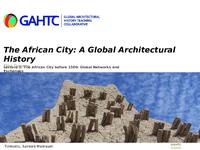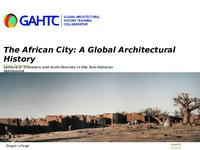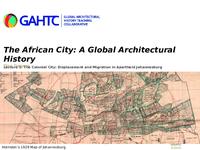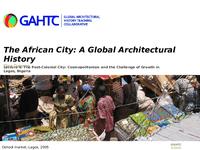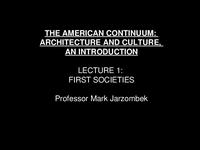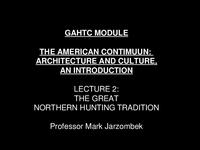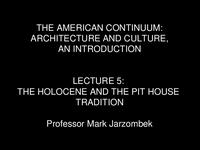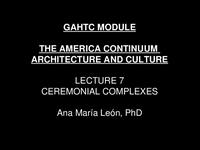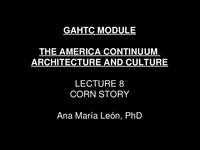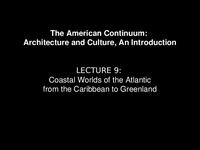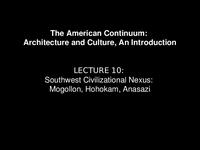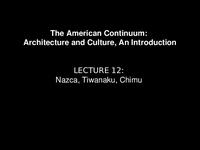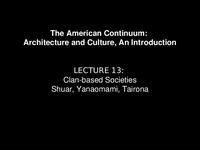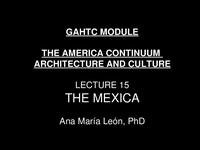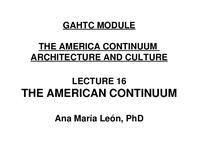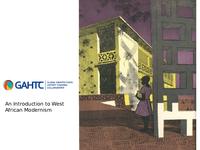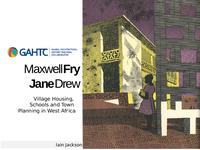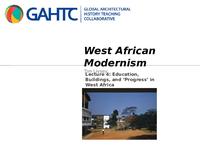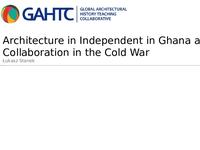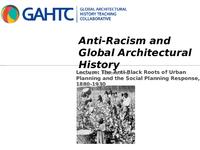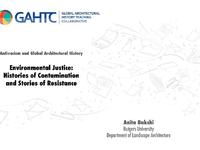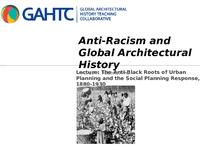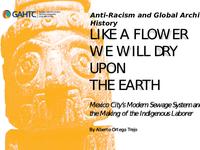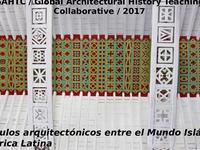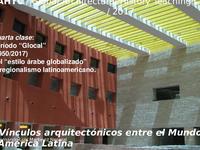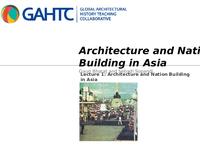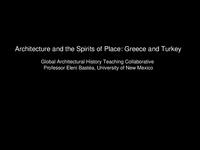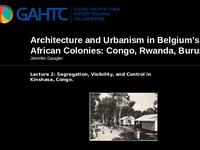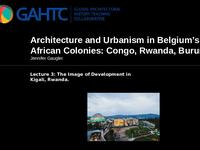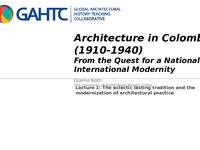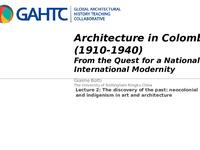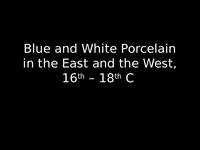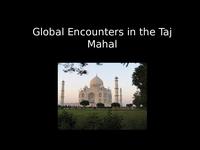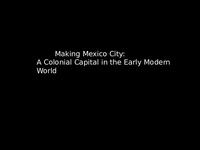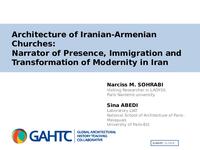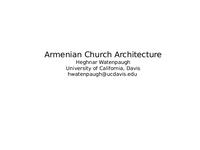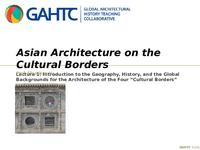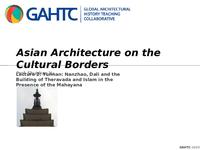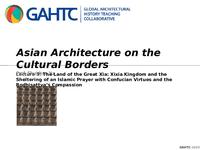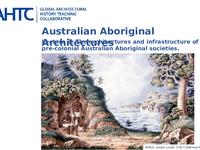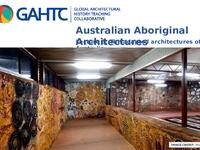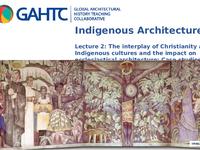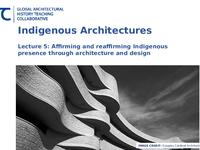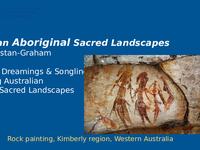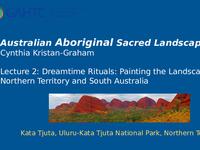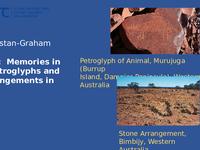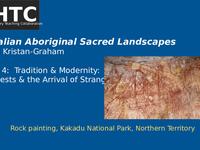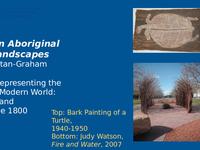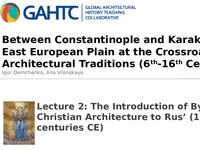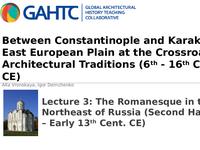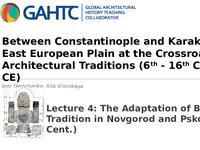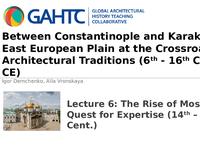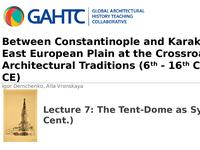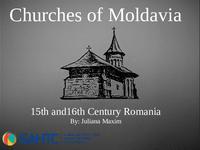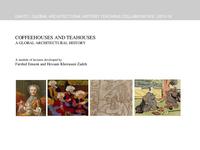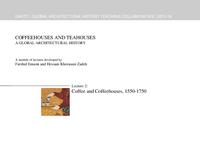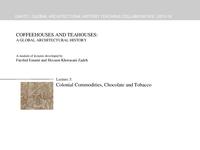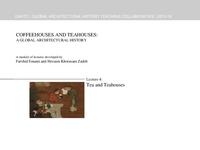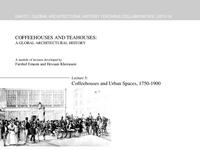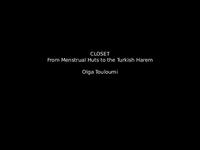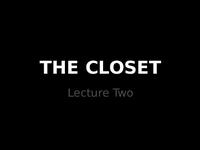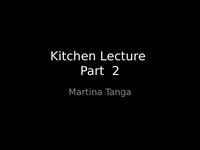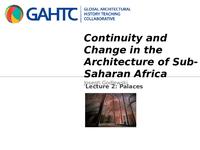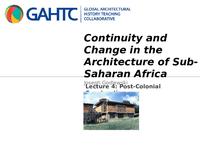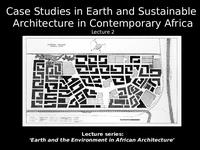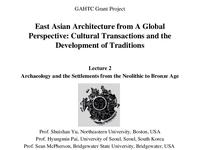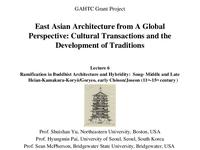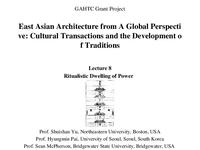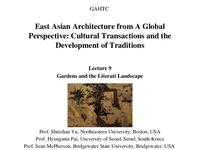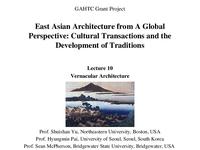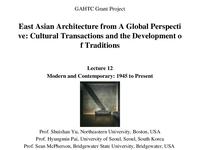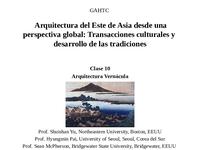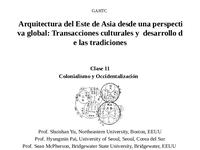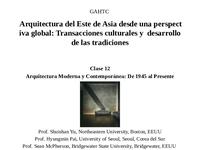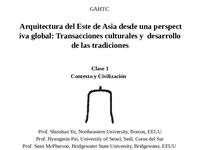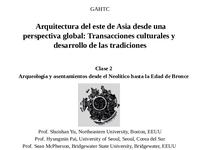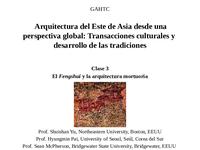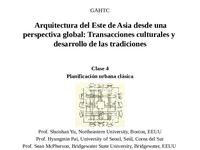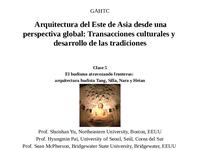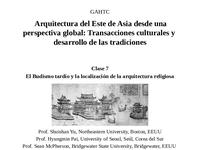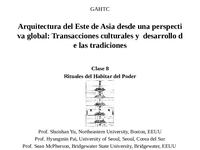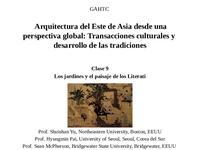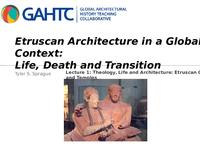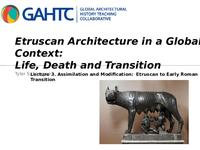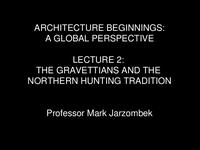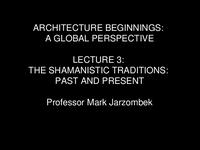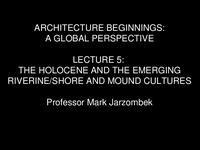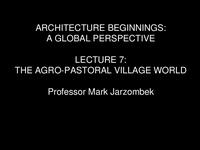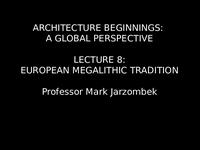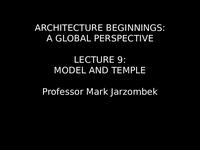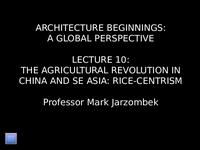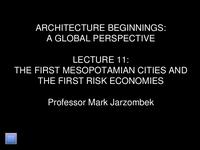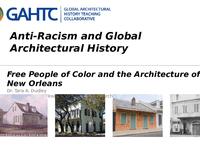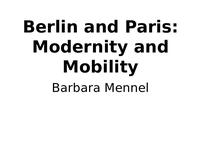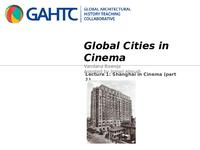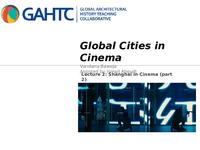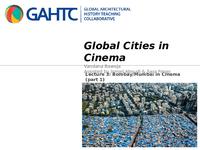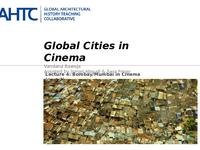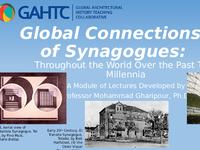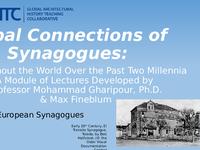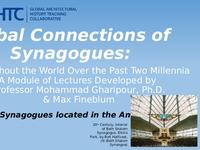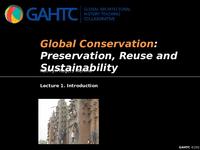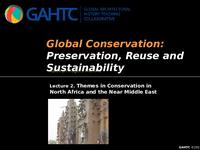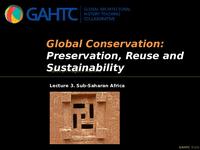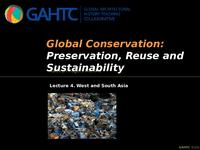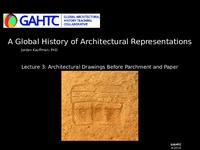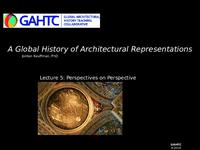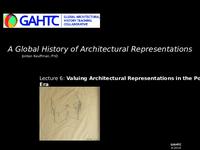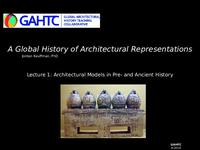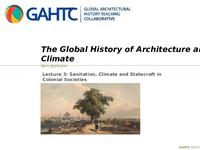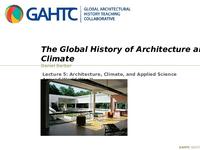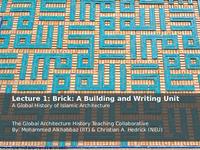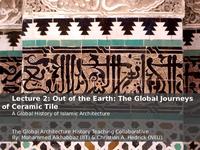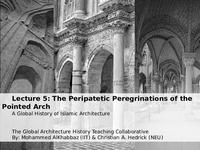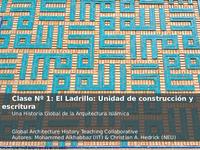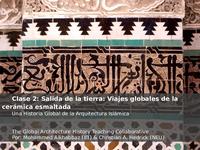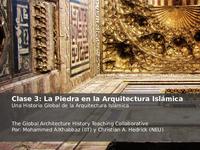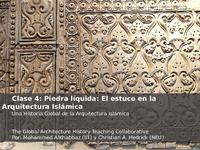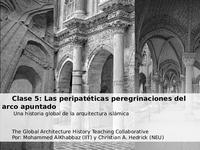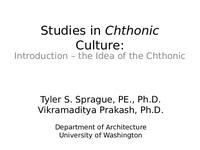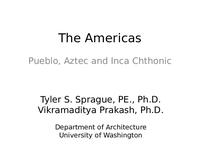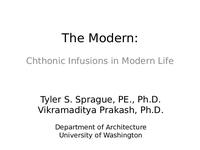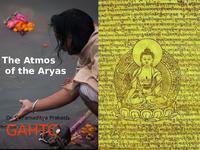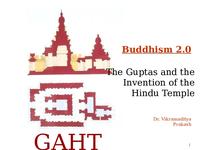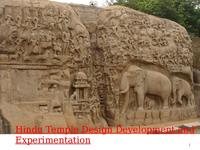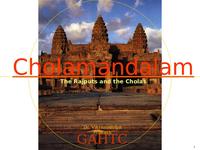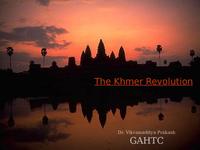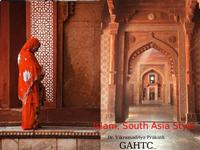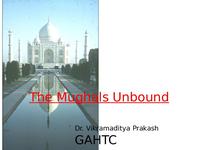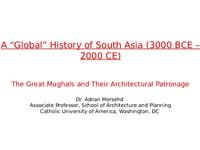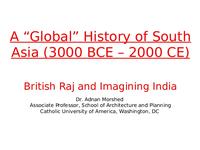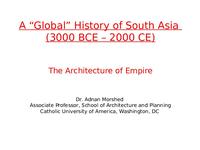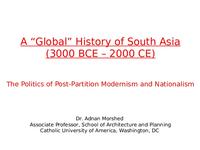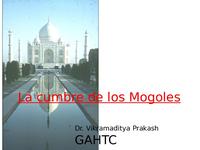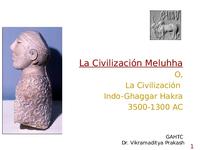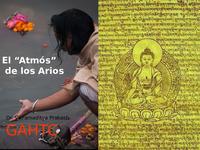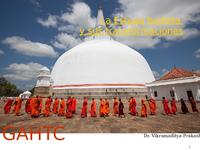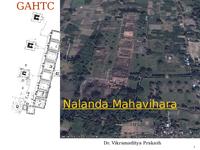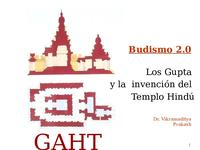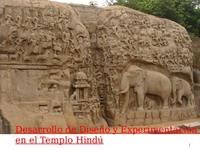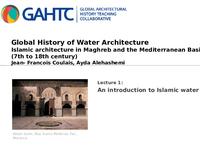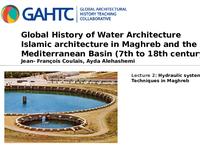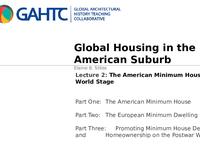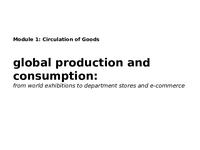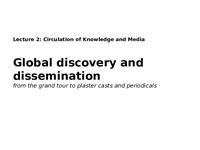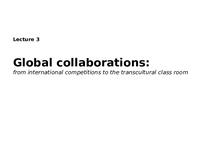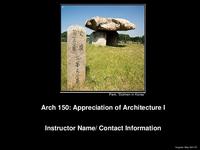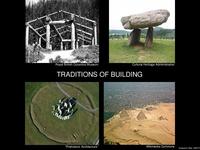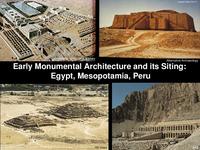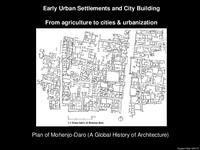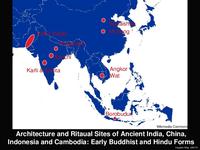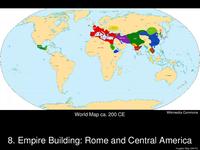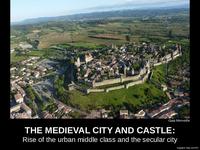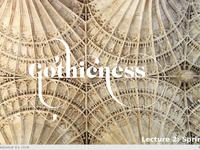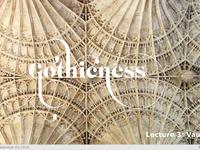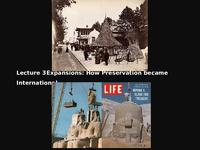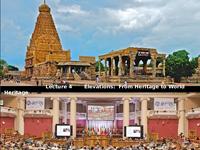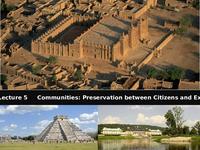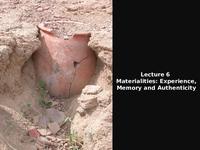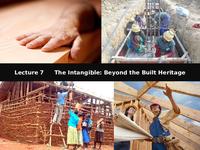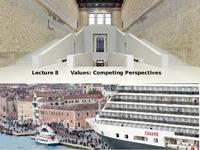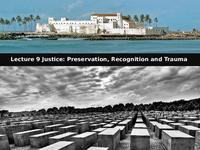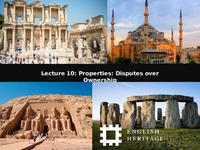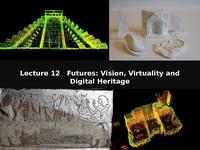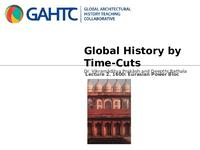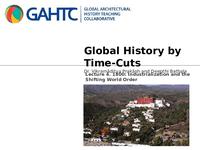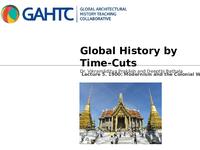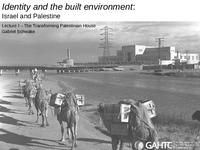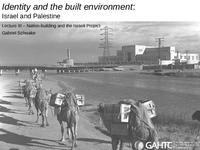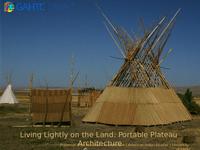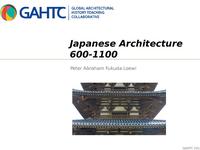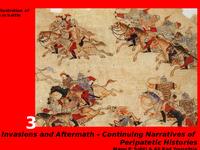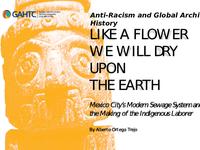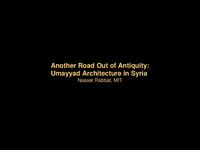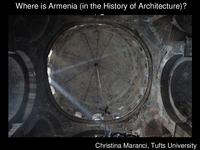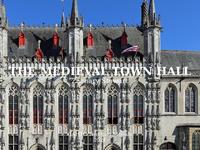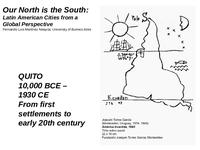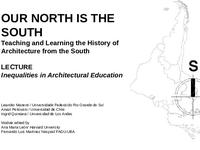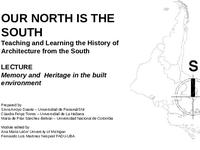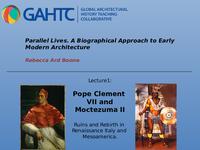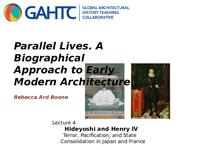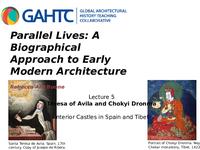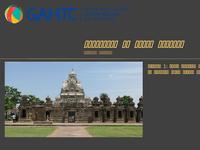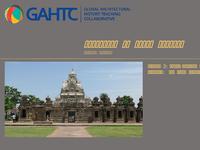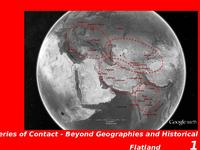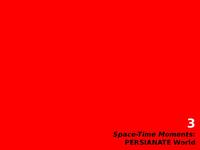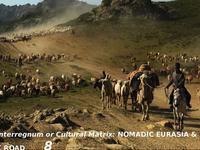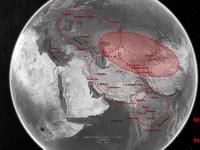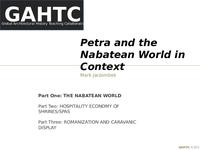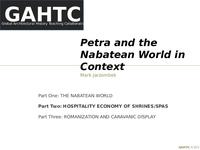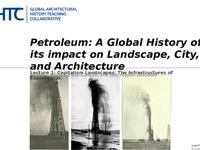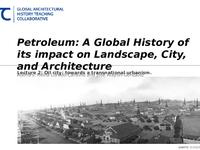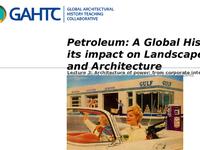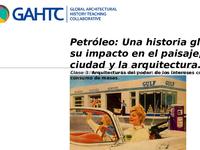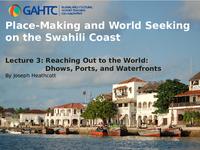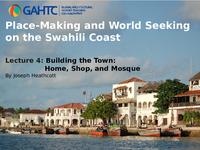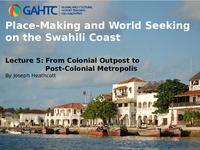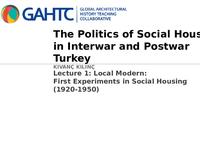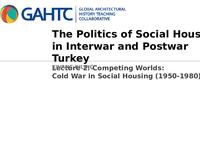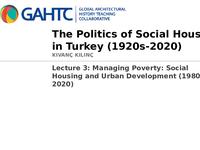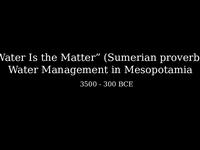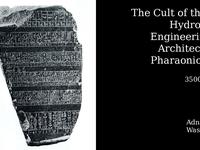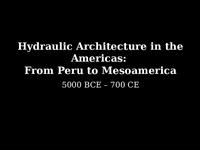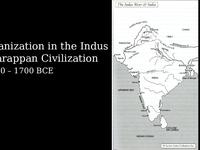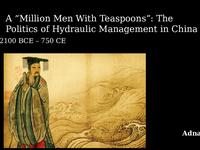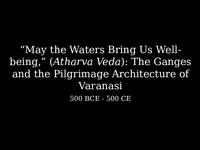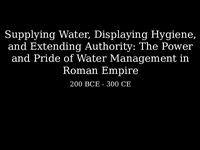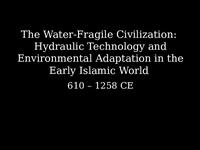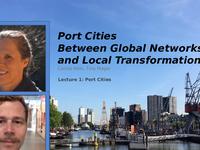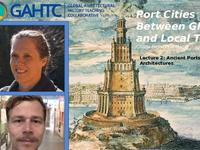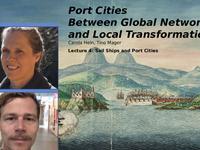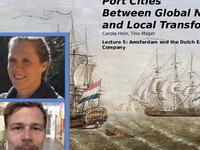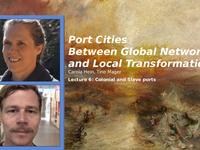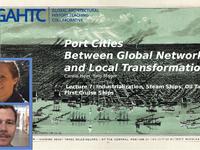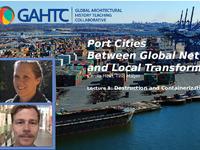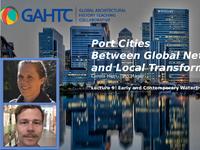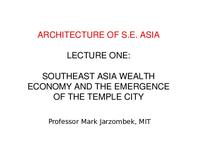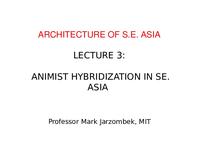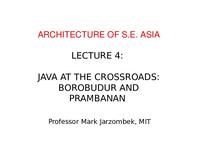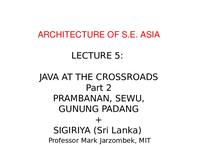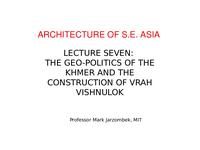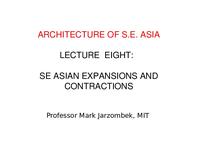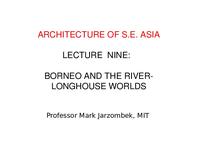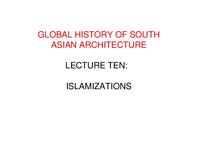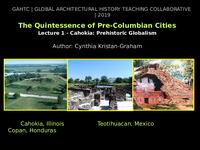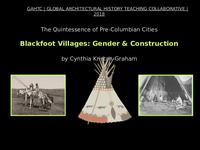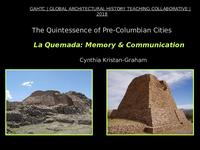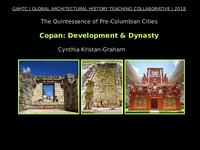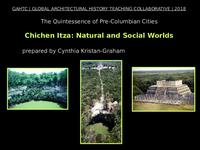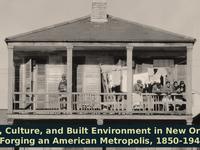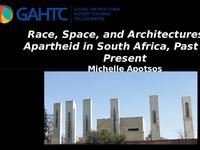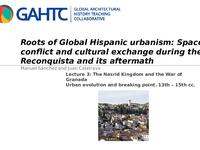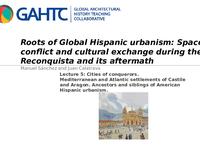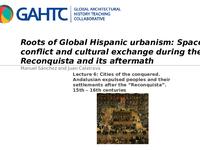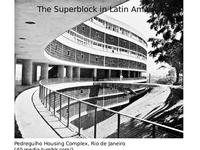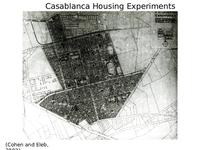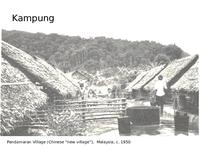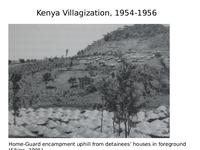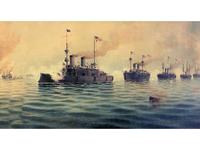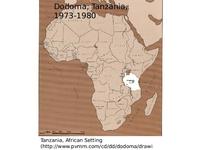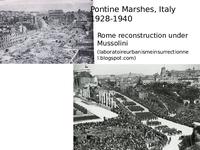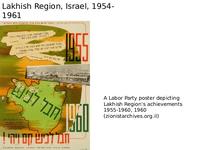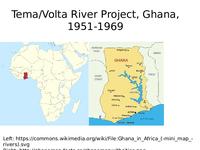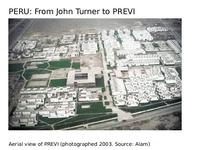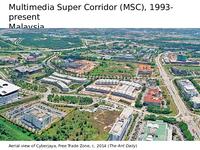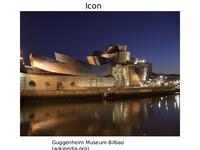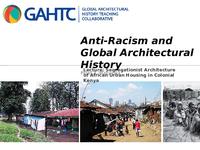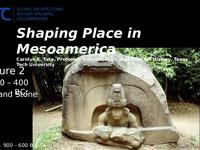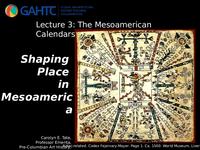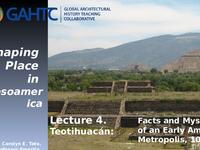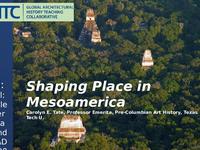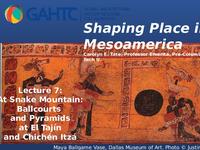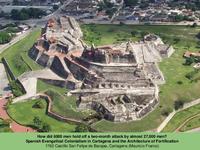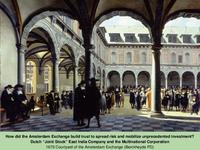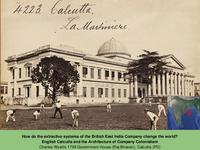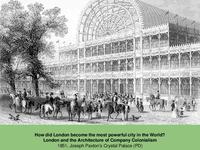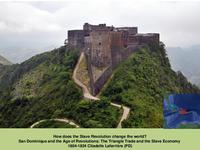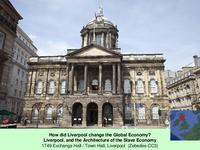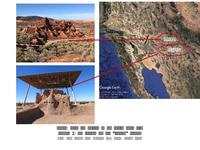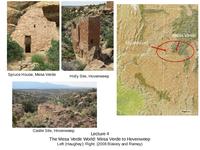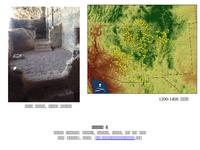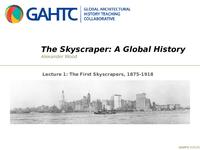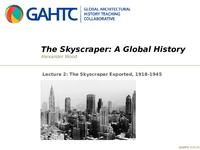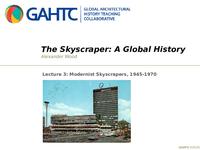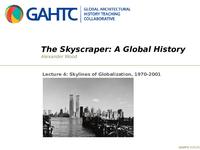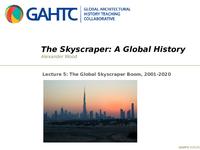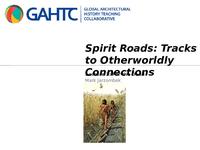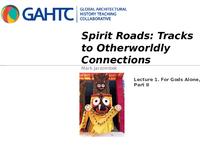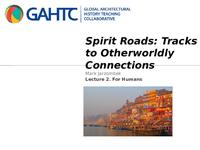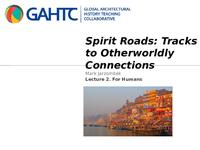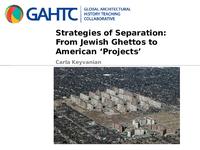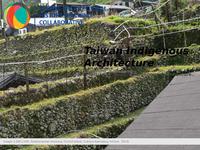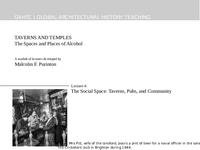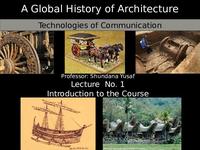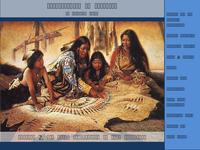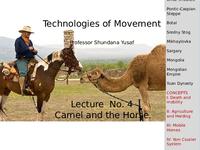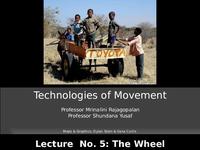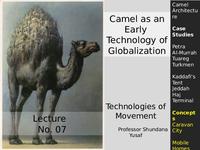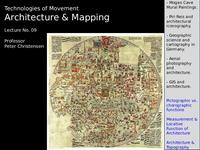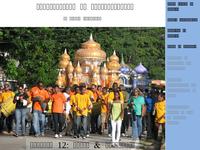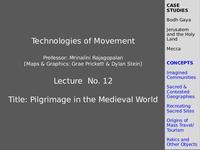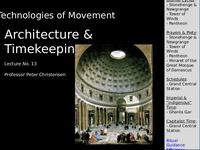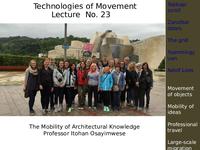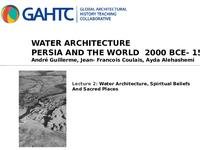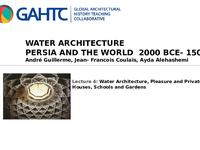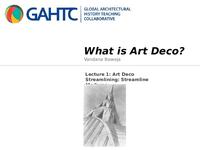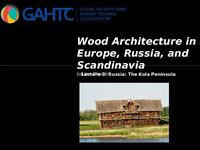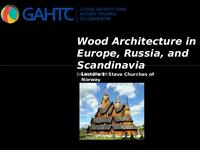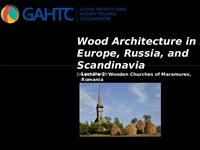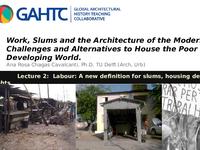featured modules
all modules
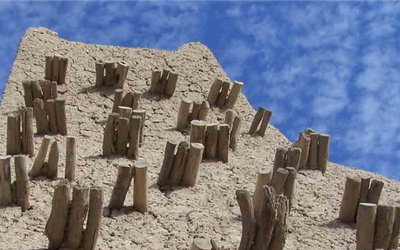
This module will consist four introductory lectures investigating the global architectural history of the city in sub-Saharan Africa from the twelfth century onward. The goal of the module will be to enable teachers of architecture and art history to present this material in a conceptually rich and globally situated manner. The course material would fit in a survey of architecture 1100 to the present day. This module investigates global architectural history, postcolonial… continue reading
This first lecture introduces the broad theme of sub-Saharan cities and settlements in the pre-1500 world. In order to deconstruct the widespread misconceptions about the absence of significant sub-Saharan cities before the arrival of the European colonizers in the continent, we will introduce and analyze three different examples of sub-Saharan settlements and their architecture. We will discuss how cities such as Kilwa, Benin, Great Zimbabwe, and M’banza Kongo became the ce…
supporting documents: • Handout • Quiz with Answers
This lecture tracks multiple travel experiences of architects, artists, and scientists who crossed the Sahara from the 1850s to the twentieth century. It examines the itinerary of their trips, their drawings, and the photographic and filmed materials collected during their trips with a particular attention for the architectural and urban realm. Focus of our study will be the ginna, the Dogon main house, the compound of the Dogon village, the teleuk, or Mousgoum hut, and the …
supporting documents: • Handout • Quiz with Answers
In looking at Johannesburg, South Africa, this lecture introduces three different waves of people migrating to and within the city from the gold boom of the 1880s to present time. This will allow us to discuss the topics of labor control, forced migration and displacement, focusing on the places of resistance to apartheid. In the first part of the lecture, we will discuss the process of colonization, soil exploitation and the scramble for resources in the Transvaal colony (a…
supporting documents: • Handout • Quiz with Answers
In looking at the work of artists such as Yinka Shonibare, a British-Nigerian artist living in the United Kingdom, and the brightly colored Dutch wax fabric he uses in his artwork, we will explore the concept of transoceanic exchanges, cosmopolitanism and hybridization within the contemporary challenging growth at work in Lagos, Nigeria. We will discuss Lagos as a global place of encounter and negotiation among traditions since the foundation of Lagos Island and its later pe…
supporting documents: • Handout • Quiz with Answers
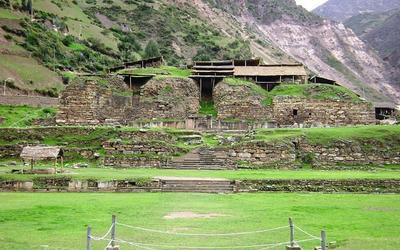
American architecture prior to the arrival of Europeans receives scant attention in survey courses of the Americas. To remedy this, this course considers the history of architecture and urban planning in the Americas before the European arrival. It is developed as a half semester supplement limited to 15 lectures. The intention is that GAHTC members can utilize the entire half semester program to develop a balanced course on the architectural traditions of architecture in Am… continue reading
Jordan Kauffman, Mark Jarzombek, Ana María León
supporting documents: • Bibliography • Syllabus
This lecture introduces what I call the “Social Package” that travelled from Africa from around 60,000 BCE throughout the entire globe. Traditionally, the emphasis has been on tools and weapons; here I want to emphasize the integration of tools with art making, hut making, and dance. The tendency in the scholarship has been to see these things as separate and to focus on ‘firsts.’ The point I want to make in this lecture is to focus on the time when the various elements of s…
supporting documents: • Handout • Quiz with Answers • Lecture Notes
In the last lecture, I introduced the idea of the “Social Package” that made us modern humans, from 150,000 or 200,000 BC through today. There is a lot more than can be said, but the lecture was intended to give the rudiments of a more elaborate discussion. This lecture moves the clock forward to the period called the Last Ice Age (ca. 24,000 BCE – 10,000 BCE). Though the world was uniformly colder than before, it was coldest in Europe, Russia, Siberia and Canada, which w…
supporting documents: • Lecture Notes • Handout • Quiz with Answers
Shamanism is a generic term that describes a broad set of ritual beliefs about the human relationship to other humans and nature. It is linked also to Animism. This lecture introduces the broad parameters of shamanism while also trying to get students to realize that shamanism is not a ‘dead religion.’ In the last few decades, it has even been revived – just think of the so-called neo-pagans who flock to Stonehenge! So what we see today in some parts of the world is a mixtu…
supporting documents: • Handout • Quiz with Answers • Lecture Notes
The Lecture is about the modern world. Shamanistic world views are not dead, but alive and well especially in Asia, but also Africa. To understand this, one has to take off the monotheistic blinders. Animism was incorporated into the core principles of Buddhism, Hinduism, Taoism and is most present in Shintoism. We start therefore with the THE BI-CAMERAL THESIS, as coined by by Julian Jaynes. The idea is to get students to see an alternative way of describing the world. T…
supporting documents: • Handout • Quiz with Answers • Lecture Notes
It is often argued that the Holocene set the stage for agriculture. This lecture starts from this premise, and demonstrates that the Holocene also set the stage for an expansion of First Society cultures. By 3,000 BCE, around the time we see the first cities in Mesopotamia, we see extensive First Society cultures developing in areas of particularly rich and diverse flora and fauna. The most notable of these was the emergence of fish-based and ocean-shore societies that …
supporting documents: • Handout • Quiz with Answers • Lecture Notes
This lecture studies the emergence of the mound and plaza cultures beginning around 3,000 BCE in the lower Mississippi River area. It discusses Poverty Point and brings the student up to the Hopewell Culture in Ohio, a culture that thrived almost exclusively on the ceremonial exchanges. We then focus on northern Peru. First will be the site of la Galgada, an early ceremonial center where irrigation systems were first developed in this area. We then move to the cultures of th…
supporting documents: • Lecture Notes • Handout • Quiz with Answers
This lecture discusses the development of large ceremonial complexes in which the buildings play an active role as part of the ceremony. Some parts of these ceremonies involved large numbers of people and took place in outdoor spaces. Others were meant to be experienced individually in introspective ways, in underground, labyrinthine passageways. Scale, sound, and varying degrees of light and darkness contributed to enhance these experiences and punctuate them with culminati…
supporting documents: • Handout • Lecture Notes • Quiz with Answers
This lecture tracks a long history of the rise of corn in the development of the Americas. We discuss the genetic development of teosinte into corn and its impact in the architecture and culture of Mesoamerica and North America. We follow the repercussions of corn centrism in the rise of the Olmecs and their colonization of the marshes in San Lorenzo and La Venta. We then skip forward to 200 CE to see the fulfillment of this food’s promise in the architecture of the Maya…
supporting documents: • Handout • Quiz with Answers • Lecture Notes
During this lecture we will be looking at areas that are quite frequently left out of the narrative on architecture in the Americas. We will be looking at a series of Coastal sites along the Atlantic coast from the Caribbean to Canada and into Greenland. And we will look at each other these places through time as well. So we will be travelling temporally and geographically throughout this class.
supporting documents: • Handout • Quiz with Answers • Lecture Notes
This lecture and the next will look at the developments in the present southwestern United States and northern Mexico prior to c.1100CE. This includes the Mogollon, the Hohokam, and the Anasazi. This lecture in particular will look at the Mogollon development of the kiva, space geared ceremonially around corn; Hohokam sites at Snaketown, where a large irrigation system was developed to support agriculture; Anasazi villages on Black Mesa; the interstitial site of Chaco Canyon…
supporting documents: • Handout • Quiz with Answers • Lecture Notes
Mounds were by the far the most numerous architectural imposition in the landscape designed and constructed by the native populations in the present United States. These mounds developed in a number of ways, which this lecture makes evident. But in every case, they became ceremonial and ritual spaces important in the structuring the societies that built them. This lecture discusses the large cultures of the U.S. Southeast, starting with an extended discussion on the Cahokia,…
supporting documents: • Handout • Quiz with Answers • Lecture Notes
This lecture discusses three interrelated, pre-Inca societies: the the Nazca, the Tiwanaku, and the Chimú on western coasts of Peru, Bolivia, and northern Chile. It will discuss the geoglyphs and underground aqueducts of the Nazca, the cosmographic city of Tiwanaku, and The Chimor Empire’s capital city Chan-Chan, an administrative capital that at its peak held an estimated 40-60,000 people.
supporting documents: • Handout • Quiz with Answers • Lecture Notes
This lecture expands on the oftenforgotten existing cultures of the Amazon basin, including the Shuar in Ecuador, the Yanomami in Brazil, and the Tairona in Colombia. It looks at their culture and their architecture such as the Shuar Huts, the unique shabono of the Yanomami, and the network village of Teyuna in Colombia. The sophisticated networks and tectonic structures of these villages has been dismissed because of its fragile status in comparison to the stone structures…
supporting documents: • Handout • Quiz with Answers • Lecture Notes
This lecture discusses the interrelation of material and beliefs in the architecture and culture of the Inka Empire, which we should properly call by its name, the Tahuantinsuyo. We will start first with their coastal neighbors, the Chimu, and their adobe city of Chan Chán. The tall walls of Chan Chán were intricately carved and remind us the presence of multiple cultures throughout the western coast of South America. They were eventually subsumed by the Inkas, whose po…
supporting documents: • Handout • Quiz with Answers • Lecture Notes
This lecture examines two cities, both capitals of empires in Central Mexico: the monumental city of Tula, capital of the Toltec, and the floating city of Tenochtitlan, capital of the Mexica. With the Toltec and Mexica we arrive to hierarchical societies in which monumental core buildings speak to the power of the rulers and elites. In Tenochtitlán, the ceremonial center is set apart from the common folk as they literally float around in artificial islands called chinampas. …
supporting documents: • Handout • Quiz with Answers • Lecture Notes
This lecture looks at the continuing presence of the culture, buildings, and peoples of the Americas within the continent from the moment of conquest, throughout the repeated attempts at erasure, and in the present. We start with the moment of encounter and conquest, with the arrival of the Spanish to Tenochtitlán and examine the ruins of the city lying beneath contemporary Mexico City. We then go to Cusco and to the multiple layers within the Coricancha or temple of the …
supporting documents: • Handout • Quiz with Answers • Lecture Notes
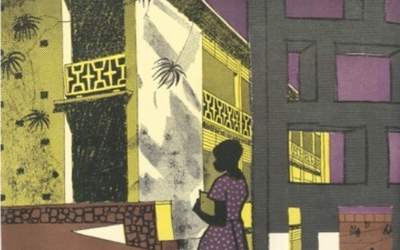
There remains a dearth of UG-focused, accessible material on non-vernacular African Architecture. A number of authors have now produced research papers and books covering various aspects of colonial and post-colonial architecture with a specific African focus or coverage of the region. In the continued absence of an African architecture survey primer, the GAHTC Introduction to West African Modernism series of lectures seeks to help fill this lacuna in its production of a reg… continue reading
This lecture seeks to introduce and set the background to the set of lectures on West African Modernism. It does this by first of all dealing with definitions and a short introduction to the literature related to modernism, the tropics and the key associated theories most cited. Issues such as geographies, regionalism, and actor networks are some areas which are also discussed. The lecture concludes by suggesting ways through which students might want to review the first set…
supporting documents: • Bibliography • Handout • Lecture Notes • Questions and Assignments
This lecture focuses on the work of two architects, Edwin Maxwell Fry and Jane Beverly Drew, who worked extensively in the UK, India and Africa throughout the mid-20thC. Their pioneering work attempted to develop a ‘modernism’ for the ‘tropics’, and one an architecture that responded to social, political and aesthetic concerns. Jackson delivers a critical analysis of Fry and Drew’s body of work in West Africa and situates this within the broader themes of their engagement wi…
supporting documents: • Handout • Lecture Notes • Bibliography • Quiz with Answers
The architects James Cubitt and Kenneth Scott, arguably were amongst the most powerful actors in the post WW2 the architecture scene in West Africa. Despite the partnership being relatively short lived both architects developed a joint approach best understood in their development of the KNUST campus in Kumasi, that helped underpin their future design activities in West Africa. This lecture discusses their joint development of the KNUST campus in Kumasi, Ghana and the subseq…
supporting documents: • Lecture Notes • Quiz with Answers • Bibliography • Handout
This lecture relates university architecture in Anglophone West Africa to development and decolonisation politics. Development and decolonisation were central issues in mid twentieth century West Africa, and informed the activities of both architects and their critics. The lecture charts the rise and fall of an era in which ideas about university architecture, African liberation, and development were tightly intertwined. It starts in the 1930s, when nationalists demanded th…
supporting documents: • Lecture Notes • Handout • Quiz with Answers
This lecture focuses on the shift of West African architecture and urban design from the colonial to the postcolonial periods, in particular in Ghana (independent since 1957) and Nigeria (independent since 1960). Specifically, this lecture will show the change of programs (broad distribution of housing and health, culture, education provision); technologies (emergence of local construction material industries and their modernization); education (emergence of new architectura…
supporting documents: • Handout • Quiz with Answers
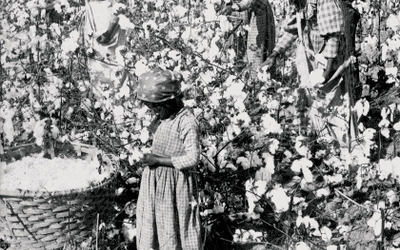
This lecture examines issues of power and place through the prism of race in urban and rural cultural landscapes, primarily between 1880-1930. From the Reconstruction Era through the beginning of the Depression, the United States saw unprecedented demographic shifts, which caused new questions about race, place, and identity to emerge in planning. Students of this period in architecture and planning might ask if a gendered, racial, or class-based approach to planning origina… continue reading
This lecture examines issues of power and place through the prism of race in urban and rural cultural landscapes, primarily between 1880-1930. From the Reconstruction Era through the beginning of the Depression, the United States saw unprecedented demographic shifts, which caused new questions about race, place, and identity to emerge in planning. Students of this period in architecture and planning might ask if a gendered, racial, or class-based approach to planning origina…
supporting documents: • Handout • Quiz with Answers

This Module is the product of a special call for lectures on the topic of Anti-Racism and Global Architectural History - July 2020 GAHTC stands in solidarity with ongoing protests for racial justice and against the murder of Black and Indigenous peoples now and throughout history in the name of white supremacy. For too long, architectural history has been complicit with this violence by contributing to a false narrative of Eurocentrism and Western superiority. As an organ… continue reading
Peter Makachia, Kathleen James-Chakraborty, Anita Bakshi, Andrea Roberts, Alberto Ortega Trejo, Armaghan Ziaee, Carla Keyvanian, Tara A. Dudley
supporting documents:
Starting at the scale of infrastructure, policy, and land acquisition, this lecture examines how the groundwork has been laid for ongoing exploitation and slow violence against communities of color in the United States. It explores the impacts of industrial pollution and contamination by highlighting the connections between the built environment and public health in light of the history of industrial zoning. Acknowledging the connections between race and contaminated envi…
supporting documents: • Handout • Lecture Notes • Bibliography • Quiz with Answers • Questions and Assignments
American architectural history often ignores or glosses over Black architects and their contributions. Yet, prior to the advent of formal architectural education, which in its infancy offered little opportunity for Blacks to participate, large numbers of Black men prospered in the building trades. Louisiana’s gens de couleur libres or free people of color offer a previously unexplored but essential case study. These men and women contributed to the built world of Louisiana …
supporting documents: • Handout • Lecture Notes • Quiz with Answers
Named for the editor of the Pittsburgh Courier, one of mid-century America’s leading African American newspapers, the Robert L. Vann Tower of the Belgian Friendship Building rises substantially higher than any of the Confederate statues on Richmond, Virginia’s nearly Monument Avenue ever did. Although prominent on the city’s skyline, the Belgian Friendship Building has been overlooked in histories of the importation of European modern architecture into the United States, a…
supporting documents: • Lecture Notes • Handout • Quiz with Answers
Nairobi, Kenya was the location of urban housing for Africans that demonstrated the racist segregationist colonial strategies meant to ingrain inferiority of the native populations. The lecture espouses the spatial strategies manifested in the architecture and strategies of urban housing estates that defined the architecture of Eastlands, a city-reserve for the race, in the era of British suzerain rule of early to mid-20th Century. Framed in Foucauldian theorem of panoptical…
supporting documents: • Handout • Quiz with Answers • Lecture Notes
This lecture examines issues of power and place through the prism of race in urban and rural cultural landscapes, primarily between 1880-1930. From the Reconstruction Era through the beginning of the Depression, the United States saw unprecedented demographic shifts which caused new questions about race, place, and identity to emerge in planning. Students of this period in architecture and planning might ask if a gendered, racial, or class-based approach to planning originat…
supporting documents: • Quiz with Answers • Handout • Lecture Notes
This lecture examines the double marginalization of African American women in relation to their position as architects and their partnership in the design of the built environment in the U.S. and globally. More specifically, it unveils the absence of their representation through the study of twentieth-century architecture, as this period coincides with African American female architects’ entry into the field. The lecture approach is intersectional as discussing the role of r…
supporting documents: • Handout • Lecture Notes • Quiz with Answers
Cities across the globe are marked by segregation. Modern cities are formed by a patchwork of quarters each distinguished by economic or racial uniformity. We are so accustomed to this modern urban phenomenon as to take it for granted. In reality, urban segregation started with early modernity because of a serious of concerted efforts and specific policies. It is important for students to understand that the specific urban configuration of cities did not happen ‘natural…
supporting documents: • Handout • Lecture Notes • Quiz with Answers
This lecture looks at the making of the modern sewage system of Mexico City in a non-linear way. By doing this, we aim to look at each moment and place in this history within its own frameworks, acknowledging them as historical constructs while at the same time studying them within their own set of parameters and ideas. By doing so, we claim that in the making of this infrastructures, architectures, events, and their circulation in the media, the sewage sys-tem became a medi…
supporting documents: • Bibliography • Handout • Lecture Notes • Quiz with Answers

Imaginaries about Latin America place it at a considerable distance from the Islamic World. Languages, religions and cultural paradigms lead us to associate Latin America either with the Occident, the pre-Columbian or, in some countries, with the Afro culture. We rarely imagine links with the Islamic World. But, surprisingly, there are many connections between both cultures. First, because of Spanish Mudejar or Moorish heritage and then as a consequence of the Arab immigr… continue reading
Lecture Abstract: Imaginaries about Latin America place it at a considerable distance from the Islamic World. Languages, religions and cultural paradigms lead us to associate Latin America either with the Occident, the pre-Columbian or, in some countries, with the Afro culture. We rarely imagine links with the Islamic World. But, surprisingly, there are many connections between both cultures. First, because of Spanish Mudejar or Moorish heritage and then as a consequence of …
supporting documents: • Handout • Quiz with Answers • Lecture Notes
Lecture Abstract: Imaginaries about Latin America place it at a considerable distance from the Islamic World. Languages, religions and cultural paradigms lead us to associate Latin America either with the Occident, the pre-Columbian or, in some countries, with the Afro culture. We rarely imagine links with the Islamic World. But, surprisingly, there are many connections between both cultures. First, because of Spanish Mudejar or Moorish heritage and then as a consequence of …
supporting documents: • Handout • Quiz with Answers • Lecture Notes
Lecture Abstract: Almost all Latin American countries, declared their independence in the first half of nineteenth century. From that moment, these young American nations, ruled by elites of enlightened “Criollos”, began to look to European countries as models (especially France, England and Germany). Together with these new models, many European fashions and tastes came into Latin America, which had a huge impact on customs, arts and, of course, architecture (particularly…
supporting documents: • Handout • Quiz with Answers • Lecture Notes
Lecture Abstract: In the recent context of globalization, in Latin America many architectural complexes emerged, which were conceived for spreading the Islamic culture. They are based on prismatic volumes with a decorative incorporation of traditional Islamic shapes, like arcs, domes and minarets. Because their monumental scale and privileged locations, these buildings have a significant urban impact in our cities, reinforced by their singular shapes that combines horseshoe…
supporting documents: • Handout • Quiz with Answers • Lecture Notes

Los imaginarios sobre América Latina la ubican a una considerable distancia del Mundo islámico. Lenguajes, religiones y paradigmas culturales nos permiten asociar a América Latina con Occidente, lo Pre-Colombino o, en algunos países, con la cultura Afro. Raramente imaginamos vínculos con el Mundo Islámico. Pero, sorprendentemente, existen muchas conexiones entre ambas culturas. Primero, por la herencia Mudéjar y Morisca Española y luego, como consecuencia de los inmigrantes … continue reading
Los imaginarios sobre América Latina la ubican a una considerable distancia del Mundo islámico. Lenguajes, religiones y paradigmas culturales nos permiten asociar a América Latina con Occidente, lo Pre-Colombino o, en algunos países, con la cultura Afro. Raramente imaginamos vínculos con el Mundo Islámico. Pero, sorprendentemente, existen muchas conexiones entre ambas culturas. Primero, por la herencia Mudéjar y Morisca Española y luego, como consecuencia de los inmigrantes …
supporting documents: • Lecture Notes • Quiz with Answers • Handout
El principal tema en este período es la continuidad de características islámicas en la cultura de las colonias españolas. Podemos encontrar en las sociedades hispánicas de los siglos XVI al XVIII muchos rasgos de la España Medieval Islámica. Cuando los españoles vinieron a América, trajeron su experiencia y conocimientos del legado hispano-islámica a este continente. Este tipo de cultura es conocida como Mudéjar Iberoamericano. (Desde el siglo XIX, el arte Hispano-Arabe post…
supporting documents: • Lecture Notes • Quiz with Answers • Handout
Casi todos los países latinoamericanos declararon sus independencias en la primera mitad del siglo XIX. Desde ese momento, aquellas jóvenes naciones americanas, gobernadas por criollos ilustrados, comenzaron a mirar a los países europeos como modelos (especialmente Francia, Inglaterra y Alemania) Varios intelectuales y gobernantes de la región viajaron a Europa para aprender las nuevas propuestas que la ciencia y el arte podían ofrecer con el objetivo de contribuir al d…
supporting documents: • Lecture Notes • Quiz with Answers • Handout
Clase 4. Período “Glocal” (1950/2017) del “estilo árabe globalizado” al regionalismo latinoamericano
En el contexto reciente de la globalización, emergieron en Latinoamérica varios complejos arquitectónicos concebidos para difundir la cultura y religión islámica. Estos edificios son financiados por los ricos países petroleros del Golfo Pérsico con el objetivo de proveer una mejor infraestructura a los musulmanes de la región y a la vez, promover el crecimiento de la religión en el área. Frecuentemente son encargados a estudios de arquitectura del Mundo Islámico, u otros…
supporting documents: • Lecture Notes • Quiz with Answers • Handout

This lecture explores the ways in which architecture and built environments are used as a medium for social and political agenda, particularly in the Asian context. Since the 19th century, modern Asian nation state formation has encompassed a variety of processes, viz. the consolidation of monarchical centers, the dissolution of European colonial powers, democratization, modernization, and the engagement with international diplomacies. Architectural projects have been an imp… continue reading
This lecture explores the ways in which architecture and built environments are used as a medium for social and political agenda, particularly in the Asian context. Since the 19th century, modern Asian nation state formation has encompassed a variety of processes, viz. the consolidation of monarchical centers, the dissolution of European colonial powers, democratization, modernization, and the engagement with international diplomacies. Architectural projects have been an imp…
supporting documents: • Handout • Lecture Notes • Quiz with Answers

This lecture examines the general concepts and principles of “the spirit of place” and “critical regionalism”. It looks at a few representative examples of architecture from different parts of the world through the lenses of “the spirit of place” and “critical regionalism.” We will then turn our attention to examples of modern architecture in Greece and Turkey. The lecture compares the work of architects Sedad Eldem (from Turkey) and Dimitris Pikionis (from Greece). Finally,… continue reading
First, we will examine the general concepts and principles of “the spirit of place” and “critical regionalism” Next, we will look at a few representative examples of architecture from different parts of the world through the lenses of “the spirit of place” and “critical regionalism.” We will then turn our attention to examples of modern architecture in Greece and Turkey. We will compare the work of architects Sedad Eldem (from Turkey) and Dimitris Pikionis (from Greece) Fina…
supporting documents: • Quiz with Answers • Handout • Lecture Notes

This course module focuses on the architecture and urbanism of the Democratic Republic of the Congo, Burundi, and Rwanda. The historical narratives of these three countries, which once comprised the Belgian colonies of Belgian Congo and Ruanda-Urundi, both align with and yet also differ from other African and postcolonial histories. The introductory lecture grounds the module in an exploration of Belgium’s colonial urban policy. Like other African cities, the capitals of… continue reading
This lecture provides an overview of Belgium’s colonial anti-urbanization policies for its African colonies. The cities of Kinshasa, Bujumbura, and Kigali (the present-day capitals of the Democratic Republic of Congo, Burundi, and Rwanda, respectively) were all molded by Belgian policies. However, Belgium differed from many other colonial powers in that it did not establish grand imperial cities in Africa. In fact, Belgium often followed “anti-urbanization” policies that wer…
supporting documents: • Handout • Lecture Notes • Quiz with Answers
In one century, Kinshasa, the capital of the Democratic Republic of Congo, developed from a small trading outpost to a metropolis of millions of people. Throughout the course of Kinshasa’s development, parameters of visibility and invisibility have been paramount in shaping urban life for the residents of Kinshasa. In the colonial era, the Belgian authorities used the visibility of the colonized as a tool of social control, and visibility of the colonizers as an expression o…
supporting documents: • Handout • Quiz with Answers • Lecture Notes
This lecture will look at the historical development of Kigali, beginning from its founding as a German outpost in 1907. It will trace Kigali’s subsequent development as a Belgian colonial administrative center, and then its transformation into the capital city of an independent nation. It will also look at how some historical sites in Rwanda have been transformed into sites for tourist consumption, as certain building materials or forms become coded as “traditional,” while …
supporting documents: • Handout • Lecture Notes • Quiz with Answers
Architecture in Colombia (1910-1940): From the Quest for a National Style to International Modernity

This module delves into Colombian history of architecture during the first half of the 20th century by investigating the relationship between the country’s modernization and the process of nation building. The first lecture focuses on the modernization of the architectural practice by highlighting how eclectic architecture not only defined a new, bourgeoise, scenography for Colombian cities but also featured important technological innovations. Then, it explores the architec… continue reading
This lecture introduces the long-lasting eclectic tradition of architecture in Colombia and the modernization of the architectural practice in the first decades of the 20th century. It firstly displays the contribution of foreign and Colombian (often educated abroad) architects and engineers in the production of eclectic buildings based on imported models, which defined a new, bourgeoise, scenography gradually replacing colonial buildings in central urban areas. Then, it foc…
supporting documents: • Handout • Quiz with Answers
This lecture displays the architectural production resulting from the first reflections on the problem of national identity in Colombia. Like in many other Latin American countries, Colombian architects and engineers started looking at their past, namely at the Spanish-colonial tradition, as source for a national architecture. As a result, from the 1920s several typologies were designed by both Colombian and foreign professionals, mostly US American, in a wide range of Spani…
supporting documents: • Handout • Quiz with Answers

Each lecture focuses on the overarching theme of how global modernity was made through specific moments of intercultural “encounter” (including war and colonization). ‘Local’ cultural production, aesthetics, and art making traditions should always be linked to larger geopolitical transformations. Key will be to explain how societies transformed each other in the context of the rise of capitalist globalization and how this “encounter” catalyzed a new way of being in the world… continue reading
Kenny Cupers, Chanchal Dadlani, Nancy Um, Prita Meier, Dana Leibsohn
supporting documents: • Syllabus
This module explores the transformation of Asian trade networks and societies following the Mongol conquests in the 13th century. We focus on the circulation of architectural and artistic forms along the ancient Silk Route and the spread of Buddhism in Southeast Asia and the Himalayas. We explore the cultural connections of Ming China, its tension between dynastic authority and the increasingly powerful merchant class; the rise of the Ottoman, Timurid, Safavid, and Mughal em…
supporting documents: • Handout • Keywords • Lecture Notes • Readings
This lecture, along with the two other lectures that it is associated with, uses certain eastern commodities (coffee, porcelain, and Indian textiles) to conceptualize spatial and geographic relationships in ways that offer an alternative to the pervasive state-centered narratives which fix territory in more static and landbound ways. Yet, this is the only one of the three that looks at a comestible product, the other two examine manufactured wares, and are thus much more foc…
supporting documents: • Handout • Lecture Notes • Keywords
In this lecture, we will look at what made Chinese porcelain, and particularly blue and whites, so desirable during this time. We will then consider the various ways that we can understand Chinese porcelain historically, as it circulated around the globe, enticing audiences wherever it went. As you will see, Chinese porcelain was coveted from Amsterdam to Istanbul to Mexico City, so its impact was extraordinarily far reaching. Moreover, it inspired many imitations. Thus, Chi…
supporting documents: • Handout • Keywords • Lecture Notes
This lesson introduces students to one of the most iconic monuments in the world: the Taj Mahal. It emphasizes the theme of cross-cultural encounter throughout. The lecture begins by laying out historical coordinates, with slide and lecture points on the Mughal empire (1526-1858), the patron Emperor Shah Jahan (r. 1627-58), his wife Mumtaz Mahal (d. 1631) (the interred), and the architect Ustad Ahmad Lahori (d.1649). It then introduces students to the urban context of Mughal…
supporting documents: • Lecture Notes
This lecture focuses on two cities, Tenochtitlan, the capital of the Mexica Empire, and Mexico City, the capital of New Spain. Because Mexico City was built upon and drew sustenance from the Mexica capital, the lecture addresses both urban space and colonial projects in early modernity. At issue are two questions: (1) how were urban capitals in the Americas organized as physical spaces, both before and after colonization; and (2) how does colonization shape what we can know …
supporting documents: • Keywords • Lecture Notes
Architectural histories of colonial North America tend to highlight the architecture of European settlers and trans-Atlantic connections: saltbox houses in New England, grand estates such as Monticello in Virginia, plantations in Louisiana. This unit, by way of contrast, turns to the western United States in the late 18th and early 19th centuries. The Mission of San Francisco de Asis (Mission Dolores) in San Francisco, California forms the focus of this unit, which consi…
supporting documents: • Keywords • Lecture Notes
This lecture focuses on the House of Wonders, a grand palatial and administrative center standing on the waterfront of Zanzibar City, which now is part of the nation state of Tanzania and once acted as an important Swahili coast center of maritime trade and exchange for centuries. In many ways the patron and builders of the House of Wonders drew on ancient local and Indian Ocean architectural precedents, but they also fused them with forms from the North Atlantic world, espe…
supporting documents: • Keywords • Lecture Notes
This lecture explores the global history of mass housing in the twentieth century. From war-damaged Europe to suburban California and from apartheid Johannesburg to high-rise Singapore, the lecture surveys the major types of housing that have accommodated the world’s unprecedented population growth and in doing so, have shaped the vast expansion of our urbanized world. It focuses not only on the ideas of architects and planners and the schemes of developers, but also the com…
supporting documents: • Lecture Notes • Keywords
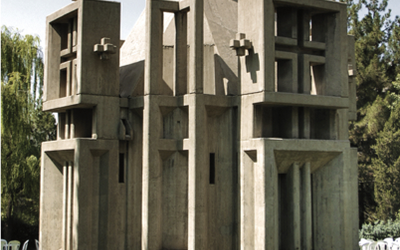
This lecture provides an overview of Iranian Armenian Church architecture. Due to the historical presence of Armenians and Assyrians as two historical nations, today, there are hundreds of churches in different geographic parts of Iran, which have remained from different periods and cultural-political conditions. The religious architecture of the Armenian churches in Iran has more than 1,700 years of history along with considerable geographical dispersion. It sets on the typ… continue reading
This lecture provides an overview of Iranian Armenian Church architecture. Due to the historical presence of Armenians and Assyrians as two historical nations, today, there are hundreds of churches in different geographic parts of Iran, which have remained from different periods and cultural-political conditions. The religious architecture of the Armenian churches in Iran has more than 1,700 years of history along with considerable geographical dispersion. It sets on the typ…
supporting documents: • Handout • Quiz with Answers

While in a few Middle-Eastern countries such as Iran, Egypt and Turkey, the process of modernization started from the mid-nineteenth century, it gained a new momentum in the aftermath of the Second World War, in the whole region. The period of ‘post-war corporatist compact’, as Kevan Harris called it, saw the US hegemony pervade the region and sponsor aided state-led development. In the context of the early Cold War period, the US implemented a geopolitical strategy of negot… continue reading
supporting documents: • Bibliography • Course Introduction • Lecture Abstracts • Questions and Assignments • Syllabus
Lecture 1 | Exporting American Architecture & Lifestyle (1948-58) By focusing on the period between 1948 and 1958, the first lecture provides materials to discuss how the export of American household commodities and cars, under the Point IV program, set a basis for the expansion of a new lifestyle among Iranians. To this end, this lecture firstly addresses the impact of the American technical and self-help aids, such as the home-economy program, on the domestic life of ordi…
supporting documents: • Handout • Lecture Notes
Lecture 2 | Recasting Public Housing Practices in Iran: The Example of Kuye Kan (1958-68) In the previous lecture, I looked at the ways through which the capitalist mode of consumption and production led to the development of a design manual for the city of Tehran. The second lecture firstly discusses how this manual shaped the built environment of a prototypical housing model known as Kuy-e Kan in West-Tehran; and how Iranian architects used this model to stimulate a new l…
supporting documents: • Handout • Lecture Notes
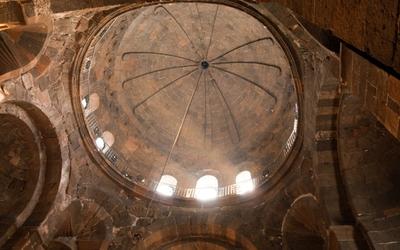
This lecture provides an overview of Armenian Church architecture. It sets the architectural tradition within the landscape and history of the Armenian plateau. Armenian churches flourished in the medieval period and developed a distinctive construction method, floor plan, and decorative style. Each example is considered in the context of regional and global architectural currents, including Byzantine and Iranian. The lecture also considers the legacy of medieval Armenian ar… continue reading
This lecture provides an overview of Armenian Church architecture. It sets the architectural tradition within the landscape and history of the Armenian plateau. Armenian churches flourished in the medieval period and developed a distinctive construction method, floor plan, and decorative style. Each example is considered in the context of regional and global architectural currents, including Byzantine and Iranian. The lecture also considers the legacy of medieval Armenian ar…
supporting documents: • Handout • Lecture Notes • Quiz with Answers

This course focuses on the architecture in areas where different cultures meet. Often located in a region bordering different ethnic or religious groups, architectural traditions in these areas are often neglected in standard narratives in architectural history since they don’t fit squarely into any fully established historical categories, such as Chinese or Japanese. Many such areas also used to be independent kingdoms in history, for instance, the area known as Okinawa use… continue reading
This first lecture introduces the broad theme of “cultural borders” with a focus of their formation on the historical regime changes and population movements in the targeted regions. It highlights both the spatial, physical borders, as in the case of the Ryukyu Kingdom, and the more intangible, less geographically defined cultural borders, as in the case of the Great Xia and the Hui ethnic group.
supporting documents: • Lecture Notes • Handout • Quiz with Answers
The Yunnan province in China used to be the land of the Nanzhao (738-937) and Dali (937-1253) Kingdoms. Bordering and adjacent to Myanmar, Thailand, Laos, and Vietnam, the various ethnic groups in this region, especially the Dai, had long been practicing Theravada Buddhism as a major way for community building. The presence of Han and Tibetan Mahayana schools in this southwestern province, as well as both Confucian and Daoist believes incorporated into the religious and secu…
supporting documents: • Handout • Lecture Notes • Quiz with Answers
The northwestern Chinese provinces of Ningxia and Gansu are homes of the largest Sinicized Muslim communities, the Hui. Historically, this area often supported independent regimes coexisting with a major Chinese dynasty, such as the Xixia Kingdom in the 10th to 13th centuries. Bordering the Han Chinese, Turkic Uighur, and the Tantric Tibetan, architecture in the former land of the Great Xia evolved into significant local styles in different building types, Islamic mosques, B…
supporting documents: • Lecture Notes • Handout • Quiz with Answers
Inner Mongolia is the region within the PRC where concentrated Mongolian communities dwell. Culturally and geographically bordering China Proper, Khalkha Mongolia, Islamic Uighur, and the Tibetan Amdo, the architecture of Inner Mongolia demonstrate the colorful spectrum of multi-cultural assimilation. It is also the historic homes of many nomadic groups that had been passing through Inner Asia, such as the Huns (Xiongnu), Tartar, and Turks among others. During the Yuan dynas…
supporting documents: • Handout • Lecture Notes • Quiz with Answers
In looking at the architecture in the land of the Rykyu Kingdom, this lecture introduces buildings of both public, religious, and official nature, and that for private and vernacular residence. The typology of Okinawa architecture indicates influences from both China and Japan, and the archaeological discoveries suggest further Southeast Asian links in dwelling modes and construction techniques. The extensive use of stone in residential compounds, castles, and bridges, howev…
supporting documents: • Handout • Lecture Notes • Quiz with Answers

This module of five charts the design, forms, types, siting and construction techniques from the vernacular to contemporary architecture in a survey of Australian Aboriginal and Torres Strait Islander architectures from pre-colonization to the present day. The module presents materials on Australian Aboriginal and Torres Strait Islander architecture for teaching to national and international audiences, for standalone or delivery as a lecture series. The lecture series di… continue reading
supporting documents: • Syllabus
This lecture discusses the diversity of Aboriginal groups across Australia, explaining the concept of Country as central to Aboriginal spirituality and identity and how the concept of Country includes all parts of the environment, cultural practices, knowledges, songs, stories, art, architecture and all peoples, past, present and future. The lecture is presented in five parts: 1. Indigenous occupation of Australia This contrasts various Western science models of how Ab…
supporting documents: • Quiz • Bibliography • Handout • Lecture Notes
The lecture focuses on the architectures and infrastructure of precolonial Australian Aboriginal societies. This period has also been titled ‘classical’ ethno-architecture, ’classical’ Aboriginal architecture, vernacular architecture, and traditional architecture. This lecture discusses that prior to British invasion in 1788, the architecture typologies and infrastructures of Aboriginal settlements across Australia were rich, varied and diverse. This lecture is in thr…
supporting documents: • Bibliography • Lecture Notes • Quiz • Handout
This lecture discusses the inland expansion of the colonial frontier and the impact on Aboriginal and Torres Strait Islander architectures and details the architectural ingenuity of displaced people forming communities. The lecture discusses the concentration of Aboriginal and Torres Strait Islander peoples into pastoral camps, government reserves and settlements, town camps, missions, lock hospitals and leprosariums, the invention of the ‘Aboriginal community’ and the b…
supporting documents: • Bibliography • Lecture Abstract • Lecture Notes • Quiz
Christian missionaries and their churches have had a huge impact on Indigenous cultures and peoples across the world. Christian paradigms regarding Indigenous humanity were flawed and paradoxical (especially given that they were based on the concepts of Terra Nullius (Australia) and Manifest Destiny (US)) and efforts to protect and proselytize First Nations peoples across various countries on the Pacific Rim had mixed results. Despite this, over time, many Indigenous peo…
supporting documents: • Handout • Lecture Notes • Bibliography • Quiz
The recognition of Indigenous cultural domains by institutions has fundamentally changed since the mid-twentieth century, when architects (almost exclusively non-Indigenous Australians at that time) first accepted and then later celebrated Indigenous cultures and identity/s in building design. This lecture discusses exemplars of architectural design and examples that illustrate various architectural approaches, debates and discourses. These new building typologies provide an…
supporting documents: • Bibliography • Handout • Lecture Notes • Quiz

The lectures on Australian Aboriginal sacred landscapes can form part of a course, or individual lectures can be integrated into new or existing courses. Since at least 40,000 BCE the Australian Aboriginal peoples have engaged with the landscape by marking it as a sacred creation of the Dreamings, ancestral supernatural creator spirits that created the world in a primordial age called Dreamtime. For at least 40 millennia Aboriginal groups embellished the ground, cliffs, hill… continue reading
The first lecture introduces the Aboriginal people who have lived in Australia for over 40 millennia. Several sites demonstrate the presence of early Aborigines as nomadic hunter-gatherers; cremations, burials, ovens, and artifacts date to at least 40,000 BCE. Early evidence of aquaculture evinces a rare instance of hunter-gatherer engineering that led to food surplus and stone houses. Etching, stenciling, and painting on rocks denote the presence of Dreamings, whose paths i…
supporting documents: • Lecture Notes • Handout • Quiz with Answers
The Uluru-Kata Tjutu National Park in the Northern Territory contains many rock formations, including Uluru. Aborigines believe that Dreamings created every topographical feature, including water holes, hills, caves, and fissures. Rock art in caves represents wallabies, humans, and other Dreamings that, according to the Pitjantjatjara, Anangu, and other groups, created Uluru. To the west, Kata Tjuta is a group of monumental domed rocks. Aboriginal oral tradition recounts tha…
supporting documents: • Lecture Notes • Quiz with Answers • Handout
In addition to rock painting, petroglyphs (carved rock) some as early as 40,000 BCE, are found in nearly every region of Australia. Local stones were used as carving tools. Imagery includes birds, marine life, and people. Australia also features meaningful arrangements in a variety of configurations. Some rock art in caves was made with fingers and sticks pressed into soft limestone. Specific sites were used for important events such as childbirth. Some detailed rock engravi…
supporting documents: • Quiz with Answers • Handout • Lecture Notes
For at least 20,000 years Aboriginal Groups have occupied the region of Kakadu National Park in the Northern Territory. It contains the largest concentration of rock art in Australia. The painted rock shelters provided places to sleep and protection from the rain. Different types of painting include naturalistic representations and an “x-ray” style that shows outlines and interior anatomical details of people and animals. Some painted surfaces contain layers of imagery that …
supporting documents: • Handout • Lecture Notes • Quiz with Answers
To the east of Kakadu National Park is Arnhem Land, an Aboriginal reserve in the Northern Territory. The region is an immense landscape of rock shelters, some of which were manipulated by altering ceilings and removing natural stone pillars. Some rock paintings may be 45,000 years old. Subject matter includes Dreamings, supernatural spirits, rituals, fauna, and the arrival of Europeans. In a few cases, beeswax pellets were applied to cave walls to create relief imagery. The …
supporting documents: • Handout • Lecture Notes • Quiz with Answers
The final lecture concerns the transformation of traditional Aboriginal mark-making that utilizes new materials, content, and venues. For thousands of years Aborigines painted on eucalyptus bark. This tradition changed in the mid-20th century, when missionaries asked artists in several provinces to create bark paintings to be used in educating white Australians about indigenous culture and to sell so that profits could help support missions. This coincided with some national…
supporting documents: • Handout • Lecture Notes • Quiz with Answers
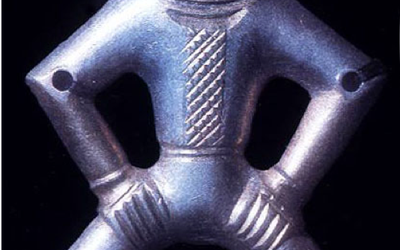
This course surveys the rise of the building tradition in the East European Plain between the end of Antiquity and the 16th century CE, when the autochthonic wooden construction skills were supplemented by imported stone masonry expertise. It situates preserved and excavated monuments of pre-modern Russian architecture within the political history of Old Rus’ and its contacts with the Byzantine Empire, Germanic lands, Scandinavia and the Eurasian steppes. Beginning with wood… continue reading
The lecture covers the earliest phase of architectural history in the East European Plain from the end of Antiquity until the end of the 10th century AD. The continuous construction of kurgans (burial mounds) linked the ancient Scythian culture with the architectural production of the Scandinavians, who around the 8th century AD discovered a shortcut from the Baltic to the Black and the Caspian Sea via the network of East European rivers. In the East European Plain the Norse…
supporting documents: • Lecture Notes • Handout • Quiz with Answers
This lecture explores the early phase of assimilation of the Middle Byzantine tradition of masonry church architecture in medieval Rus’ after its Christianization by Prince Vladimir at the end of the 10th cent. CE. It focuses on the introduction of the cross-in-square churches from Constantinople and possibly northern Anatolia and Bulgaria first in Kiev and Chernigov--the southern urban centers of Rus’ in modern Ukraine--and subsequently in Novgorod and Polotsk in Russia and…
supporting documents: • Handout • Lecture Notes • Quiz with Answers
Lecture 3. The Romanesque in the Northeast of Russia (Second Half of the 12th – Early 13th Cent. CE)
This lecture discusses the original synthesis between the Middle Byzantine architectural tradition and the Romanesque construction and decoration techniques that defined the ecclesiastical and palatial architecture of Vladimir-Suzdal’ region in the northeastern lands of Rus’ during the second half of the 12th and the first quarter of the 13th century. The princes of Vladimir attracted masons from the Holy Roman Empire in modern Germany and northern Italy. These Romanesque ma…
supporting documents: • Handout • Quiz with Answers • Lecture Notes
The lecture introduces the students to the gradual process of the adaptation of the Middle Byzantine tradition to the conditions of northwestern Rus’. Two major centers of northwestern Rus’, the commercial republics and city-states of Novgorod and Pskov, developed a distinct type of patronage: most of their churches were commissioned by merchants, bishops and chief administrators of the republics rather than the princes as in the other part of pre-Mongol Rus’ and later in th…
supporting documents: • Handout • Lecture Notes • Quiz with Answers
Based on fragmented existing evidence, this lecture reconstructs the history of the Golden Horde architecture in the East European Plain between the 13th and the 16th centuries. During this period, the progressively islamicized nomadic empire of the Golden Horde and its successor states were in continuous conflict with the Slavic and Christian Orthodox principalities of northeastern Rus’, gradually united by the Grand Principality of Moscow. This conflict determined the post…
supporting documents: • Handout • Lecture Notes • Quiz with Answers
After the Mongol conquest, most of the old urban centers of Rus’ (with an exception of Novgorod and Pskov) declined; in northeastern areas Vladimir and Suzdal’ were gradually overtaken by Moscow, which eventually established control over most of the East European Plain. With the progressive increase of wealth under their control, the grand princes of Moscow were able to fund construction that reflected their imperial aspirations. Yet already in the 15th century they discover…
supporting documents: • Handout • Lecture Notes • Quiz with Answers
The lecture explores the most complex and original phenomenon of medieval Russian architecture – churches with tent (shatër) domes that appeared in the middle of the 16th century and were prohibited in the middle of the 17th century by Russian Patriarch Nikon as a deviation from the Byzantine canon of Christian religious architecture. Clearly distinct from the Middle Byzantine tradition of cross-in-square plan characteristic of most masonry structures in medieval Rus’ and th…
supporting documents: • Handout • Lecture Notes • Quiz with Answers
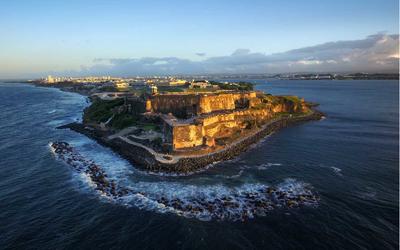
This lecture is an introduction to architecture and urbanism in a “Spanish colonial space called Puerto Rico”. We will look at cultural landscapes defined by four hundred years of European colonialism. The lecture’s title is a nod to the key roles that the Atlantic Ocean and Caribbean sea have wielded on Puerto Rican transcontinental relationships. Metaphorically they seem to define a play in two acts. We will consider Puerto Rico’s architecture examining a series of layer… continue reading
This lecture is an introduction to architecture and urbanism in a “Spanish colonial space called Puerto Rico”. We will look at cultural landscapes defined by four hundred years of European colonialism. The lecture’s title is a nod to the key roles that the Atlantic Ocean and Caribbean sea have wielded on Puerto Rican transcontinental relationships. Metaphorically they seem to define a play in two acts. We will consider Puerto Rico’s architecture examining a series of layer…
supporting documents: • Questions and Assignments • Handout • Lecture Notes • Quiz with Answers
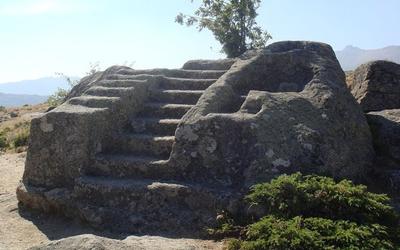
Many surveys discuss the Celts, but only after Rome invaded under Caesar beginning in 58 BC. In reality the Celts came to dominate most of Europe beginning in the 5th century. New research in the last decade has made it clear that the Celts were not the strange wild barbarians that the Romans made them out to be. They were important trading partners for the Romans, providing copper, gold, iron and tin. The Celts also provided a tremendous organizational skill to the dispara… continue reading
Many surveys discuss the Celts, but only after Rome invaded under Caesar beginning in 58 BC. In reality the Celts came to dominate most of Europe beginning in the 5th century. New research in the last decade has made it clear that the Celts were not the strange wild barbarians that the Romans made them out to be. They were important trading partners for the Romans, providing copper, gold, iron and tin. The Celts also provided a tremendous organizational skill to the dispara…
supporting documents: • Quiz with Answers • Handout
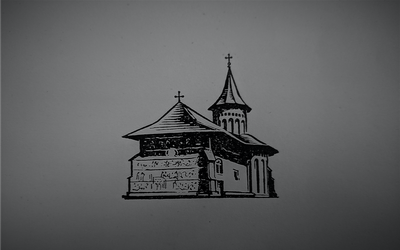
This lecture covers key religious architectural monuments built in the principality of Moldavia in the 15th and 16th century, under the rule of Stephen III and, subsequently, of his son Peter Rareș. As rulers of Christian lands after the fall of Constantinople in 1453, they expressed their princely aspirations and sought legitimacy not only through political and military tactics but also through extensive artistic and architectural commissions. The numerous churches erec… continue reading
The Principality of Moldavia, situated in the northeastern part of modern-day Romania, emerged as an independent state in the 14th century. Within the sphere of influence of Byzantium, Poland-Lithuania, Hungary, and, after 1453, of the Ottomans, this region of the Carpathian Mountains gave birth to a unique form of religious architecture that combined the iconography of Byzantium, the construction technologies of the Gothic, and the rituals of the Orthodox faith. What is now…
supporting documents: • Handout • Lecture Notes

Among the wide range of materials that humans consume, substances such as coffee, tea, chocolate, and tobacco seem to form a separate category: humans take these so-called stimulants or psychoactive substances less for their nutritional benefits than for their capabilities in altering their moods or the status of their minds. The fact that materials containing similar chemical compounds were used in different regions of the world underscores their inherent physiological appe… continue reading
Farshid Emami, Hessam Khorasani Zadeh
supporting documents: • Bibliography • Course Introduction • Syllabus • Lecture Abstracts • Questions and Assignments
Lecture 1 provides an overview of the structure of the module and an introduction to its main themes and concepts. The lecture will then offer a broad overview of the precursors of coffeehouses and teahouses in the pre-1500 world. This introductory part aims to set the module in a longer trajectory of human existence on the globe. The lecture will then focus on the history of wine and beer and their socio-spatial dimensions in the ancient world. This would provide a backgrou…
supporting documents: • Handout • Lecture Notes
In the previous lecture, we looked at the emergence of coffee as a novel social drink in the eastern Mediterranean in the 16th century. This lecture deals with the architecture of coffeehouses, from the mid-sixteenth-century to mid-eighteenth-century. In each context, we start with a broad description of the introduction of coffee and the coffeehouse and the circumstances of their transfer, along with a detailed analysis of one or two representative examples. The lecture end…
supporting documents: • Lecture Notes • Handout
Lecture 3 first offers an overview of the ways in which the emerging trade networks affected the dissemination and popularization of new substances. Using maps and diagrams, we will explain how a new web of maritime trade dominated by European powers was formed. The various trajectories of coffee, chocolate, and tobacco distribution across the globe will serve as illustrations of the workings of this newly formed colonial system.
supporting documents: • Lecture Notes • Handout
This lecture offers a global architectural history of teahouses. Starting with Chinese tea culture, the lecture will specifically focus on the development of the Japanese tea ceremony and its architectural setting. The lecture will then consider the teahouse in the global context from the seventeenth century onward. We will specifically focus on the emergence of the British tearooms and tea gardens, which will be explained in the context of the hegemonic colonial presence of…
supporting documents: • Lecture Notes • Handout
Lecture 5 begins with a brief review of colonial production and trade of coffee in the mid-18th century. We will first focus on the emergence of coffeehouses as self-contained structures—first in private gardens, and then in public ones— in the late 18th century/early 19th centuries. The second part examines urban coffeehouses in the same period. We examine how coffeehouses became sites of urban leisure for European bourgeoisie during the first half of the 19th century. The …
supporting documents: • Handout • Lecture Notes

Empires of the nineteenth and twentieth centuries dominated vast territories and millions of human beings. In 1938 Western Europe, the US, and Japan together colonized 42% of the earth’s land area and 32% of its population. Overlaying territories with planned cities and building programs constituted major work in a process of colonialist exploitation that depended on imbalanced power dynamics and violence of which cities and architecture are the physical embodiment. They ar… continue reading
Flavia Marcello, Daniel Coslett, David Rifkind, Mira Waits
supporting documents: • Bibliography • Syllabus
This first lecture introduces the broad theme of modern colonialism of the 19th and 20th centuries and the state of the research field. It introduces the concept of empire and different types of colonies. It explores the role played by ancient empires as models for European powers during the modern era and the relationships between this emulation and architectural and urban form. Related cultural references are also addressed. The lecture presents a rationale for the focus o…
supporting documents: • Handout • Quiz with Answers
This second lecture considers global networks of commerce and control in the 19th century. An analysis of trade routes, import-export interdependency, slavery, penal systems, resource exchange between is contextualized within wider social and economic changes connected to the industrial revolution, the rise of capitalism and entities like the Dutch East India Company. This lecture also introduces the case study cities (Melbourne, Nairobi, and New Delhi from the British Empir…
supporting documents: • Handout • Quiz with Answers
The third lecture focuses on the architectures of power in colonial contexts. It considers how colonial powers represented themselves and their perceived superiority and strength through built environments including transport and communication networks, public monuments, and prominent government buildings (including clock towers, post offices, city halls, and parliaments), and educational institutions. The discussed built environments established and, for a time, maintained …
supporting documents: • Handout • Quiz with Answers
The fourth lecture considers domestic architecture in each of the case study cities and how it exemplified hierarchical relationships and hybridisations between the building traditions of the local populations and colonizers. It introduces governor’s houses as expressions of power, adaptations of local housing types such as bungalows, courtyard houses, and shop houses; indigenous construction systems and materials; settlement patterns; and placemaking practices. It also look…
supporting documents: • Handout • Quiz with Answers
This fifth lecture addresses religious and spiritual architectures in the colonized world, including those of the colonizers and indigenous residents. It looks at how colonial powers regulated local religious practices and spaces, and how Christian religious buildings used by the colonizing powers were placed in cities in manners that represented their position and interacted with the existing architectures of Islam, Hinduism, Buddhism, and folk religions. Contents: 1…
supporting documents: • Handout • Quiz with Answers
The sixth lecture considers 19th-century concepts of leisure, health, and hygiene and how they were imposed on the landscapes of the colonial city, both for health and for socializing. It considers the social aspects of public green spaces such as parks and promenades, as well as who was permitted to use them and the power relations they engendered. Contents: 1. Introduction: Theorizing Colonial Landscapes 2. Hygiene and Public Space a. Riparian corridors, Addis Aba…
supporting documents: • Quiz with Answers • Handout
The final lecture in the module looks at the decolonization processes for each case study empire/country and the inherited legacies of architectural remains, institutional system, and political dependency. It also looks at evolving acknowledgements of the treatment of indigenous peoples, reconciliation and returned sovereignty, as well the evolving identity the postcolonies under successive waves of occupation and/or migration. It also introduces ongoing debates regarding co…
supporting documents: • Handout • Quiz with Answers

This lecture course unpacks spaces of contestation and encourages students to think critically about how specific sites and objects have participated in the construction of class, race, and gender. Building on the histories of art and architecture, the course proposes the category of “space” as an alternative to the geographic, aesthetic, and analytic categories that have shaped the canons of these two disciplines. The lectures address those historically excluded from these … continue reading
Ana María León, Tessa Paneth-Pollak, Martina Tanga, Olga Touloumi
supporting documents: • Lecture Notes • Lecture Notes
Our week on “the closet” traces a long history of the architecture of privacy and asks how the “closet” came to signify a space of familial secrets and forbidden sexualities. We are looking at the “closet” both as an architectural site that raises boundaries and marks rites of passage, as well as a metaphor that structures sexualities around visibility and obscurity. We open the concept of the closet to a transcultural understanding, comparing and contrasting the various way…
supporting documents: • Quiz with Answers • Lecture Notes • Handout
This lecture will take us to England and the United States, and then to Tehran, Iran. We will explore how the domestic architecture of privacy developed in England alongside shifting cultural notions and practices of individuality, privacy, and the self.
supporting documents: • Handout • Lecture Notes • Quiz with Answers
This lecture introduces the kitchen as a space of both communal exchange and arduous labor, from the spaces of food preparation in the Americas at the time of the European arrival to the start of the 20th century. The lecture presents the kitchen as a domestic, private space that contains multiple transnational narratives of trade, from raw materials to the migrating populations it employs in the modern era, minorities and women. A broader narrative arch traces the struggles…
supporting documents: • Handout • Quiz with Answers • Lecture Notes
This lecture continues the theme of labor in the kitchen into the second half of the 20th century. The lecture will examine the tension between public and private, communal and individual spaces in the preparation and consumption of food. The notion of the communal kitchen puts pressure on the increasingly private and isolated workspace created by the conditions of industrial capitalism. Particularly in the west, these conditions create a physical separation of household spa…
supporting documents: • Handout • Quiz with Answers • Lecture Notes

Sub-Saharan Africa, often overlooked in architectural history literature, is a region not “apart from the world”, but one intricately linked to the world through among other things, networks of the trans-Saharan trade, the spread of religion, the Middle Passage, and colonialism. In part due to its lightweight construction and relative impermanence combined with legacies of colonial representation, and the problem of fewer archival documents to trace its history, the architec… continue reading
Lecture one begins with an overview of the Sub-Saharan region and foregrounds the issues with studying its architecture. These forms have been overlooked by many histories of world architecture in part due to their lightweight construction and impermanence in comparison to the monuments of the canon. Add to this their relatively small archival footprint and the legacy of colonial representation, scholars tended to view architecture in the region as “backwards” and inferior t…
supporting documents: • Handout • Quiz with Answers
Like smaller scale domestic works in the region, palace structures in Sub-Saharan Africa were important manifestations of cultural identity and political power. Displaying a range of formal, material, and stylistic variation, palaces were the center of religious, economic, and political activities. Often organized as a series of courtyards, palaces were sites of tremendous artistic production and contain many of the most important cultural artifacts of their time. Lecture 2 …
supporting documents: • Handout • Quiz with Answers
Anti-colonial movements swept across the Sub-Saharan region in the 1950s and 1960s. Years of colonial occupation were overturned, and African leaders faced new political challenges. Chief among these concerns was how to best express their national identity after independence. Architecture in this period became a complex register of inherited modern traditions from colonial occupiers and new expressions of hopes and aspirations. Architects like Demas Nwoko and Pierre Goudiaby…
supporting documents: • Handout • Quiz with Answers
Sub-Saharan Africa has a long history of building monumental sites of religious importance. While history textbooks emphasize iconic works in Egypt and other sites in North Africa, this lecture discusses the rich history of monumental architecture in Sub-Saharan Africa. Monuments constructed by the great empires of the era of trans-Saharan trade are symbols of power and evidence of the global spread of religions. Particularly important was the influence of Islam and construc…
supporting documents: • Handout • Quiz with Answers

The first lecture examines how although never formally a colony of a Western country, Iran’s strategic location and natural resources made it subject to indirect—what may be called semi-colonial—political and economic intervention by the West. The essence of this semi-colonial character is revealed in the design and function of architecture and urban planning in Abadan and this lecture features the very many ways in which this semi-colonial atmosphere influenced the resident… continue reading
This lecture is prepared for Domesticity across Space and Time Module of GAHTC. Numerous sources have been used for this module. However, the most prominent ones are listed below and they are required reading for this lecture. Although never formally a colony of a Western country, Iran’s strategic location and natural resources made it subject to indirect—what may be called semi-colonial—political and economic intervention by the West. The essence of this semi-colonial chara…
supporting documents: • Bibliography • Handout • Quiz with Answers
This lecture is prepared for Domesticity across Space and Time Module of GAHTC. The main sources that were used are listed below and are required reading. This lecture shows how larger policies of the Cold War and the Iranian government influenced domesticity. Something as simple as new ways of cleaning the house can be traced to America’s exercise of “quiet diplomacy” in Iran. Revisiting this era fosters understanding of the culture and daily life of people not just in Iran…
supporting documents: • Handout • Bibliography • Quiz with Answers
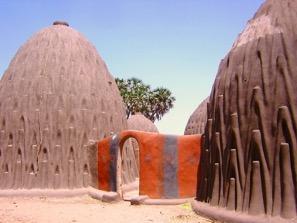
The first lecture explores how earth has been conceptualized and integrated into African thought and architectural practice as material, metaphor, environment, and intervention over time. Some of the first known man-made environments on the African continent were carved out of rock features in the landscape, and from this point of origin, cultures across the continent would proceed to develop a variety of distinctive architectural traditions and material practices that were … continue reading
This lecture explores how earth has been conceptualized and integrated into African thought and architectural practice as material, metaphor, environment, and intervention over time. Some of the first known man-made environments on the African continent were carved out of rock features in the landscape, and from this point of origin, cultures across the continent would proceed to develop a variety of distinctive architectural traditions and material practices that were regul…
supporting documents: • Keywords • Lecture Notes • Quiz • Quiz Answers • Bibliography • Lecture Abstract
Picking up where the previous lecture left off, this lecture explores the ways in which earth and architectural practice has evolved in the contemporary period in the context of increased concern around issues of pollution, unsustainable development, and the widespread depletion of natural resources in Africa. Architects are increasingly turning to so-called vernacular materials like earth and experimented with different methods of construction technology in an effort to est…
supporting documents: • Quiz • Quiz Answers • Lecture Notes • Keywords • Bibliography
East Asian Architecture from A Global Perspective: Cultural Transactions and the Development of Traditions
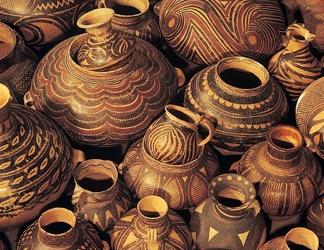
This course focuses on the architectural traditions and conventions of East Asia, especially those of China, Korea, and Japan, and highlights the cross-cultural aspects of their great cities and monuments. The aim is to reveal that what has often been considered “traditional” in Asia was actually a constantly evolving process driven by dynamic cultural exchanges among different cultures and civilizations of its extensive regions. “Globalization” is not an invention of the co… continue reading
Shuishan Yu, Sean Harland McPherson
supporting documents: • Bibliography • Readings • Discussion Questions • Final Exam • Midterm • Syllabus
East Asia is a relatively clear idea defined by geography, culture, political constitution, and history. For more than two millennia, the high culture of the region was part of the Chinese cultural sphere, most centrally defined by the influence of Chinese script, Classical Chinese, and the wide range of cultural practices that it entails. At the same time, East Asia contains a vast diversity of political entities, ethnic communities, and language groups. China is presently …
supporting documents: • Lecture Notes • Handout
We know very little about Neolithic and Bronze Age architecture in East Asia. Many regions were not under centralized governance yet during this period, thus the lack of permanent monumental construction. Housing, often built with temporary material, and often succumbed to the lapse of time and easily vanished in repeated redevelopments during the following eras. The life and history of this remote past survived only fragmentally in legends and artifacts. In recent years, ar…
supporting documents: • Lecture Notes • Handout
Fengshui (pungsu in Korean, literally “wind and water”) is a theory in East Asia to identify the best locations in nature for a city or a building. In China and Korea, with the belief that the fengshui of the ancestral tomb or living residence influences the fortune of the descendants and the prosperity of the family, consulting a fengshui master is important for the construction of both residential and funerary architecture. Confucianism highlights family values and vener…
supporting documents: • Lecture Notes • Handout
The practices of laying out cities with regard to the geomantic principles of fengshui, enclosing and subdividing urban space within an orthogonal grid of walls and thoroughfares, and creating a hierarchy of space based upon functional and status considerations makes up one of China’s most significant contributions to the global history of urbanism. The rational, gridded order of the Chinese city served as metaphor and reinforcement for compelling ideologies of centralized …
supporting documents: • Lecture Notes • Handout
The extraordinary legacy of art and architecture associated with the teachings of Buddhism constitute one of the most enduring elements of cultural connection among diverse cultures in Asia. Originating in South Asia, these teachings found multifarious and complex pathways over both land and sea to find followers in cultures as distinct in their values as they separated by geographical distance. The history of East Asian Buddhist architecture, and Buddhist belief and pract…
supporting documents: • Lecture Notes • Handout
The extraordinary legacy of art and architecture associated with the teachings of Buddhism constitute one of the most enduring elements of cultural connection among diverse cultures in Asia. Originating in South Asia, these teachings found multifarious and complex pathways over both land and sea to find followers in cultures as distinct in their values as they separated by geographical distance. The history of East Asian Buddhist architecture, and Buddhist belief and pract…
supporting documents: • Lecture Notes • Handout
Buddhist architecture since the 14th century became more and more integrated into local cultures, creating colorful mixtures in philosophy, ritual practice, as well as architectural space, form, and decoration. Major dynasties and cultural periods in East Asia since the 14th century Maritime route connection, replacing the land route Silk Road, became the main venue for cultural exchanges. Influences from mainland East Asia on Japan and the Korea Peninsula were mainly fr…
supporting documents: • Lecture Notes • Handout
This lecture focuses on the palatial residences, together with the surrounding monumental ritualistic structures that legitimatize their claims to rule, highlighting the period between 1400 and 1800 but also tracing its ideological origins to earlier monuments. Centered on the major capital cities of the Ming and Ching dynasties in the continent, the Joseon Dynasty in the Korean peninsula, and the castle complexes of the late Muromachi and Momoyama period in Japan, the city …
supporting documents: • Lecture Notes • Handout
Literati culture boomed in East Asia since the 10th century. The greatest architectural expression of the literati culture is the private garden, where all intellectual and artistic activities associated with the literati taste took place, such as poetry, calligraphy, painting, qin zither playing, weiqi (go in Japanese) chess, refined theater, and antiquarian connoisseurship.
supporting documents: • Lecture Notes • Handout
Though traditional histories of East Asian architecture inevitably focus upon the gridded cities, extraordinary structural, decorative and iconographic complexity of religious architecture, and the scale and technical sophistication of the centers of elite power, the built environment of ordinary people in all cultures is one of the most diverse and rich in world architectural history. This is so partly for simple reasons of scale – East Asia for most of world history has h…
supporting documents: • Lecture Notes • Handout
The nineteenth and early twentieth century saw a fundamental shift in the power structure of the world and of the East Asian region. Marked by the loss of the Opium wars, the Qing Dynasty went into radical decline. At the same time, Japan ascended as a world power by quickly absorbing and adapting to Western technology. With this fundamental shift in the power structure of the region, East Asia enters a fascinating, tragic historical period of imperialism and colonialism, of…
supporting documents: • Lecture Notes • Handout
The unconditional surrender of Japan and the end of World-War II marked the beginning of a new world order that has directly shaped the environment that we now live in. The ensuing decades of the Cold War saw the rise of communist China, the division of the Korean peninsula into north and south, the disarmament and democratization of Japan and its re-emergence as an economic powerhouse. Even though the conditions of architectural production among the newly-born nation states…
supporting documents: • Lecture Notes • Handout
East Asian Architecture from a Global Perspective: Cultural Transactions and the Development of Traditions (SPANISH TRANSLATION)
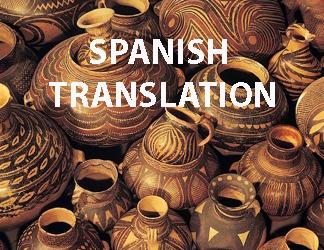
Este curso se centra en las tradiciones y convenciones arquitectónicas de Asia oriental, especialmente las de China, Corea y Japón, y destaca los aspectos interculturales de sus grandes ciudades y monumentos. El objetivo es revelar que lo que a menudo se ha considerado "tradicional" en Asia fue en realidad un proceso en constante evolución impulsado por intercambios culturales dinámicos entre las diferentes culturas y civilizaciones de sus extensas regiones. La "globalizació… continue reading
Shuishan Yu, Sean Harland McPherson, Fernando Luis Martinez Nespral
supporting documents: • Bibliography • Final Exam • Lecture Abstracts • Questions and Assignments • Syllabus
Si bien las historias tradicionales de la arquitectura de Asia oriental se centran inevitablemente en las ciudades reticuladas, la extraordinaria complejidad estructural, decorativa e iconográfica de la arquitectura religiosa, y la escala y la sofisticación técnica de los centros de poder de la élite, el entorno construido de la gente común en todas las culturas es uno de los más diversos y ricos en historia arquitectónica mundial. Esto se debe, en parte, a razones simples d…
supporting documents: • Handout • Lecture Notes
El siglo XIX y principios del siglo XX significaron un cambio fundamental en la estructura de poder del mundo en general y de la región de Asia Oriental en particular. Marcado por la pérdida de las guerras del opio, la dinastía Qing entró en decadencia radical. Al mismo tiempo, Japón ascendió como potencia mundial al absorber y adaptarse rápidamente a la tecnología occidental. Con este cambio fundamental en la estructura de poder de la región, el este de Asia entra en un per…
supporting documents: • Lecture Notes • Handout
La rendición incondicional de Japón y el final de la Segunda Guerra Mundial marcaron el inicio de un nuevo orden mundial que ha dado forma al entorno en el que vivimos hoy. Las décadas posteriores a la Guerra Fría vieron el surgimiento de la China comunista, la división de la península coreana en el norte y el sur, el desarme y la democratización de Japón y su resurgimiento como una potencia económica. A pesar de que las condiciones de producción arquitectónica entre los est…
supporting documents: • Lecture Notes • Handout
Asia oriental es una idea relativamente clara definida por la geografía, la cultura, la constitución política y la historia. Durante más de dos milenios, la alta cultura de la región fue parte de la esfera cultural china, definida de manera central por la influencia de la escritura china, el chino clásico y la amplia gama de prácticas culturales que conlleva. Al mismo tiempo, el este de Asia contiene una gran diversidad de entidades políticas, comunidades étnicas y grupo…
supporting documents: • Lecture Notes • Handout
Sabemos muy poco acerca de la arquitectura neolítica y de la Edad de Bronce en el este de Asia. Muchas regiones no estaban aún bajo un gobierno centralizado durante este período, por lo tanto, no hubo una construcción monumental permanente. Las viviendas, a menudo, fueron construidas con materiales temporales, y con frecuencia sucumbieron al paso del tiempo y se desvanecieron fácilmente en remodelaciones repetidas durante las siguientes épocas. La vida y la historia de este …
supporting documents: • Handout • Lecture Notes
El Fengshui (pungsu en coreano, literalmente "viento y agua") es una teoría del este de Asia para identificar las mejores ubicaciones en la naturaleza para una ciudad o un edificio. En China y Corea, con la creencia de que el fengshui de la tumba ancestral o residencia viviente influye en la fortuna de los descendientes y la prosperidad de la familia, consultar a un maestro del fengshui es importante para la construcción de la arquitectura residencial y funeraria. El confuc…
supporting documents: • Lecture Notes • Handout
Una de las contribuciones más importantes de China a la historia global del urbanismo es la práctica de diseñar ciudades con respecto a los principios geománticos del fengshui, delimitar y subdividir el espacio urbano dentro de una red ortogonal de muros y vías, y crear una jerarquía de espacio basada en consideraciones funcionales y de estado. El orden racional y cuadriculado de la ciudad china sirvió como metáfora de las ideologías de control centralizado que encontraron u…
supporting documents: • Lecture Notes • Handout
El extraordinario legado del arte y la arquitectura asociados con las enseñanzas del budismo constituyen uno de los elementos más perdurables de conexión cultural entre las diversas culturas de Asia. Estas enseñanzas, que se originaron en el sur de Asia, encontraron caminos múltiples y complejos por tierra y mar para conseguir seguidores en culturas tan distintas en sus valores como separadas por la distancia geográfica. La historia de la arquitectura budista de Asia orienta…
supporting documents: • Lecture Notes • Handout
Después de la introducción del budismo en Corea y Japón como una herramienta impulsada por la élite para la centralización socio-política y económica de arriba hacia abajo entre los siglos IV y comienzos del VIII, surgieron nuevas variedades de pensamiento budista para expandir la base de su práctica a franjas más amplias de la sociedad. Esta ampliación se produjo en conjunto con reacciones a veces violentas e incluso una supresión total del budismo, un sistema de creencias …
supporting documents: • Handout • Lecture Notes
En Japón, el budismo zen llegó a una base cada vez más amplia de la sociedad. Patrocinado por los nuevos gobernantes samurai del período Muromachi, la austeridad ritual del budismo zen, el énfasis en la disciplina física e intelectual y la estricta adhesión a los conceptos de la transmisión maestro-acólito resultaron particularmente atractivos para los líderes que no eran considerados suficientemente cultos por las debilitadas elites de los aristócratas que habían dominado …
supporting documents: • Lecture Notes • Handout
Esta clase se centra en las residencias palaciegas, junto con las estructuras rituales monumentales circundantes que legitiman las pretensiones de los gobernantes, destacando el período entre 1400 y 1800, pero también rastreando sus orígenes ideológicos hasta monumentos anteriores. Está centrada en las principales ciudades capitales de las dinastías Ming y Ching en el continente, la Dinastía Joseon en la península coreana y los complejos de castillos de finales del período M…
supporting documents: • Handout • Lecture Notes
La cultura literati creció en el este de Asia desde el siglo X. Su mayor expresión arquitectónica es el jardín privado, donde se realizaron todas las actividades intelectuales y artísticas asociadas con el gusto literati, como poesía, caligrafía, pintura, práctica de la cítara, ajedrez, weiqi (go en japonés), teatro, y el saberes anticuario. Esta cultura, que primero floreció en la región de Jiannan del Delta del Yangtze en el sur de China, también influyó en las culturas…
supporting documents: • Handout • Lecture Notes
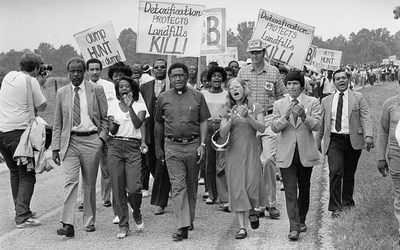
Starting at the scale of infrastructure, policy, and land acquisition, this lecture examines how the groundwork has been laid for ongoing exploitation and slow violence against communities of color in the United States. It explores the impacts of industrial pollution and contamination by highlighting the connections between the built environment and public health in light of the history of industrial zoning. Acknowledging the connections between race and contaminated envi… continue reading
Starting at the scale of infrastructure, policy, and land acquisition, this lecture examines how the groundwork has been laid for ongoing exploitation and slow violence against communities of color in the United States. It explores the impacts of industrial pollution and contamination by highlighting the connections between the built environment and public health in light of the history of industrial zoning. Acknowledging the connections between race and contaminated envi…
supporting documents: • Handout • Quiz with Answers • Questions and Assignments

This module will provide three distinct lectures on the global connections embedded in Etruscan culture and civilization – including its theological bases, material technologies and architectural productions. The Etruscan civilization (roughly 800 BCE to 200 BCE) was a central part of pre-Modern, Iron Age Europe (both geographically and culturally). While influenced by Greek work and often seen as a precedent for later Roman architecture, the complexity of Etruscan culture… continue reading
The first lecture discusses the origins of Etruscan culture and maps its global connections, through materials, technology, belief structure and trade networks. By tracing the production of iron, fired bricks, terra cotta and stone vaulting methods, Etruscan cities and temples become part of a larger flow of technologies and ideas. In addition, this lecture will address Etruscan ritual practices – including augury and divination – as part of a larger cosmic worldview with …
supporting documents: • Quiz with Answers • Handout
The second lecture will focus specifically on the ritual death practices and tomb architecture of Cerveteri and Tarquinia (both sites jointly recognized as UNESCO World Heritage Sites). The partially subterranean, rock-cut tombs have significant global ties to Greece, Syria, and West Asia as well as earlier Celtic tombs. Like other chthonic work, a distinct language of spaces results from a geologically-dependent, subtractive architecture. And yet, these spaces remain link…
supporting documents: • Handout • Quiz with Answers
The third, and final lecture will focus specifically on the transition from Etruscan to Roman power, and the corresponding global architectural ramifications. As influence shifted away from Etruscan cities to the Iron Age village developing along the banks of the Tiber River (through both conquest and assimilation), certain architectural ideas were adopted and assimilated, and others abandoned. Etruscan temple architecture fused with a continual influence from Greece, givin…
supporting documents: • Quiz with Answers • Handout
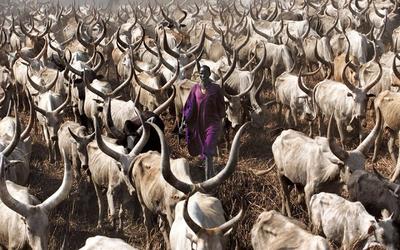
The general aim of this module is to help frame the beginning of a survey of architectural history. Lectures are designed to be a little over an hour long, but can be lengthened or shortened or combined as required. The material covers some basic aspects of First Society cultures (Lectures 1-4) and the transition to agriculture, pastoralism and city building (Lectures 6-10).
This lecture introduces what I call the “Social Package” that travelled from Africa from around 60,000 BCE throughout the entire globe. Traditionally, the emphasis has been on tools and weapons; here I want to emphasize the integration of tools with art making, hut making, and dance. The tendency in the scholarship has been to see these things as separate and to focus on ‘firsts.’ The point I want to make in this lecture is to focus on the time when the various elements of s…
supporting documents: • Handout • Lecture Notes • Quiz with Answers
In the last lecture, I introduced the idea of the “Social Package” that made us modern humans, from 150,000 or 200,000 BC through today. There is a lot more than can be said, but the lecture was intended to give the rudiments of a more elaborate discussion. This lecture moves the clock forward to the period called the Last Ice Age (ca. 24,000 BCE – 10,000 BCE). Though the world was uniformly colder than before, it was coldest in Europe, Russia, Siberia and Canada, which w…
supporting documents: • Handout • Lecture Notes • Quiz with Answers
Shamanism is a generic term that describes a broad set of ritual beliefs about the human relationship to other humans and nature. It is linked also to Animism. This lecture introduces the broad parameters of shamanism while also trying to get students to realize that shamanism is not a ‘dead religion.’ In the last few decades, it has even been revived – just think of the so-called neo-pagans who flock to Stonehenge! So what we see today in some parts of the world is a mixtu…
supporting documents: • Handout • Lecture Notes • Quiz with Answers
Rock Art accompanied all First Society cultures the world over. Its meaning and purpose can only be known through conjecture. This lecture introduces some examples and introduces the idea of Sacred Landscape. The lecture moves to what are certainly the most spectacular examples – the caves in southern France and northern Spain, made by the Magdalenian Culture. The history of these caves is not known definitively, but they were probably begun by the Gravettians. As the cli…
supporting documents: • Handout • Lecture Notes • Quiz with Answers
This lecture introduces the Holocene (around 10,000 BCE) and its consequences for the development of social forms. It is often argued that the Holocene set the stage for agriculture. This lecture starts from this premise, and demonstrates that the Holocene also set the stage for an expansion of First Society cultures. By 3,000 BCE, around the time we see the first cities in Mesopotamia, we see extensive First Society cultures developing in areas of particularly rich and …
supporting documents: • Handout • Lecture Notes • Quiz with Answers
At the core of the lecture is a map that differentiates the forest- and shore-based societies of the north and the emerging monsoon-based societies around the equator. It is to the latter that the word ‘civilization’ is often linked. What tends to be forgotten in that narrative is the emergence of the pastoral tradition and its new relationship to animals. Pastoralism developed in Africa and West Asia and had a huge impact on the social structure in the area of Africa-Eur…
supporting documents: • Handout • Lecture Notes • Quiz with Answers
This lecture is dedicated to agro-pastoralism, where agriculture and pastoral traditions blend into a single village-based worldview. Pastoralism and agro-pastoralism develop more or less at the same time, but in different eco-landscapes. The emergence of agro-pastoralism begins around 9,000 BCE and involves the concentration of energy around a single set of plants. Whereas First Society people used many plants in various ways, agriculturalists began to elevate one or two ab…
supporting documents: • Handout • Lecture Notes • Quiz with Answers • Quiz with Answers
The first four centers of agriculture were Mesopotamia, Egypt, the Indus region, and China. These places expanded outward from a clear center. Different is the story of Europe, where the agro-pastoral revolution arrived after expanding westward and northward from Mesopotamia, starting 5,500 BCE and reaching Ireland around 4,000 BCE. There were two main tracks, one overland through Romania and Germany, and one along the coasts of the Mediterranean and the Atlantic. The latter…
supporting documents: • Handout • Lecture Notes • Quiz with Answers
At the same time as the expansion of the agro-pastoral tradition across Europe, we see in Malta the emergence of a unique culture built not around self-sustaining agriculture, but a religious economy. As difficult as it might seem to the modern mind to imagine, this site in Malta was one of the first great regional sites of the world – perhaps even more important than Stonehenge, with which it has parallels. People came from afar by boat to visit one of the temples, to expe…
supporting documents: • Handout • Lecture Notes • Lecture Notes
This lecture covers the East Asian agricultural/horticultural worlds. I start with Hemudu, one of the first places where rice was grown agriculturally. The expansion of rice to the islands would come, however, remarkably late. First there was the Polynesian expansion, which did not involve rice, but a host of plants that were connected to solving the problems of food, clothing, building materials and the like. This ‘civilizational package’ was highly mobile and brought by b…
supporting documents: • Handout • Lecture Notes • Quiz with Answers
This is a long lecture that can easily be shortened or split into two. It covers the emergence of cities in the Tigris-Euphrates marshes. Unlike the conventional approach, which ‘naturalizes’ this phenomenon as part of the inevitable march of civilization, I want to make sure students realize that at that time, the first cities were highly speculative and filled with extreme risk. They had economies that had never been attempted before, namely single production economies (th…
supporting documents: • Handout • Lecture Notes • Quiz with Answers

American architectural history often ignores or glosses over Black architects and their contributions. Yet, prior to the advent of formal architectural education, which in its infancy offered little opportunity for Blacks to participate, large numbers of Black men prospered in the building trades. Louisiana’s gens de couleur libres or free people of color offer a previously unexplored but essential case study. These men and women contributed to the built world of Louisiana … continue reading
American architectural history often ignores or glosses over Black architects and their contributions. Yet, prior to the advent of formal architectural education, which in its infancy offered little opportunity for Blacks to participate, large numbers of Black men prospered in the building trades. Louisiana’s gens de couleur libres or free people of color offer a previously unexplored but essential case study. These men and women contributed to the built world of Louisiana …
supporting documents: • Handout • Quiz with Answers

“Global Cities in Cinema” addresses the global in relationship to four cities―Berlin, Paris, Los Angeles, and Tokyo―and the films that represent them. Recent sociological discourses of the “Global City” propose that it is a contemporary phenomenon produced by heightened mobility – of capital, goods, and people across national borders – enabled by electronic technological advances and transportation technologies. The module takes a dual focus: on the one hand, on the global i… continue reading
The lecture on Los Angeles and Tokyo creates a basis for a discussion of the global characteristics of the respective city films with individual histories of urban development, architecture, film cultures, and their histories. Attention to global influences reflects the circulation and reception of transnational exchange between the two cities and their film cultures. The history of urban planning, design, and architecture of Los Angeles emphasizes car culture and highways, …
supporting documents: • Bibliography • Handout • Quiz with Answers • Lecture Notes
The lecture on Berlin and Paris discusses films that depict the two respective cities in their own right and in relation to each other. Berlin as a city functioned in national and global contexts. While the Nazi regime imagined a highly nationalist state with its central capital envisioned as “Germania,” its anti-Semitic and anti-communist politics led many urban designers, filmmakers, and architects to flee Germany and influence a global imaginary of modernist art and archi…
supporting documents: • Bibliography • Handout • Lecture Notes • Quiz with Answers
The first part of this lecture chronicles two phases of Shanghai’s globalization. The first phase known as “the treaty port phase” began with Britain’s victory in the First Opium War (1839–42), which inaugurated the making of Shanghai into a global city. This phase ended with the Japanese occupation of Shanghai during the Second Sino-Japanese War (1937–45) and the subsequent Second World War, when most foreigners fled the city, bringing Shanghai's 101 years as a treaty port …
supporting documents: • Bibliography • Handout • Quiz with Answers • Lecture Abstract
The second part of this lecture presents how films represent Shanghai’s current global status, the historic globalization processes that have shaped the city, and the tensions between high-end and low-end globalization processes, using four films—Skyfall (2012, English Directed by Sam Mendes), Meili xin shijie [Beautiful New World] (1999, Directed by Shi Runjiu), Yima de houxiandai shenghuo [The Postmodern Life of My Aunt] (2006, Directed by Ann Hui), and Suzhou he [Suzhou …
supporting documents: • Lecture Abstract • Handout • Bibliography
The first part of this lecture investigates how Bombay was built and imagined as a cosmopolitan city through Hindi cinema, through the use of urban sites and architectural icons that are nodes within global architectural and urban histories. Bombay’s public spaces such as—Marine Drive, the Gateway of India, Maidans, bazaars, and parks— are landmarks that have come to represent the cosmopolitanism of the city. These landmarks are rendered cosmopolitan due to their complex…
supporting documents: • Bibliography • Handout • Lecture Abstract • Quiz with Answers
Part 2 of the lecture presents how the film Slumdog Millionaire represents the most recent phase of Bombay's globalization and its name change to Mumbai. Slumdog Millionaire is the life story of the Muslim protagonist Jamal who is a contestant on the TV show “Kaun Banega Crorepati,” [“Who wants to be a Millionaire”] in Mumbai. Jamal’s life and the story of the transition from Bombay to Mumbai are narrated in the film through a series of questions on the quiz show. The film …
supporting documents: • Handout • Lecture Abstract • Bibliography
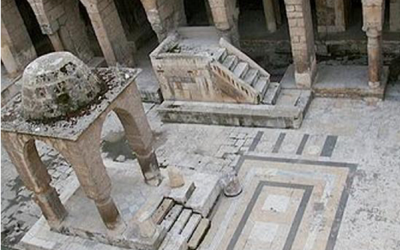
Throughout history and in various geographies, the synagogue became a marker of the Jewish presence and the form changed because of complex interactions among Jewish and non-Jewish communities. These places of worship, which also served as community centers for local communities, were transformed over time in response to a local context. The unique history and design of each synagogue reflects the history of the Jewish community with its ups and downs. The purpose of … continue reading
The history of Judaism in the land of Africa and Asia is a long and storied time, impacting many countries that are relatively close to the city of Jerusalem, and that which is even referenced in the Torah. Thus, the synagogues that have been established in this region range from some of the earliest built structures of its kind, to contemporary ones attempting to bring the structure into the 21st century. The contents of this section will be devoted to an investigation of…
supporting documents: • Quiz with Answers • Lecture Notes • Handout
Judaism has long been a source of contention and extreme hostility throughout the history of Europe. Thus, the evolution of synagogues has been witness to times of construction, destruction, and revitalization throughout the continent. This lecture will focus on the development of synagogues across Europe over the last two millennia. Much of the information presented here will delve into the ethnic and racial diversity that has consumed Europe, the tension that has result…
supporting documents: • Handout • Quiz with Answers • Lecture Notes
When examining the significance of synagogues in the Americas, it is of crucial importance to note that the timeline examined is drastically reduced compared to the aforementioned lectures. With that point in mind, the selection of the case studies below certainly provides much contextual information regarding the spread of Judaism, and the hubs of its observance in the Western Hemisphere. While half of the case studies presented here will come from the 20th century or lat…
supporting documents: • Handout • Quiz with Answers • Lecture Notes
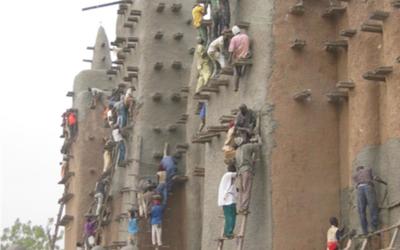
For most of history, reusing existing buildings has been, first and foremost, a matter of common sense and good economics, yet we can presume buildings held community or personal value, as well. Since buildings are the vessels that frame moments in human lives, it makes sense they would hold intangible forms of value for those who spend time in and around them. Historic and older buildings are the physical embodiment of our past, and their accumulation of age and patina is a… continue reading
This lecture will begin with an introduction to historic patterns of building reuse in the pre-modern world, and then transition into the emergence of preservation as a global theoretical construct resulting in wide-ranging local and national policies. Examples of building reuse and preservation can be found throughout pre-modern history, illustrating practical rebuilding and reuse of materials and the historic practice of maintaining and repairing buildings as a common pat…
supporting documents: • Discussion Questions • Handout • Lecture Notes
The lecture will focus on sites in the region of North Africa and the Middle East that share aspects of their cultural histories and today face many of the same threats to their historic sites. This lecture will look at long-standing traditions and impacts of preservation and building reuse through historic patterns, the lens of colonization, the Muslim waaf system that inserts a complexity to preservation through a complex, long-established religious body having purview ov…
supporting documents: • Lecture Notes • Discussion Questions • Handout
This lecture will present some of the many diverse cultural heritage management systems that were used in African communities, formally or informally, including traditional rituals of reuse, religious influences, traditional building methods, poverty, and community influence, as well as continue to explore the context of colonialism on indigenous approaches to preservation and reuse. Themes: Traditional building methods; community preservation; economic development; p…
supporting documents: • Discussion Questions • Lecture Notes • Handout
The regions of West and South Asia have been critically valuable to both western and eastern civilizations due to the constant historic trade routes that brought economic viability and supporting settlements over thousands of years. In South Asia, historic sites are threatened by over -population and growing tourism pressures. Unresolved conflicts in West Asia that have plagued the area over the past several decades have made heritage concerns low among the region’s priori…
supporting documents: • Lecture Notes • Discussion Questions • Handout
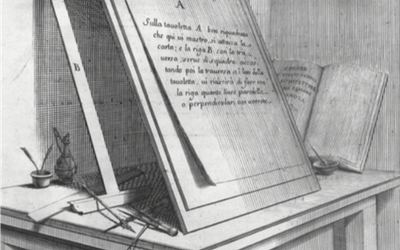
This series of lectures focuses on architectural models and drawings. These representations engender much more than the buildings they may show. They have their own history and development, and they impinge on and reveal broader concerns about how we see the world, how we understand the world, how we communicate ideas in the world, and how we represent and embody those imaginaries. These lectures consider the global history of architectural representations from prehistor… continue reading
This lecture picks up where the previous lecture leaves off. However, it is arranged thematically as well as chronologically. Its purpose is to introduce to students a whole host of other ways that architectural models have and can be used. Covered are representations of models being presented to kings and saints, the development of the working model in the Renaissance, discusses building models, city models, plaster casts, scale and full-size models, and extends discussions…
supporting documents: • Lecture Notes • Handout • Quiz with Answers
This unit is intended to fill a perhaps the largest gap in education regarding architectural representations. These are the earliest architectural drawings. It looks at drawings from around 7000BCE to c. 200CE. It discusses drawings of architecture in relation to drawings for architecture. Ways of looking at and understanding drawings are emphasized. It also brings out issues in studying early architectural drawings and what can be gleaned from them. Their relationship to ma…
supporting documents: • Lecture Notes • Handout • Quiz with Answers
This unit discusses architectural drawings from the middle ages to the present. It does so by focusing on support materials that influenced architectural representations in particular ways. The main sections deal with parchment, paper (this includes graph paper, blueprints, diazoprints), and early experiments in computer aided design. Through specific examples, students should understand that the materials that are used govern what can be produced and the practices of archit…
supporting documents: • Handout • Lecture Notes • Quiz with Answers
This lecture traces the history of the development of perspectival representation and its spread. It initially focuses on Italy and follows the spread of perspective to China. This includes the missionary Matteo Ricci, the artists Castilione, the priest Giovanni Gheradini, the production of the first Chinese book on western perspective Shixue by Nian Xiyao. It also looks at the spread of perspective from China to Korea and Japan.
supporting documents: • Lecture Notes • Handout • Quiz with Answers
This lecture draws on the work of the author and his book Drawing on Architecture: The Object of Lines. Its purpose is to provide a shortened form of the material for educators use in their lectures. It discusses architectural representations – primarily drawings, but also models – as objects imbedded in certain networks that influence the ways that these representations are perceived and understood. It was these networks that developed that naturalized drawings as the ferti…
supporting documents: • Lecture Notes • Handout • Quiz with Answers
This lecture covers the oldest architectural models. It discusses a number of models around the eastern Mediterranean and the “fertile crescent” before moving to examples from the Americas, China, Japan, and Indonesia showing models that stretch across geography and time. Though different models were used very differently, they can most generally be said to occupy a traditional space between states – whether this is between life and death, between enlightenment and corporeal…
supporting documents: • Lecture Notes • Handout • Quiz with Answers
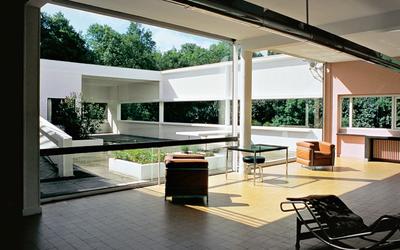
This GAHTC module focuses on the global history of climate as a consideration in architectural ideas and practices. It is intended to operate either as a ‘stand-alone’ subject in relevant courses, or as part of a broader history of global architecture or of architecture and the environment. Through a series of six lectures, the module describes how climatic concerns have developed as an input to architectural design processes in many different global regions. The histori… continue reading
Daniel A. Barber, Jiat-Hwee Chang, Rachel Lee, Ola Uduku, Iain Jackson
supporting documents: • Lecture Abstracts
This lecture provides a launching point into some of the issues involved with tracing an architectural history through the lens of climate. The lecture is divided into two parts. The first addresses the shifting concept of the “primitive” within architectural culture, especially as it was evoked as a symbol for ideas of naturalness and climatic adaptation. The second and third parts, revolving around two case studies, add to this historiographic narrative by introducing the …
supporting documents: • Lecture Notes • Readings
The records of non-western architecture prior to the 19th century are relatively scarce. This is because much of the continental land mass south of Europe’s Iberian region, and coastal North Africa remained unexplored territory to European explorers of the 16th and 17th century. Whilst in global history, from the 16th century, there is a marked increase in inter-continental trade, with new trading and communicating networks being established to support this, the built physic…
supporting documents: • Lecture Notes • Bibliography • Handout • Quiz with Answers
This lecture is concerned with the development and exchange of ideas and principles that have informed the designs of towns, buildings and landscapes in former British colonial territories (late17thC – Mid 20C). We will be looking at what Georg Simmel called the ‘visible institutions of the state’ – that is, those buildings and projects that enabled the British Empire to exist - the very mechanisms for imperial advancement. We will be focusing primarily on four geographical …
supporting documents: • Lecture Notes • Handout • Quiz with Answers
The purpose of this lecture is to demonstrate links between architecture and climate that developed from the late 19th century to the mid-20th century. Part 1 begins by illustrating how attempts to treat and prevent tuberculosis, an urban disease, had a direct impact on the development of architectural typologies and forms. As the treatment of tuberculosis was closely linked to the environment and climate, architects around the world had to design buildings (in the main sana…
supporting documents: • Lecture Notes
This lecture discusses the importance of climate to the development of architectural modernism in the period surrounding World War II. Starting off with some of the basic climatic principles championed by Le Corbusier in the late 1920s, the lecture then discusses developments in Brazil and the United States. A primary focus is on the chains of influence and counter-influence between these different regions, and many others as well, that led to the refinement of the use of sh…
supporting documents: • Lecture Notes • Readings
This is the final lecture of the series. In this lecture, we examine a new technology – air-conditioning – and discuss its sociotechnical and architectural histories, i.e. how it shaped and was shaped by both the society and the built environment. Although this series of lectures is organized in a loosely chronological manner and air-conditioning appears to be the latest instalment in the history of climate control, I argue that the architectural history of air-conditioning …
supporting documents: • Readings • Lecture Notes

Islamic art and architecture, like any other form of art that attempts to characterize the material production of a particular faith or variety of cultures over the longue durée, simply cannot be understood as an autonomous artistic development. Indeed, scholars of Islamic art and architecture, over the past decade or so in particular, have demonstrated that the field is characterized by a dialogic process of development rather than an autonomous or mimetic one that depends … continue reading
Christian A. Hedrick, Mohammed Alkhabbaz
supporting documents: • Bibliography • Syllabus
This lecture begins with an examination of brick and its development and history before Islam. Next, brickmaking and the use of brick is charted through the Islamic culture. The lecture concludes with contemporary uses of brick and the evocative meaning of such use. The history of brick architecture is the history of civilization. With the spread of Islam new urban centers were created, and the technology of making bricks, fired and glazed bricks, transported where Islam…
supporting documents: • Handout • Quiz with Answers • Lecture Notes
One of the most ubiquitous and prolific decorative materials found throughout the history of Islamic art and architecture is the ceramic tile. Tiles in a variety of forms are found throughout the history of Islamic architecture including: those inherited from the Byzantines and Sassanians, the East Asian white porcelain tile, as well as luster tile and faience, to further developments such as overglazing and the discovery of fritware techniques and underglazing. While it is …
supporting documents: • Handout • Quiz with Answers • Lecture Notes
The use of dressed stone in architecture signifies the knowledge of advanced stone working technology. The concept of shaping stones began with the invention of the first stone tools. Those stones were broken and sharpened using other stones through knapping. Stone that has been cut, shaped into a smoother planar form so that stones fit together are called dressed stone. The production of dressed stone requires knowledge about stone properties to determine, or invent, the ap…
supporting documents: • Handout • Quiz with Answers • Lecture Notes
Stucco was first employed in Iran for the primary reason of a lack of building stone. It was used in this way to not only conceal the surface inconsistencies in brick, the dominant building material, but also as a transitional material between various wall surface media. Through decorative ornamentation and geometric patterning inconsistencies in the wall were covered. It soon became a dominant architectural feature firmly associated with the Abbasid caliphate. Howeve…
supporting documents: • Handout • Quiz with Answers • Lecture Notes
It is well known that the pointed arch appears in buildings around the Mediterranean and Central Asia prior to even its adaption by Islam, much less its appearance at St. Denis, Paris in the 12th century. However, despite this, the origins of the pointed arch and the pointed ribbed vault and the paths they traveled across Eurasia before becoming an ‘Islamic’ or ‘Gothic’ architectural characteristic par excellence remain largely a mystery. The intent of this lecture is to ope…
supporting documents: • Handout • Quiz with Answers • Lecture Notes
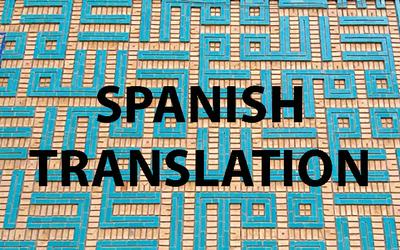
El arte y la arquitectura islámicos, como cualquier otra forma de arte que intente caracterizar la producción material de una fe particular o una variedad de culturas a lo largo de una “longue durée”, no puede entenderse simplemente como un desarrollo artístico autónomo. De hecho, los estudiosos del arte y la arquitectura islámicos, en particular durante la última década, han demostrado que el campo se caracteriza por un proceso dialógico de desarrollo en lugar de uno aut… continue reading
La historia de la arquitectura de ladrillo es la historia de la civilización. Con la expansión del Islam se crearon nuevos centros urbanos y se transportó la tecnología de fabricación de ladrillos, en particular ladrillos cocidos y vidriados, a los nuevos territorios. ¿Qué es ladrillo? ¿Qué hace que un ladrillo sea un ladrillo? Es un material de construcción hecho por el hombre, su componente principal es la arcilla que se extrae de la tierra. La selección de sus componen…
supporting documents: • Lecture Notes • Quiz with Answers • Handout
Nuestra narrativa comienza aquí en la Gran Mezquita de Kairouan. Se presenta en una disposición típica de la llamada “planta en T." Tiene una pared exterior circundante con un gran patio y una sala de oración (hipóstila) que tiene varias naves en su profundidad. Las dos cúpulas sugieren un eje que alinea el robusto minarete cuadrado. En la culminación de este eje debajo de la última cúpula adyacente a la pared exterior está el mihrab - o nicho que indica a los fieles la dire…
supporting documents: • Quiz with Answers • Handout • Lecture Notes
La piedra, junto con la madera, es uno de los materiales de construcción más antiguos que se obtienen fácilmente de la naturaleza. La primera herramienta humana fue de piedra lo que fue un logro tecnológico importante y de empoderamiento. En las cuevas, la piedra proporciona refugio y protección. La piedra es duradera, fuerte y difícil para darle forma. La dificultad en adquirirla, transportarla y moldearla la convierte en un material especial que tiende a la permanencia. Po…
supporting documents: • Quiz with Answers • Handout • Lecture Notes
Los romanos usaban el estuco de forma bastante extensiva para los relieves escultóricos en las paredes interiores de los edificios. Era más barato y más rápido tallar estuco en lugar de piedra. “El estuco y el yeso tienen como base la materia prima de cal o yeso. La cal se produce a partir de la combustión de la piedra caliza a una temperatura de 880 ° C o de la quema de mármol a 1000 ° C. La piedra seca y quebradiza que resulta se convierte en una sustancia fluida y cremos…
supporting documents: • Quiz with Answers • Handout • Lecture Notes
El propósito de esta clase de ninguna manera es probar o refutar ningún origen particular para el 'arco apuntado'. Esta idea, originada en los siglos XVIII-XIX permanece incompleta y muchas de las teorías que permanecen se han derivado a diversos temas y, a menudo, han caído en falacias o reduccionismos ad absurdum. Teorías sobre los orígenes del arco apuntado y la llamada "teoría gótico-sarracena de la arquitectura", por ejemplo, se han escrito en Europa desde al menos med…
supporting documents: • Lecture Notes • Quiz with Answers • Handout

This course presents a series of six introductory lectures describing the characteristics and global history of so-called ‘rock-cut’ architecture, or the subtractive architecture that is embedded within a native geological mass. Such structures are found worldwide, as residences, churches, shrines, meditation spaces, civic structures and tombs – rock-cut architecture occupies a central place in many global civilizations. It even persists into the present day in forms such as… continue reading
Vikramaditya Prakash, Tyler Sprague
supporting documents: • Syllabus • Lecture Abstracts
This lecture will introduce the theoretical basis to ‘chthonic’ work, in contrast with tectonic. Shown as residences, churches, shrines, meditation spaces, civic structures and tombs, rock-cut architecture occupies a central place in many global civilizations - even persisting into the present day in forms such as subway systems, underground market spaces, and the occasional itinerant work of architecture. In ‘rock-cut’ architecture, the structure is deeply integrated with…
supporting documents: • Handout • Lecture Notes • Quiz with Answers
This lecture provides an interpretation of the Pharoanic architecture of the Nile River valley through the lens of the chthonic. Beginning with the Old Kingdom, this lecture argues that the iconic forms – from the mastaba to the stepped pyramid, and eventually to the great pyramid complexes of Cheops - are proto-chthonic ‘mountains’ created over burial sites: Pyramids as shaped mountains, in conversation/ on cross axis with the flowing water of the Nile. During the middle K…
supporting documents: • Lecture Notes • Handout • Quiz with Answers
Concurrent developments in Mesopotamia display similar chthonic roots. Beginning with the ziggurat form as a ‘sacred mountain’ – a mass containing the source of all life, reaching towards the sky with labyrinth-like passages and openings. In Persia, this sensibility is evident in the Tomb of Cyrus outside of Pasargarde – an assembled stone mass that mimics the earlier ziggurats. Like the Egyptians, the Persians then transitioned to rock-cut tombs for Darius, Xerxes, and…
supporting documents: • Lecture Notes • Handout • Quiz with Answers
The Persian Empire had a massive influence over the rising Mauryas in India. After the conquest of Persepolis by Alexander, the craftsmen and thinkers of Persia migrated East to India – taking their expertise and aesthetic ideology with them. Stone pillars with animal capitals transitioned directly, while other forms had a more tangential influence. The rock-cut tombs and treasuries of West Asia, may have been the direct precedent for the first Buddhist and Jain caityas a…
supporting documents: • Handout • Lecture Notes • Quiz with Answers
The main theme is the concept of the ‘chthonic-ecology’, where the body of the earth is understood as a living system - soil, earthquakes, snow, water, sun, air interdependencies - that can be characterized as ecology in the modern sense of the word. This is chthonic architecture not as the ‘rock-cut’, as in Afro-Eurasia, but the chthonic as a complete understanding of landscape and the environment: a chthonic ecology. The lecture begins with the chthonic forms of the Puebl…
supporting documents: • Lecture Notes • Handout • Quiz with Answers
This lecture explores the unexpected appearance of rock-cut architecture in more modern context. As we have seen, the chthonic idea flourished as architecture in pre-modern times. With the onset of modernity, the longstanding separation of the native ground from the capital-A architecture became dominant, particularly with the ascent of the functionalist, materialist and tectonic contentions of architecture. As per the expectations of the European Enlightenment, the empowere…
supporting documents: • Handout • Lecture Notes • Quiz with Answers
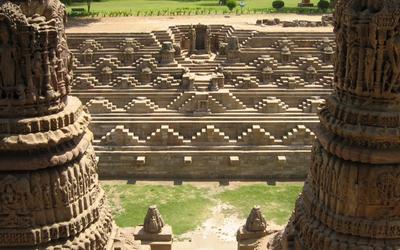
This course presents a series of 7 introductory lectures locating the pre-islamic architecture of sub-continental south Asia in its global context. The emphasis in this module is not on identifying the characteristics that supposedly make the architecture of South Asia distinctive ‘Indian’ or ‘Hindu’, but to understand a. what the characteristics and meanings of so-called Indian architecture are, and b. to locate these in terms of their local and global contexts. My goa… continue reading
This lecture addresses the question of the ‘beginnings’ of South Asian civilization. It locates the migrations out of Africa that ‘settled’ South Asia, and then traces the context of the art and architecture of the cave dwellers, with focus on Bhimbetka, a centrally located pre-historic site (this section can be presented in context with the GAHTC lecture module on the Architecture of the First Societies, by M. Jarzombek). The lecture then moves to the contexts of the establ…
supporting documents: • Lecture Notes • Handout • Quiz with Answers
This lecture focuses on the Aryas, and in particularly their metaphysics as manifested in their architecture. The lecture begins with a discussion of the controversial Arya Migration Theory, and its racist sub-texts, and attempts to distinguish that from the globally situated understanding of the migratory influences on cultural development, in particular in South Asia. This leads to a discussion of the making of Arya cities in the Gangetic plain, and what connects and disti…
supporting documents: • Quiz with Answers • Lecture Notes • Handout
This lecture is the first of two parts that explore the forms of Buddhist architecture, their relationship to trade, and their proliferation in the Asian world. In this sequence, this lecture discusses the establishment of Buddhist architecture under Emperor Asoka in the 3rd century BCE, and its spread in South Asia and south East Asia. The main architectural object of discussion is the ‘stupa’. The lecture begins with the rise of the Mauryan Empire and its relationship …
supporting documents: • Handout • Quiz with Answers • Lecture Notes
This lecture combines two topics – a. the institutional transmission of Buddhist thought from centers of intellectual production in India, and b. the role of the Caitya in the transmission of Buddhism into East Asia, along the trade routes. The lecture begins by establishing the mahavihara, the Buddhist ‘university’ that was a systematic site for the production and teaching of advanced Buddhist knowledges. From here the lecture moves to the study of the practical institut…
supporting documents: • Quiz with Answers • Lecture Notes • Handout
This lecture is dedicated to the development of Hinduism in the Guptan period in South Asia. This development took place in the context of the ongoing spread of Buddhism throughout Asia, which has been covered in other lectures. Usually, the Guptans are held responsible for the ‘demise’ of Buddhism in India, its home of origin. By contrast this lecture will argue that the Guptas, who were generous patrons of the Buddhists in their realms, sought to revive Hinduism, in harmon…
supporting documents: • Handout • Lecture Notes • Quiz with Answers
This lecture explores the development of the temple concept in the South Asian world affected by the Guptan invention of the structural, in particular focus on the peninsular Indian kingdoms of the Pallavas and the Chalukyas. In the process of ‘adopting’ the Guptan institution of the Hindu temple, these kingdoms did not simply cut-and-paste the new orthodoxy, nor did they produce a regional adaptation, in the sense that they ‘localized’ principles that were abstract and clai…
supporting documents: • Quiz with Answers • Lecture Notes • Handout
This lecture focuses the relationship between Hindu temples and administrative systems. It begins with a discussion of the polity and architecture of the Rajputs of northern India, the ‘new’ kings, converted from first-societies practices into ‘caste’ Hindus. We study the new manuals of temple building – the Vastu-Shastras – and some of their famous architectural creations. The Bay of Bengal/SE Asian geo-sphere around the year 1000CE. The Bay of Bengal and the Indian Oce…
supporting documents: • Handout • Lecture Notes • Quiz with Answers
This is a discussion of the Khmer socio-economic matrix in terms of its innovation of Cholan kovil practices. It outlines the hydro engineering and the social systems that were integrated by the Khmer to create a uniquely powerful polity in SE Asia. The main case study is Vrah Vishnulok (Angkor Wat), which can be understood as a spatialization of Mouth Meru, here adapted to the local geographical conditions.
supporting documents: • Handout • Quiz with Answers • Lecture Notes
This lecture addresses the so-called establishment of Islam in South Asia. While colonial texts usually identify the invasions of Mohammand Ghazni and Ghori around 1000CE as the beginning of Islam in India, this lecture contends that these are colonial projections, and that the actual story of Islam and south Asia goes back to the older ongoing trade between West Asia and South Asia. This lecture then examines the architecture of the Delhi Sultanates, a series of short lived…
supporting documents: • Handout • Lecture Notes • Quiz with Answers
The concept of this lecture is to discuss the Mughal tomb. It focuses on the Taj Mahal and its precedents.
supporting documents: • Quiz with Answers • Lecture Notes • Handout
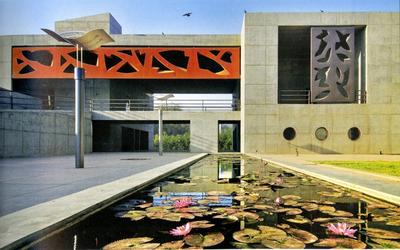
These five lectures revisit architectural histories (itihasas) of the Indian Subcontinent from multidisciplinary, cross-geographical, and interpretive perspectives, supported by a new body of scholarship and archaeological data. The word for “history” in Sanskrit is itihasa, which has traditionally meant “that’s what happened” or “so indeed it was.” Yet, iti (as in itihasa) is often used in a Sanskrit sense of “end quote.” Itihasa, therefore, in its traditional usage has oft… continue reading
These lectures revisit architectural histories (itihasas) of the Indian Subcontinent from multidisciplinary, cross-geographical, and interpretive perspectives, supported by a new body of scholarship and archaeological data. The word for “history” in Sanskrit is itihasa, which has traditionally meant “that’s what happened” or “so indeed it was.” Yet, iti (as in itihasa) is often used in a Sanskrit sense of “end quote.” Itihasa, therefore, in its traditional usage has often be…
supporting documents: • Quiz with Answers • Bibliography • Lecture Notes
This lecture examines Mughal architecture, one of the most vibrant and dynamic architectural eras in India. The Mughal dynasty was established in 1526 CE by Babur, descendant of the Timurid Mongols. A Muslim dynasty of Turkic-Mongol origin, the Mughals ruled most of northern India from the early 16th to the mid-18th century. During its imperial rule stretching over more than two centuries, the Mughal Empire created a spectacular body of mausoleums, mosques, palaces, and gard…
supporting documents: • Bibliography • Quiz with Answers • Lecture Notes
This lecture focuses on the early colonial era of the British Raj and explains how British artists in the 18th and 19th centuries imagined India in ways that were complicit with imperial domination and the creation of Britain’s image of India. After the East India Company’s victory over the Nawab of Bengal in the Battle of Plassey in 1757, British artists eager to “discover” the newly conquered territory in the East had begun arriving in India. Among them were such renowned …
supporting documents: • Quiz with Answers • Bibliography • Lecture Notes
A “Global” History of South Asia (3000 BCE – 2000 CE) This lecture examines how the British Raj employed the language of architecture during its colonial rule of India to project an image of Britain as the leader of the “civilized” world and assert the authority of the empire. In many ways, the colonial administration viewed architecture as an integral part of its ideological approach of “civilizing mission.” However, a singular narrative of the architecture of empire didn’…
supporting documents: • Bibliography • Quiz with Answers • Lecture Notes
This lecture examines the how the newly minted nations of India and Pakistan negotiated the questions of national identity and modernism through the language of architecture. In the wake of the Indian Partition in 1947, these nations looked both outward and inward for inspiration, marked by an urge to construct an image of progress, modernity, and nationalism. But, as Salman Rushdie’s celebrated novel, Midnight’s Children (1981), reveals how the traumatic experience of birth…
supporting documents: • Quiz with Answers • Bibliography • Lecture Notes
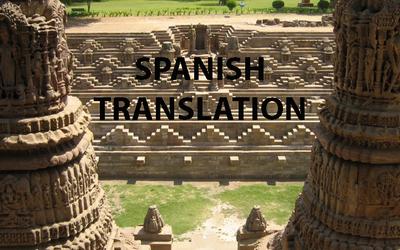
Este curso presenta una serie de 7 clases introductorias que ubican la arquitectura preislámica del sur del subcontinente Asiático en su contexto global. El énfasis en este módulo no está en identificar las características que supuestamente hacen que la arquitectura del sur de Asia sea distintiva como "india" o "hindú", sino para entender a. cuáles son las características y significados de la llamada arquitectura india, y b. ubicarlos en términos de sus contextos locales … continue reading
El concepto de esta clase es discutir la tumba Mogola. Se enfoca en el Taj Mahal y sus precedentes.
supporting documents: • Quiz with Answers • Handout • Lecture Notes
Esta clase aborda la cuestión de los "comienzos" de la civilización del sur de Asia. Localiza las migraciones fuera de África que se "asentaron" en el sur de Asia, y luego rastrea el contexto del arte y la arquitectura de los habitantes de las cavernas, centrándose en Bhimbetka, un sitio prehistórico céntrico (esta sección se puede presentar en contexto con el módulo GAHTC sobre la Arquitectura de las Primeras Sociedades, por M. Jarzombek). Luego, la clase pasa a los context…
supporting documents: • Quiz with Answers • Handout • Lecture Notes
Esta clase se centra en los Arios, en particular su metafísica y como se manifiesta en su arquitectura. La clase comienza con una discusión sobre la controvertida Teoría de la Migración Aria, y sus subtemas racistas, e intenta distinguir ello de la comprensión globalmente situada de las influencias migratorias sobre el desarrollo cultural, en particular en el sur de Asia. Esto lleva a una discusión sobre la construcción de las ciudades Arias en la llanura del Ganges, y lo qu…
supporting documents: • Quiz with Answers • Handout • Lecture Notes
Esta clase es la primera de dos partes que exploran las formas de la arquitectura budista, su relación con el comercio y su proliferación en el mundo asiático. En esta secuencia, esta clase trata acerca del establecimiento de la arquitectura budista bajo el emperador Asoka en el siglo tercero antes de Cristo, y su difusión en el sur de Asia y el sudeste asiático. El principal objeto arquitectónico de discusión es la 'estupa'. La clase comienza con el surgimiento del Imper…
supporting documents: • Quiz with Answers • Handout • Lecture Notes
Esta clase combina dos temas: a. la transmisión institucional del pensamiento budista desde los centros de producción intelectual en India, y b. el papel de la Chaitya en la transmisión del budismo al este de Asia, a lo largo de las rutas comerciales. La clase comienza estableciendo el mahavihara, la "universidad" budista que era un sitio sistemático para la producción y enseñanza de conocimientos budistas avanzados. Desde aquí, la clase pasa al estudio de las institucion…
supporting documents: • Quiz with Answers • Handout • Lecture Notes
Esta clase está dedicada al desarrollo del hinduismo en el período Gupta en el sur de Asia. Este desarrollo tuvo lugar en el contexto de la expansión del budismo en toda Asia, que se ha tratado en otras clases. Por lo general, se ha entendido que los Gupta son responsables de la "desaparición" del budismo en la India, su hogar de origen. En contraste, esta clase explica que los Gupta, que fueron generosos mecenas de los budistas en sus reinos, buscaron revivir el hinduismo, …
supporting documents: • Quiz with Answers • Handout • Lecture Notes
Esta clase explora el desarrollo del concepto de templo en el mundo del sur de Asia afectado por la invención Gupta, en particular el enfoque en los reinos indios peninsulares de los Pallava y los Chalukya. En el proceso de 'adoptar' la institución Gupta del templo hindú, estos reinos no simplemente “cortaron y pegaron” la nueva ortodoxia, ni produjeron una adaptación regional, en el sentido de que 'localizaron' principios que eran abstractos y universales. Este no es un mod…
supporting documents: • Quiz with Answers • Handout • Lecture Notes
Esta clase enfoca la relación entre los templos hindúes y los sistemas administrativos. Comienza con una discusión sobre la política y la arquitectura de los rajput del norte de la India, los "nuevos" reyes, surgidos de las prácticas de las primeras sociedades hindúes de "castas". Estudiamos los nuevos manuales de construcción de templos, los Vastu-Shastras, y algunas de sus famosas creaciones arquitectónicas. La geoesfera asiática de la Bahía de Bengala / SE alrededor d…
supporting documents: • Quiz with Answers • Handout • Lecture Notes
Esta clase es una discusión de la matriz socio-económica de los Jemer en términos de su innovación de las prácticas Kovil Chola. Describe la ingeniería hidráulica y los sistemas sociales que fueron integrados por los jemeres para crear una política única y poderosa en el sudeste asiático. El estudio de caso principal es Vrah Vishnulok (Angkor Wat), que se puede entender como una espacialización de Monte Meru, aquí adaptada a las condiciones geográficas locales.
supporting documents: • Quiz with Answers • Handout • Lecture Notes
Esta clase aborda el llamado establecimiento del Islam en el sur de Asia. Mientras que los textos coloniales generalmente identifican las invasiones de Mohammand Ghazni y Ghori alrededor de 1000 DC como el comienzo del Islam en la India, esta clase sostiene que estas son proyecciones coloniales, y que la historia real del Islam y el sur de Asia se remonta al comercio entre Occidente Asia y Asia del Sur. Esta clase luego examina la arquitectura de los Sultanatos de Delhi, una…
supporting documents: • Quiz with Answers • Handout • Lecture Notes
Global History of Water Architecture: Islamic architecture in Maghreb and the Mediterranean Basin (7th to 18th century)

Accessing, controlling, distributing water and benefiting from water in various aspects — from energy to freshness — have developed broad categories in architectural history, urbanism and engineering, forming human spaces designed for or with water. This is what we call "Water Architecture", emerging in many different types of buildings and urban settlements all around the world. Design and construction of settlements, development of civilizations integrated with this vital … continue reading
Early Islamic water architecture made an extensive use of existing traditions prior to the conquest, which originated from two main sources, the Orient and the Mediterranean Basin. All along Maghreb’s shores Islam developed a unique water architecture tradition combining know how imported from the three neighboring continents of the Mediterranean basin, Africa, Asia (mainly Mesopotamia and Persia) and Europe (mainly Greece and Roman empire). Islam rulers proved their powerfu…
supporting documents: • Handout • Lecture Notes • Quiz with Answers
With the long history of roman civilization in the region, particular typologies of hydraulic systems and related architectural facilities were introduced in Maghreb and south Europe during the Muslim conquest. From ingrutatti to khettara and from souterazi to aqueduct, hydraulic architecture in this region shows deep integration and testifies intense transmission flows between eastern and western technologies and architecture during the Islamic period. This lecture is dedic…
supporting documents: • Handout • Lecture Notes • Quiz with Answers
This lecture introduces the oasis settlement as a genuine geographical, physical, architectural, social and urban model based on specific hydraulic systems showing the human ability to adapt to the harsh living conditions of arid regions. By focusing on the history of oases through number of examples, the lecture covers the stages of oasis development, its hydraulics, agriculture, nomadic and sedentary habitat. Their habitants developed a unique knowledge in water systems, i…
supporting documents: • Handout • Lecture Notes • Quiz with Answers
From Herat (Afghanistan) to Sevilla (Spain), from Damas (Syria) to Fez (Morocco), Islam was able to build very large architectural and urban structures, yet there is no single Islamic city model. While early Islamic urbanism was indeed often tied to pre-existing settlements, a constant reference to Islam’s Arabic origins can be found. All around north Africa and south Europe under the Islamic reign, the dense and fortified settlements which are known as Medina were developed…
supporting documents: • Handout • Lecture Notes • Quiz with Answers
At the scale of the architectural edifices, water had also particular roles in space making. These roles were varying in degrees, from functional to aesthetical functions. In both religious buildings and private houses, public spaces and courtyards, water fountains and basins showed the pivotal role that water played in spatial organization of these places. This role became more visible in gardens and palaces, where architecture was totally integrated to water. The lecture …
supporting documents: • Handout • Lecture Notes • Quiz with Answers
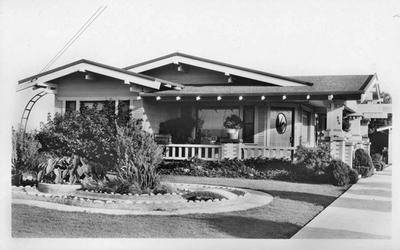
This module of two lectures looks at global influences in the shaping of common suburban housing forms and domestic landscapes in the United States between the late nineteenth century and the early twenty-first century. The lectures look at two common domestic forms in the US – the late nineteenth and early twentieth-century bungalow and the mid-twentieth-century, minimum, free-standing, single-family house – to explore the influence of colonialism, global economies, and deb… continue reading
The first lecture introduces the theme of the standardization of culture in tandem with the emergence of an increasingly global economy in the late nineteenth century and the associated cultural transformations of capitalism on housing culture in the US and the West. The vernacular Bengali bungalow and its Western diffusion illustrate these themes in the late nineteenth and early twentieth centuries. The lecture traces the adoption and adaptation of the bungalow from its ori…
supporting documents: • Handout • Lecture Notes • Quiz with Answers
This lecture explores the connection between single-family home ownership and the ideals of democratic capitalism through the development, proliferation and eventual exportation of the American minimum house. The content introduces the development of the American minimum house and related economy housing programs in the US in the post-World War II period as part of a broader campaign of housing reform and political activism among capitalist builders and within US housing pol…
supporting documents: • Quiz with Answers • Lecture Notes • Handout

The current global pandemic regarding COVID-19 is actively re-shaping many features of contemporary life, with significant implications for the built environment. Past pandemics have similarly re-oriented the uses and perceptions of public space, health care infrastructure, domestic spaces, and fundamentally altered the social contracts of urban life. This module provides educators with architectural histories of past pandemics throughout the globe. Inclusive of many diff… continue reading
Communicable diseases existed during humankind’s first society (hunter-gatherer) days, but the shift to agrarian life 10,000 years ago created communities that made epidemics more possible. Early illnesses were limited in their geographical scope, but were devastating in small communities. With the emergence of global empires, pandemics followed in China, Egypt, Greece and Rome. This lecture includes the origin of the term ‘epidemic’ and ‘pandemic’ – in Greece, linked dire…
supporting documents: • Lecture Notes • Quiz with Answers
This lecture begins with the reemergence of Europe during the so-called “Renaissance”, and new mechanisms of transmission due to trans-Pacific travel. Decimation of the native American population played a key role in an emerging global order. The first use of the term quarantine – coming from the Italian quarantena meaning forty days, as the time required to hold a ship in harbor became an accepted response to the Black Death. Conceptions of disease as miasma – or bad air …
supporting documents: • Lecture Notes • Quiz with Answers
This lecture discusses pandemics in the context of rapid modernization and industrialization in an interconnected globe, and the beginning of modern epidemiology. John Snow, Joseph Bazalgette & Edwin Chadwick improved the urban sanitation of London in the mid 19th century during the “Great Stink.” Florence Nightingale as the founder of modern nursing fundamentally changed care practices. Cholera and the Spanish flu mirrored expanding global networks, yet revealed distinct…
supporting documents: • Lecture Notes • Quiz with Answers

This course proposes to analyze the global turn as it relates to the industrial revolution and the regimes of circulation of goods and commodities, knowledge, experts, techniques, people, and labor that it introduced and supported. We contend that these regimes posed new challenges to the discourse and practices of modern architecture that yielded substantial innovations during the mid nineteenth century that changed and consolidated in the second half of the twentieth centu… continue reading
supporting documents: • Syllabus • Discussion Questions • Lecture Abstracts • Quiz with Answers
We identify and discuss the contribution of world exhibitions and fairs to global production and consumption of good and commodities as it relates to the emergence of new spaces of display and commercial collectivity. Case studies range from the Crystal Palace at the Great Exhibition of London (1851) to the urban department stores of Europe (Innovation by Victor Horta in Brussels and Schocken by Erich Mendelsohn in Germany) and suburban shopping malls in the post world war t…
supporting documents: • Lecture Notes • Handout
We identify modes of knowledge creation and dissemination in different media over time. Whereas travel was the most important source of direct learning during the eighteenth and first half of the nineteenth century, the proliferation of printed matter and photography expanded the possibilities of learning from afar and was eventually even more radically transformed by the advent of the digital revolution. When travel was not possible, the plaster cast functioned as a surroga…
supporting documents: • Lecture Notes • Handout
As education moved from in-situ learning to spaces of collectivity, so too did opportunities for architects and students of architects to converge into the transcultural classroom. If colonialism promoted exchanges between nations, it was not until nationalism asserted itself that institutions began to formalize education. Together with the increased media, this lead to the rise of greater networks of collaboration and the rise of the international competition.
supporting documents: • Lecture Notes • Handout
Here, the question is: How can construction practices be regarded as global processes? We identify and analyze a series of producers of products alongside the emergence of new construction techniques and technologies. This lecture aims at illustrating the increasingly complex circulation of different materials and methods that go against the grain of the traditional vernacular ideal of sourcing local materials that has recently re-gained momentum within the ‘green’ and envir…
supporting documents: • Lecture Notes • Handout
Dramatically increased mobility throughout the last century has generated both increased dialogue and new types of buildings that have accommodated new forms of transport ranging from air and train to automobiles. This phenomenon has given way to a number of diverse types of buildings including the Motel, Hotel, Airport, and Train Stations.
supporting documents: • Lecture Notes • Handout
The building industry has increased relied upon labor moved across geographies that reveals the economic disparities between regions and cities of the global north and south. These exchanges reveal the paradoxes between the virtual and real insofar as the needs of actually building in specific places go counter to the global circulation of ideas and capital.
supporting documents: • Lecture Notes • Handout
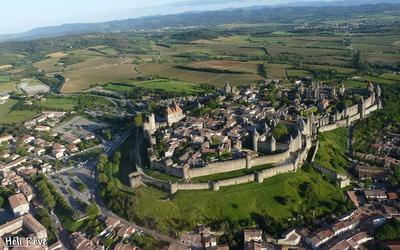
Appreciation develops from understanding. The goal of this course is to introduce and foster an understanding of architecture as a central component of the built environment and of the ways in which architecture exemplifies cultural values. Architecture is all around us and part of our daily lives. It refers not only to buildings: architecture is human settlement, the physical settings made by humans for their traditions, rituals, living, working, and community-buildin… continue reading
This course serves as an introductory course to the history of ancient built environments. We will become familiar with the language of built environments including the vocabularies of architecture, landscape architecture, and urban design. We will also be introduced to ideas that have shaped the cultures we know today, from the Western Culture of Europe to that of China, India, and some of the many cultures of the African continent. This is a survey course and an introduct…
supporting documents: • Handout • Lecture Notes
Today's monuments range geographically from Korea to France, England, Ireland and Egypt, and in date from the 5th to the 1st millennia BCE. What unifies them is their use of stone - used for a range of building types that speak to a human desire to provide enduring monuments on the landscape. While we may have monuments that have endured from very early dates, we don't always have full knowledge of why they were built or what purpose they served. Our earliest examples tod…
supporting documents: • Lecture Notes • Handout
Lecture 3 continues an examination of materials and explores the broader context within individual monuments were sited, looking at the settlements that preceded the emergence of cities, which will be the topic of Lecture 4. With these we address several among the sites of the world's earliest civilizations, in Mesopotamia, Egypt, India, China and Mesoamerica.
supporting documents: • Lecture Notes • Handout
While small villages comprised the earliest settlements, we can also identify the beginnings of early urban settlements if we define urban as a center of population, commerce, and culture - a town of significant size and importance. We can recognize these settlements as constituting a series of networks, from social networks and governmental systems to modes or systems of commerce, trade, and production. A city is the result of urbanization, which can be thought of as a pro…
supporting documents: • Lecture Notes • Handout
This is the first of two lectures that focus on architecture and ritual, exploring the ritual spaces and architectural forms that developed along with enduring religious traditions of Hinduism and Buddhism. These religions both originated in the Indian subcontinent and were later exported along trade routes, taking hold across Asia. Both symbolically and architecturally, the religious monuments we'll now explore demonstrate strong ties to the landscapes of their settings.
supporting documents: • Lecture Notes • Handout
This lecture is the first of a sequence of two lectures that focus on the building of empire, looking at the empires established in Rome, China and Central (or Meso-) America. We will look at the architectural forms and effects on the built environment of these political systems. In the case of Rome and China we are discussing vast territorial holdings and long durations - and we have a great deal of information about each of these empires. The situation in Central Americ…
supporting documents: • Lecture Notes • Handout
This lecture will focus on the building of empires, how were the empires manifested in the built environment? We have looked at Rome and then moved to Meso or Central America, where we will pick up today and finally to China. These were distinct empires, sharing characteristics but as with all of the built environments we have studied, there are specific response to place, to landscape, to environment, to culture, and to practices including trade, politics, and power. Th…
supporting documents: • Lecture Notes • Handout
This lecture will focus on the question of how did secular developments and trade influence the form of cities in the later medieval period? The increasing importance of cities as places of trade, commerce, defense, and culture is a development that parallels the rise of Gothic architecture in Europe. A part of the rise of the city reflects the growing significance of building and environments that are not tied to the church or to religious institutions but instead serve …
supporting documents: • Lecture Notes • Handout

In his treatise ‘The Nature of Gothic’, the 19th-century English writer and theoretician John Ruskin outlined Gothic architecture as a movement embedded in a social agenda. Gothic, dedicated to the love of change and workmanship, became a protagonist against classicism, which orders the direct reproduction of idealized form, or, as Ruskin posits, “makes plagiarists of its architects and slaves of its workmen.” In Ruskin’s scheme, Gothic and Classicism are not passé styles, b… continue reading
Gothicness surrounds the transformation of ribs from singular to multiple. Nowhere is this more distilled than in the column pier. The story of Pierness follows a progression from few to many through three distinct typologies—column, clustered column, and compound pier; however, this story is peppered with intrigue. The details, figuration, and configuration of gothic piers reflect larger architectural conditions. This lecture briefly outlines how these transformations manif…
supporting documents: • Bibliography • Handout • Lecture Notes • Quiz with Answers
A springer is the first stone above a column in an arch, and the springing point is the moment of transition between the logic of support and that of load. The concept of the springing point is open to expansion; for instance, it may refer to a branching moment from primary to tierceron ribs in a vault (see Vaultness), or countless other examples where few need to multiply into many. Because the springing is fundamentally a transition moment, it encompasses the continual str…
supporting documents: • Bibliography • Handout • Lecture Notes • Quiz with Answers
A logical progression of vault typologies is as follows—Barrel, Groin, Rib, Liernes, Fan. But while 'progression' implies a direction and single endpoint, our story of Vaultness is cyclical. Pre-Gothic vaults are created by extruding an arch into a continuous surface (barrel) or by extruding in perpendicular directions (groin). Both are constructed in a manner similar to a masonry wall—homogenous stone from end to end. The groin is the intersection cusp between the two extru…
supporting documents: • Handout • Lecture Notes • Quiz with Answers • Bibliography
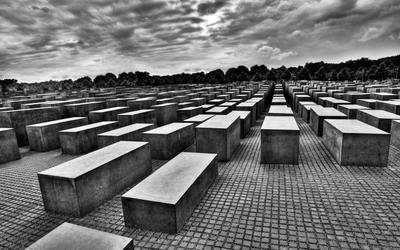
This course aims to introduce the growing importance of cultural heritage and historic preservation. Over the past decades, fostered not the least through international organization like UNESCO’s World Heritage Center or the New York based World Monuments Fund, heritage preservation has become a global movement. Following a historical and comparative perspective the course seeks to go beyond the Euro-American understanding of architectural heritage which is still very much … continue reading
Peter Probst, Michelle Moore Apotsos, Brinker Ferguson
supporting documents: • Syllabus • Lecture Abstracts
This lecture introduces both the notion and the dynamics of heritage as a global movement. Starting with Rem Koolhaas’ provocative statement “preservation is overtaking us”, the lecture aims to show why heritage has become an important topic for architects and architectural historians. For this the lecture focuses on three different forces: urbanization, tourism and identity.
supporting documents: • Handout • Lecture Notes • Quiz with Answers
The aim of this lecture is to explore the emergence of preservation and conservation as public policy activities in Europe. Following the argument that preservation is a modern undertaking, it shows how preservation practices emerged from both the political and the industrial revolution. The lecture is divided in five parts. The first part introduces the topic by questioning the universality of preservation. The second part discusses the interest in documenting antiquity in …
supporting documents: • Quiz with Answers • Lecture Notes • Handout
This lecture explores the internationalization of the preservation movement as a “modern cult” (Riegl). It is organized into three parts: the first part deals with the global expansion of the “cult” in the context of World Fairs. The second part addresses responses to WWI in terms that addressed issues related to technology and functionality in the realm of architecture and preservation. The third part focuses on the “Salvage of Abu Simbel” – the celebrated showcase of UNESC…
supporting documents: • Handout • Lecture Notes • Quiz with Answers
This lecture discusses the political dimension of the UNESCO World Heritage Convention as a legal contract between the UNESCO and the individual member states that have signed the convention. The first part explains the background of the convention. The second part explains how the convention actually works. The third part addresses the challenges the World Heritage Convention is facing.
supporting documents: • Handout • Lecture Notes • Quiz
This lecture discusses the tensions and frictions that arise when heritage infringes upon the life of those living in and with heritage sites. At the center stands the conflict between object-focused experts and the national government issuing the laws regulating preservation, and the local communities where preservation is enacted. In other words, as much as heritage can be a matter of national pride it can also be a source of conflict over ownership. Once again the questi…
supporting documents: • Handout • Lecture Notes • Quiz with Answers
This lecture will address issues surrounding architectural materiality, and the way in which materiality is factored in into strategies of architectural preservation that are filtered through memory. Many of these themes also relate to the rather ambiguous concept of authenticity, particularly with regards to the role that materiality plays in the establishment of what might be considered the “genuine” or the “original” character of an architectural form. This module will fo…
supporting documents: • Handout • Lecture Notes • Quiz
This lecture will address issues surrounding the immaterial and the question of “intangible” heritage with regards to how conceptual, not physical, elements such as memory, orality, and historical practice play a role in strategies of architectural preservation. Many of these themes also (again) access the rather ambiguous concept of authenticity, particularly with regards to the role that the proceedings of the 1994 Nara Conference played in highlighting the necessity of br…
supporting documents: • Handout • Lecture Notes • Quiz with Answers
The lecture focuses on the different forms, types and value criteria when discussing heritage and preservation. Is “value” rooted in the architectural object or in the quality of the relationships enabled by the object? Or is “value” first and foremost an economic asset that needs to be judged in terms of the amount of revenue that a particular heritage is able to generate? Since heritage is a heterogeneous concept, it is not surprising that the notion of value in heritage p…
supporting documents: • Handout • Lecture Notes • Quiz with Answers
This lecture will address issues surrounding the multiple and entangled functions of heritage in cases where issues of trauma, disenfranchisement, and oppression make up a large part of a structure’s narrative. It will focus specifically on the politics of cultural identity, recognition, and social remembrance and how heritage conservation, especially with regards to “difficult heritage,” can never just be concerned with the preservation of the physical structure, but also a…
supporting documents: • Handout • Lecture Notes • Quiz with Answers
This lecture looks at the relationship between heritage and property on a national, global and local level. In doing so, it seeks to explore the relationship between heritage and the power of control. Ownership of heritage gives the right to control access to places, as well as and the information people are allowed to know once they are at a particular site. We will look into several key concepts and ideas including repatriation, the right to preserve a particular version o…
supporting documents: • Handout • Lecture Notes • Quiz with Answers
This lecture will address issues surrounding architectural mimicry, and the roles this approach to structural form plays in reimagining heritage, tradition, and authenticity. It also provokes discussions concerning the idea of architectural heritage as not only unique and one-of-a-kind, but also fundamentally place-based with its originality fundamentally embedded in a specific time / place matrix as a requirement for the establishment of what might be considered the “genuin…
supporting documents: • Handout • Lecture Notes • Quiz with Answers
This final lecture considers both heritage and its documentation, specifically around 20 and 21st century “digital heritage” and digital capture technologies. We will look at the emergence of “digital heritage”, the most recent UNESCO category of heritage with its own unique form of conservation and preservation. Two case studies will be able to address several themes, including memory, authenticity, and preservation.
supporting documents: • Handout • Lecture Notes • Quiz with Answers
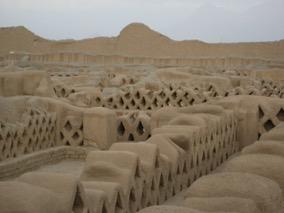
This module encourages a closer look at the emergence of architectural commonalities and differences within the span of a “time cut.” By discussing examples of architectural innovations representing different parts of the world, we hope to better understand how social, cultural, and economic interactions on a global scale are essential pieces that form our global history and the manner in which architectural production is always triangulated by the exigencies of time and loc… continue reading
Vikramaditya Prakash, Deepthi Bathala
supporting documents: • Bibliography • Lecture Abstracts
Columbus’ infamous voyage to the Americas took place by the end of the 15th century, an event often lauded as a “discovery” and the beginning of a new age. However, if we tell the stories of global human interaction as one beginning with the European “Age of Exploration,” we miss the dynamic shifts that were taking place technologically, economically, and culturally elsewhere in the world that make up the fabric or serve as catalysts for global expansion. These lectures aim …
supporting documents: • Handout • Lecture Notes • Quiz with Answers
By the 17th century, the Eurasian world from Japan to Western Europe was a contiguous economic power bloc connected by well-established cross-country and coastal trade. From one end to the other, wealth and ideas traveled in the baggage or minds of traders, migrants, and armies. This was the Old-World order that was now increasingly undermined by the newly arising and more efficient ocean trade. Eventually by the 19th century, the advantages of the ocean routes, the unpreced…
supporting documents: • Quiz with Answers • Handout • Lecture Notes
By the early 18th century, the Eurasian Power Bloc became increasingly marginal to the new maritime port economy that was set up and controlled by Western European colonial powers. This maritime colonial project was a global phenomenon intrinsically linked with the institutionalization of race-based slavery. At the foundation of this global system were sites of fortified enclosure and of labor. Both the fort and the plantation greatly transformed the social, cultural, and en…
supporting documents: • Handout • Lecture Notes • Quiz with Answers
The time cut 1800 is a watershed moment in terms of the advent of modernity. While Europe was quickly increasing in global strength and power, China was still the world’s largest power in 1800. This lecture discusses the world in the midst of a radical transformation that was deeply connected to social and industrial revolutions. In particular, this lecture discusses the impact of the American and French revolutions on Enlightenment ideas, resulting in the first set of democ…
supporting documents: • Handout • Lecture Notes • Quiz with Answers
This lecture discusses the influential manifestation of the European Beaux-Arts ideal in America through the City Beautiful Movement and its far-reaching effects in America’s most recent imperial acquisition: the Philippines. Also discussed is Germany’s war with a world that had grown powerful on colonial riches: World War I. The fallout of World War I permanently cleared out all vestiges of the pre-industrial, pre-colonial world and ultimately even spelled the death of the …
supporting documents: • Handout • Lecture Notes • Quiz with Answers
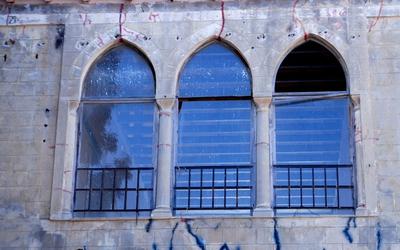
The chronicles of the architecture and urban planning in Israel and Palestine is the story of the local national, political and social struggles. Strategically located between three continents and functioning as the religious center for various creeds, the area has been conquered and inhabited by numerous groups; all of which have left their traces in the local built heritage. In the late 19th century, however, with the Jewish national revival, the growing Arab-Palestinian a… continue reading
The first lecture presents the transformations Palestinian architecture went through during the past three centuries. It starts with the orientalist perception of Palestine and then continues to the architecture of the Palestine Khans (Urban Caravanserais), the development of the rural dwellings and the later urban houses. It then introduces the modernist Palestinian architecture and concludes with the depopulation and appropriation of Arab houses and cities following the 19…
supporting documents: • Handout • Lecture Notes • Quiz with Answers
The second lecture provides an overview of the attempts of colonial powers to create their own local identity in Palestine during the late 19th century and early 20th century. Focusing on buildings of key religious and colonial institutions this lecture explains how these attempts were manifested in the built environment while creating a hybrid of western and oriental building traditions and ornamentations, in the attempt to produce a local colonial architecture. The lecture…
supporting documents: • Handout • Quiz with Answers • Lecture Notes
The third lecture focuses on the attempts of Zionist organizations, and later the state of Israel, to create a local architectural culture. It begins with the first settlements during the late 19th century and then focuses on the rural Kibbutzim and Moshavim. Illustrating their development and spatial concepts this lecture presents the social, cultural, and territorial functions of these settlements while analyzing how their spatial features corresponded with the desire to c…
supporting documents: • Handout • Lecture Notes • Quiz with Answers
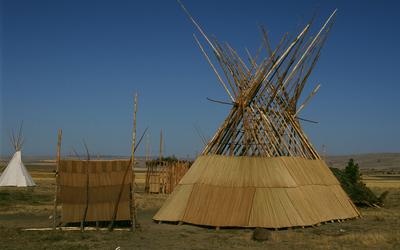
This module will examine architectures created by Indigenous peoples in relation to the natural world. It will introduce a perspective of buildings as living beings related to the living earth and we humans in relation to each other, other animals, and all of the resources provided by the creator. As such, lectures will consider ethics of reciprocity and ceremony in construction and use, at least as much as we know from the material record and ethnohistorical knowledge. E… continue reading
This lecture introduces the Plateau region, the inland northwest of the North American continent. It introduces the geography and Indigenous peoples who lived, and continue to live, in this area. As the first of two lectures on Indigenous architecture in the Plateau area, the lecture presents its oldest type of dwelling, the pit house, and a ceremonial structure, the sweat lodge. This lecture presents pit houses from a cluster that stretches from the Aleutian Islands to t…
supporting documents: • Handout • Lecture Notes • Quiz with Answers
This lecture will cover the portable architecture that supported a mobile lifestyle of Indigenous peoples in the Plateau region of North America. It will discuss how people’s patterns of movement over the landscape changed in response colonization, even before colonizers themselves entered the region. Access to horses, released from New Spain (New Mexico) after the 1680 Pueblo Revolt, allowed people to travel faster and farther and carry more material wealth with them. Peopl…
supporting documents: • Handout • Lecture Notes • Quiz with Answers

In colonial historiography, architecture in South Asia is stylistically classified as Neoclassical, Gothic, and Indo-Saracenic. The debates on style in South Asia were closely tied to the nationalistic battles between proponents of the Neoclassical and Gothic styles in Britain. In the South Asian colonial context, the debate over an appropriate style hinged on how architectural styles should represent Britain’s status as the imperial ruler of South Asia—whether colonial arch… continue reading
In colonial historiography, architecture in South Asia is stylistically classified as Neoclassical, Gothic, and Indo-Saracenic. The debates on style in South Asia were closely tied to the nationalistic battles between proponents of the Neoclassical and Gothic styles in Britain. In the South Asian colonial context, the debate over an appropriate style hinged on how architectural styles should represent Britain’s status as the imperial ruler of South Asia—whether colonial arch…
supporting documents: • Lecture Notes • Quiz with Answers • Handout
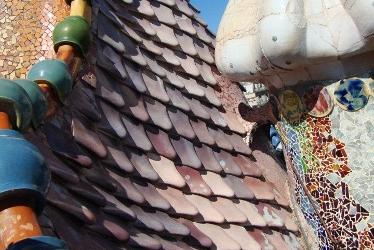
At the end of XIX century and when XX century was beginning Argentina and Uruguay received a lot of European immigrants, specially from Italy and Spain. These people were looking for a better place to live and a better place where to raise their children, because Argentina and Uruguay were wealthy nations which offered very good living conditions. During this process, Architecture had a significant presence. Each community brought their own culture, own interests and own… continue reading
This second lecture explains the main architects’ lives and works who developed their jobs in Buenos Aires, Rosario and Montevideo. They were Francisco Roca I Simó who worked in Rosario, Santa Fe, Julián García Nuñez who worked in Buenos Aires and Buigas I Monravá whose work was developed in Montevideo, Uruguay. Who were the people that asked them for new buildings and what were their needs. These architects’ relationships with Spain and how do they interact with the Spanish…
supporting documents: • Handout • Lecture Notes • Quiz with Answers
This first lecture introduces the Catalan Modernism in Barcelona to contextualize what was going on with architecture there. Gaudi´s work and his influences in Catalan Architecture. The lecture also explains the big immigration in the Río de la Plata, describing how do people traveled from Europe to America, specially how do Spanish people settle in Buenos Aires, Rosario (in Santa Fe province) and Montevideo in Uruguay. How do this community needed institutions that represen…
supporting documents: • Handout • Quiz with Answers • Lecture Notes
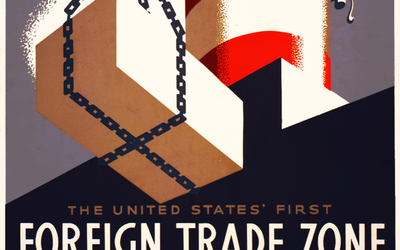
This lecture traces the history of Free Economic Zone as an urban typology and global infrastructure. Although originating from the idea of the 16th century Free Ports, Free Zones, as we know them today, are essentially post-World War II phenomena, molded in the intersection of multiple global agents and processes. These include the emergence of global institutions such as the UNIDO—United Nations Industrial Development, technological innovations, foreign trade and rise of i… continue reading
This lecture traces the history of Free Economic Zone as an urban typology and global infrastructure. Although originating from the idea of the 16th century Free Ports, Free Zones, as we know them today, are essentially post-World War II phenomena, molded in the intersection of multiple global agents and processes. These include the emergence of global institutions such as the UNIDO—United Nations Industrial Development, technological innovations, foreign trade and rise of i…
supporting documents: • Handout • Lecture Notes • Quiz with Answers
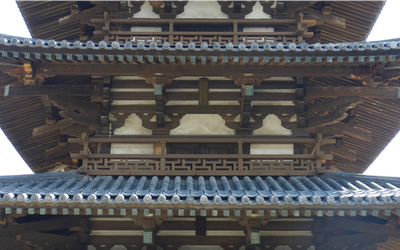
This lecture is partial introduction to Japanese architecture history as seen through the builder. The lecture, divided primarily by political periods and national laws, will examine the laws regarding builders, the words used to describe them, and the relation these two have with longevity of product, meaning both finished building and traditions associated with the building process. This lecture will focus on structures first built between roughly 600 CE and 1100 CE. Im… continue reading
This lecture is partial introduction to Japanese architecture history as seen through the builder. The lecture, divided primarily by political periods and national laws, will examine the laws regarding builders, the words used to describe them, and the relation these two have with longevity of product, meaning both finished building and traditions associated with the building process. This lecture will focus on structures first built between roughly 600 CE and 1100 CE. Im…
supporting documents: • Quiz with Answers • Bibliography • Handout
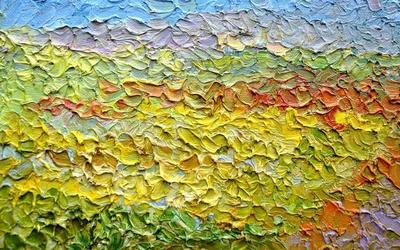
Within the self-consciously limiting parameters of a world map, the culturally-diverse and politically-nebulous region of Inner Eurasia has long remained an anomaly. Beyond its association with the undeniably enigmatic superlatives of geographical breadth, even more perplexing is its historical inversion of power relationships between centers and peripheries, its sporadically interspersed settlements, and its complex sustenance networks facilitated by mobile populations - al… continue reading
As an Introduction to Landscape Stories, the first part of this this lecture posits ‘landscape narratives’ as a trope to revisit the nomadic histories of Inner Asia, thereby developing a framework to study buildings, landscapes and cultures. It suggests how this narrativized viewing of landscape remains critical to the understandings of landform, terrain, centering, de-centering, and bordering conditions – as substantially framed by the trials and tribulations of a peripatet…
supporting documents: • Handout • Lecture Notes • Quiz with Answers
This second lecture presentation has two parts. First, it discusses the ‘soft footprint’ of the mobile populations within the longue durée of Inner Asian Nomadism. In effect, even though the association of the nomads with the unbroken steppe spanned several centuries, the intrinsic quality of this landscape remained contrastingly different from the ‘civilized world’ of cities and places. The nomadic realm was a networked world of weak centers and strong links. Within this fi…
supporting documents: • Handout • Lecture Notes • Quiz with Answers
This lecture presentation details out the so-called Inner Asian ‘gunpowder empires’ that were formed once the great conquests, acquisitions and control on the steppe landscape had been established by the nomadic hordes of greater Eurasia. Over this phase, earlier maturing experiments in architecture, urbanism and settlement (encampment) formation were formalized. More importantly, it was in these four centuries that pre-dominantly sedentary settlements were interspersed o…
supporting documents: • Handout • Lecture Notes • Quiz with Answers
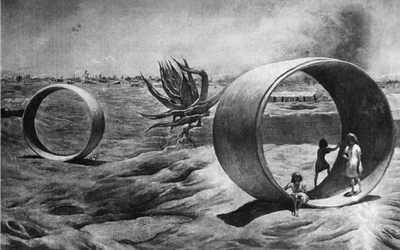
Lecture Abstract: This lecture looks at the making of the modern sewage system of Mexico City in a non-linear way. By doing this, we aim to look at each moment and place in this history within its own frameworks, acknowledging them as historical constructs while at the same time studying them within their own set of parameters and ideas. By doing so, we claim that in the making of these infrastructures, architectures, events, and their circulation in the media, the sewage sy… continue reading
Lecture Abstract: This lecture looks at the making of the modern sewage system of Mexico City in a non-linear way. By doing this, we aim to look at each moment and place in this history within its own frameworks, acknowledging them as historical constructs while at the same time studying them within their own set of parameters and ideas. By doing so, we claim that in the making of this infrastructures, architectures, events, and their circulation in the media, the sewage sys…
supporting documents:
Lecture Abstract: This lecture looks at the making of the modern sewage system of Mexico City in a non-linear way. By doing this, we aim to look at each moment and place in this history within its own frameworks, acknowledging them as historical constructs while at the same time studying them within their own set of parameters and ideas. By doing so, we claim that in the making of these infrastructures, architectures, events, and their circulation in the media, the sewage sy…
supporting documents: • Handout • Bibliography • Quiz with Answers
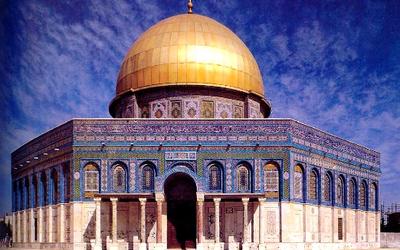
The cultural and artistic traditions that developed around the shores of the Mediterranean have traditionally been studied as autonomous developments. When exchanges or borrowing were acknowledged, they usually focused on the influence that European motifs had on the Eastern Mediterranean, starting in the eighteenth century. The aim of this project is to focus on preceding centuries, illuminating the rich web of cultural, artistic and especially architectural exchanges that … continue reading
This lecture poses our fundamental historiographical question: what are the origins of medieval European architecture? In Part I, it rehearses the conventional answer—that medieval art and architecture continue western, classical traditions; but it confronts that answer with the realization that we simply haven’t sufficiently conceived the late antique and early medieval world as one in which the East and the West were strongly interconnected. By surveying some of the magn…
supporting documents: • Lecture Notes
Pendentive domes—or domes with a circular plan used as vaulting for a square hall—emerged in Byzantine architecture. That well known fact has not, however, been explained. This lecture offers an explanation for the elaboration of pendentives as the result of the encounter of two different architectural practices concerning domes: classical Roman and eastern vaulting traditions. Roman builders made the footprint of vaulting match the footprint of the room or structure that su…
supporting documents: • Lecture Notes
This lecture presents early Islamic, or Umayyad, Architecture and its relationship to Late Antiquity. It examines the sequence of well-known Umayyad monuments, which appear to have engaged in a vibrant referencing process that treated Antiquity as a heritage to appropriate, build upon, or, sometimes, to deconstruct. In that it did not differ much from Latin Europe and Byzantium, both of which looked to the classical heritage as theirs through the lens of Christianity. Byz…
supporting documents: • Lecture Notes
The medieval monuments of the Armenian high plateau, at the crossroads of Europe and Asia, are typically ignored in histories of art and architecture. Yet they are abundant, sophisticated in design and decoration, and bear inscriptions of historical importance. This lecture will introduce the architecture of medieval Armenia, demonstrating the importance of Armenian monuments for an understanding of the seventh century, when the Armenian plateau was at the center (and not th…
supporting documents: • Lecture Notes
The Great Mosque of Cordoba, founded around 784 and expanded in the latter half of the tenth century, is one of the most striking monuments of world architecture. The red and white arches that distinguish its prayer hall and portals, its interior support system of double arcades, polylobed arched screens, and its gold mosaics and ribbed domes are iconic. Yet, while this monument is undoubtedly innovative, details of its construction and decoration also illustrate how medieva…
supporting documents: • Lecture Notes
Christian Europe expected the world to end in the year 1000. When that fateful year passed, a century and a half of church building (with attendant sculpture and painting) followed, on a scale and of sophistication not seen since the fall of the Roman Empire. In 1814, Thomas Rickman coined for the architecture of this period the term “Romanesque,” that is to say, “like the Romans.” The term colored the perception of architectural historians studying that period. They focused…
supporting documents: • Lecture Notes

This lecture investigates the development of the town hall as a new kind of public building in medieval Europe. It is organized into six sections. Part I examines pertinent political, social, economic, urban, and architectural contexts. Part II introduces the topographical, formal, and functional considerations that were integral to the design of medieval town halls (with special reference to the magnificent example of the fifteenth-century Stadhuis in Brussels). Part III an… continue reading
This lecture investigates the development of the town hall as a new kind of public building in medieval Europe. It is organized into six sections. Part I examines pertinent political, social, economic, urban, and architectural contexts. Part II introduces the topographical, formal, and functional considerations that were integral to the design of medieval town halls (with special reference to the magnificent example of the fifteenth-century Stadhuis in Brussels). Part III an…
supporting documents: • Lecture Notes • Quiz with Answers • Handout • Bibliography
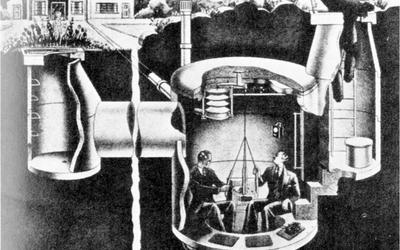
As part of this module’s examination of mobile architectures and spatial mobilities in the nineteenth and twentieth centuries, this lecture investigates mobile architectures in relation to war in the history of the twentieth century. The lecture offers a study of constructions of global activity and the aesthetics and politics of the built environment within or in response to armed conflict, such as: the design and construction of fortifications or camouflage at the scale of… continue reading
As part of this module’s examination of mobile architectures and spatial mobilities in the nineteenth and twentieth centuries, this lecture investigates mobile architectures in relation to war in the history of the twentieth century. The lecture offers a study of constructions of global activity and the aesthetics and politics of the built environment within or in response to armed conflict, such as: the design and construction of fortifications or camouflage at the scale of…
supporting documents: • Lecture Notes • Handout • Quiz with Answers • Readings

This two-lecture module connects Oceanic voyaging with vernacular architecture of the Pacific. The first lecture, ‘Mapping the Pacific,’ centers indigenous knowledge systems about pathways for human migration and trade through seafaring. It discusses indigenous seafaring in the Pacific as a social practice and system that encouraged long-distance, two-way crossings. The waterway not only facilitated material exchange (i.e. canoes, stone tools, etc.) but reflected Oceanic epi… continue reading
This lecture introduces Oceanic voyaging as a social and cultural mode of interpreting space and place. A study of ancient voyaging traditions in Hawai‘i and Aotearoa (New Zealand) challenge Western cartographies of the Pacific that have for centuries defined the region by island size and its people by phenotype and race. First, we will explore ancient wayfinding as an intentional enterprise that encouraged long-distance, two-way crossings. Next, we will discuss wayfinding a…
supporting documents: • Bibliography • Handout • Lecture Notes • Quiz with Answers
This lecture explores vernacular architecture in Hawai‘i, Samoa, and Aotearoa. It considers the ways in which ancient Polynesians utilized natural resources, enacted ritual performance, and paid homage to ancestors and genealogy in the creation of residential dwellings and spiritual spaces/places. The heterogenous development and construction of architectural forms over space and time can be seen in the Hawaiian hale, Samoan fale, and Māori whare. The lecture concludes with …
supporting documents: • Bibliography • Handout • Quiz with Answers • Lecture Notes

The following two lectures trace an architectural history of Quito from the Spanish occupation to our contemporary moment. We consider the built environment of the city as the result of tensions between a range of forces operating at different scales, including: --International flows of capital and power controlled by forces outside and within the country. --Transnational developments in architecture and their transformation as they are implemented with local resources, tr… continue reading
This lecture looks at twentieth-century and contemporary Quito: the processes of modernization that have shaped the city, and ongoing presence of different temporalities and cultural processes in its built environment. It is broken up in four parts: Andean Modernity, Institutions, Oil and Concrete, and Regionalisms and globalizations. Continuing with our global understanding of the city, we consider the built environment of Quito as the result of tensions between a range o…
supporting documents: • Lecture Notes • Handout
The first lecture deals with Colonial Quito, from Pre Hispanic precedents to 19th century. Discuss the following topics: 1. Urban aspects linked to the colonial trace, its European origins and the way in which the regular plan of the conquerors is related to the particular topography of the place and to the marks of the pre-Hispanic period. 2. The great squares, temples and convents as organizers of the urban center, spatial configuration and constructive elements and lan…
supporting documents: • Handout • Lecture Notes

In 1935, Uruguayan artist Joaquín Torres-García reversed the map of South America to argue for the point of view of artists working “from the south,” eloquently claiming: “Our north is the south.” Thinking with Torres-García, this module presents five architectural history lectures that think about global exchanges and networks from the point of view of South and Latin America. The history of architecture in the region presents particular opportunities and challenges for a g… continue reading
Fernando Luis Martinez Nespral, Ana María León, Silvia Arroyo, Fabiola Lopez-Duran, Macarena Cortés, Claudia Felipe Torres, Leandro Manenti, Pilar Sanchez-Beltran, Amari Peliowski, Ingrid Quintana Guerrero, Reina Loredo-Cansino, Maribel Aliaga Fuentes
supporting documents: • Syllabus
This lecture focuses on the spaces, buildings, and landscapes generated by agriculture, herding, and the extraction of raw materials. The landscapes and cities of Latin America have been marked by the region’s status as a space of material extraction, and the spaces of labor, storage, and exchange prompted by these activities. The talk includes case studies from cattle herding in Argentina, oil extraction in Mexico, and sugar cane extraction in the Caribbean.
supporting documents: • Handout • Lecture Notes • Discussion Questions
This talk traces the history of the formation of the architecture discipline in Latin America. The first section of the lecture addresses the development of curricula through a chronological approach. We start with the transmission of architectural knowledge in the colonial period, illustrated by the circulation of architectural treatises, the Jesuit presence and the role of military engineers. We continue with the creation of national states, addressing the creation of the …
supporting documents: • Discussion Questions • Handout • Lecture Notes
This talk explores the production of inequality and its results in architectural education. It is organized around three themes: race, gender and violence. We address race inequality through the relations between indigenous and colonizer artisans in the construction of Quito. We discuss gender inequality through the study of the female presence in the historiography of architecture in Latin America and the participation of women as teachers, scholars and publishers in the fi…
supporting documents: • Lecture Notes • Discussion Questions • Handout
This lecture underlines the importance of an intersectional feminist approach to the history of architecture in Latin America, particularly the ways in which inequalities based on gender, class, race, and other traits have produced distinct building types, construction labor organizations, and divisions within the discipline of architecture in the region. Topics include, domestic typologies in Brazil, and the role of women in the discipline of architecture in Chile and Brazi…
supporting documents: • Handout • Lecture Notes • Discussion Questions
This talk reflects on the architectural and urban legacies of Latin America’s colonial past, and the discourses that have legitimated what buildings merit preservation and which ones are destroyed. The talk argues one of the central dilemmas in the work of preservation in the region is the contradiction between historic and cultural wealth and economic poverty. Using the work of Ecuadorian scholar Fernando Carrión, the talk questions the imposition of a singular, unified mod…
supporting documents: • Handout • Lecture Notes
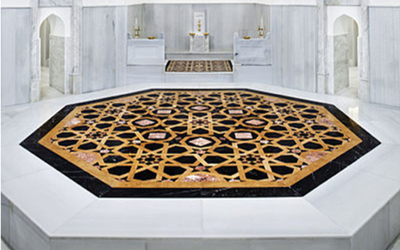
This course presents information about global architectural history using parallel biographies as an accessible introductory framework. Each pair illustrates similar situations in different geographical regions. Although these lectures place important sites and structures in their economic, geographical, political and cultural context, they will also engage the student by focusing on the people inhabited and/constructed the spaces under discussion. By providing vivid details… continue reading
Despite their positions of power, neither Clement VII nor Moctezuma of Mexico were able to prevent the Spanish Empire from establishing a new regime in their regions. Giulio de’ Medici, born at the height of the Italian Renaissance, ascended to the highest office in the Catholic Church as Pope Clement VII. Fear, indecision, and untrustworthy allies undermined his ability to lead a resistance against Spanish domination of the peninsula. Moctezuma II, an Aztec prince, had prov…
supporting documents: • Lecture Notes • Handout • Quiz with Answers
Hürrem Sultan was captured in a slave raid and placed in the harem of Suleiman the Magnificent. Lady Zheng endured a series of competitions to enter the inner palace of the Ming dynasty as a concubine, where she won the affection of the lonely and misunderstood Wanli emperor. Both were accused of endless scheming, intrigue, murder, and even the downfall of their respective dynasties. At the same time, these women served as scapegoats for men who saw influential women as a th…
supporting documents: • Handout • Lecture Notes • Quiz with Answers
Described by contemporaries as “instruments of divine will,” Afonso and Elizabeth successfully merged new religious beliefs with the traditions of royal power. Isolated from contact with other states until the Portuguese arrival in the sixteenth century, the Kingdom of Kongo underwent a massive spiritual transformation under the rule of Afonso I who converted to the Catholic faith. During the reign of Elizabeth I, England became a Protestant kingdom on its way to establishin…
supporting documents: • Quiz with Answers • Lecture Notes • Handout
Emerging as successful warlords in times of chaos and civil war, Hideyoshi and Henry IV rose to the pinnacle of power in their respective states. Born a peasant, Hideyoshi distinguished himself as a samurai vassal of a ruthless and cruel lord, eventually placing every province in Japan under his military control. Henry IV, although born a prince, faced challenges as a religious dissident. Once in power, both rulers provided the foundations for unified nation-states. Their ar…
supporting documents: • Lecture Notes • Quiz with Answers • Handout
Claiming mystical experiences of the divine, Teresa of Avila and Choky Dronma have inspired devout followers for centuries with their spiritual biographies. Teresa’s ecstatic visions of the divine reignited the passion of the Catholic faithful in an era of crisis. Chokyi Dronma, as a princess, Buddhist nun, and tantric master, initiated a line of female reincarnations that exists today as the Samding Dorje Phagmo. While Chokyi Dronma was considered the embodiment of a deity,…
supporting documents: • Lecture Notes • Handout • Quiz with Answers

Lectures will emphasize the role played by patron-kings and their political interests in Hindu temple building in India’s Early Medieval period (ca. 550 to 1200). This is a signiacant aspect of my larger study on the Early Chalukya architectural tradition and is important for any general survey of Hindu temple architecture in India. The arst lecture will explain the critical position of Early Chalukya architecture within the developmental trajectory of the Southern (Dravi… continue reading
Lecture Abstract: This lecture is concerned with the development of Hindu temple architecture in South India and the Deccan region of southern India, from the period of initial experimentation with rock-cut temples in the early sixth century through to the emergence of a mature and fully articulated Deccani temple style that its established by the late eighth to ninth centuries. It begins by explaining the basic forms and components of the typical Hindu temple and their f…
supporting documents: • Handout • Lecture Notes • Quiz with Answers
In looking at the architecture of the Early Chalukya dynasty, in particular the Virupaksha temple (733-744), it becomes clear that temple-building had become a necessary component of Hindu kingship. Temple building made visible the efficacy and scope of kingship—recalling and reinforcing the king’s power as well as his authority to rule. As temples became necessary to kingship, temples constructed of permanent materials were being built in larger and larger numbers and, eve…
supporting documents: • Handout • Lecture Notes • Quiz with Answers

Entitled as the Peripheries of Contact - Beyond Geographies and Historical Flatland, this course examines the dynamic peripheries of a cultural region (area) - a global region loosely defined not only by its ethno-linguistic character, but more importantly, by its inherently intertwined environment and culture. Given that cultural regions have adjoined each other, often connecting (and sharing) the same periphery (or peripheries), these cultural regions are also viewed as th… continue reading
This first lecture introduces the broad theme of Peripheries of Contact - Beyond Geographies and Historical Flatland, questioning how this theme be conceptually examined. It proposes four ways to visualize cultural histories, in particular the histories of architectural and urban 'making and un-making': - As an overarching concept of Periphery (versus the center) - a new way of looking at history - The Periphery 'condition' as akin to a thick ‘cultural zone’ or limi…
supporting documents: • Lecture Notes • Quiz with Answers • Handout
In looking at the architecture of the Persianate world with respect to its peripheries, this lecture starts by defining the term 'Persianate', and the complex cultural context of what actually comprised the Persianate world? Why could this 'condition' be better described as'a world of many Worlds?' What were the geographical boundaries of this land that effectively comprised of not only multiple ethnicities and people resident, but scores other transient and nomadic? Un…
supporting documents: • Handout • Lecture Notes • Quiz with Answers
This second lecture on the Persianate World introduces four space-time moments that were critical to the intertwined histories of this region. On this particular front, the arrival of Islam as a new religion in this land was perhaps as important as the inter-mixing of nomadic and sedentary cultures. Within the Persianate world, the arrival of Islam is followed by transition and change, and later its deep assimilation within local beliefs. Meanwhile, the cultural inter-mi…
supporting documents: • Handout • Quiz with Answers • Lecture Notes
The first Slavic lecture introduces the origins, name, geographies and the versatility of the historic Slavs. It discusses how in Western historiography the Slavs are traditionally presented as peripheral to the development of the Western Europe. In response, this lecture shifts the perspective to examine how that Slavs’ peripheral geographic and cultural location enabled them to develop as a central connective link between different cultural regions, variable lifestyles…
supporting documents: • Handout • Lecture Notes • Quiz with Answers
The second Slavic lecture proceeds to illustrate the architectural consequences of the complex center-periphery relationships throughout pre-modern and early modern periods in Slavic history. The four cultural moments are accompanied by multiple examples of construction in different Rus’ principalities, often in seeming reaction towards external threats and/or potential invasions. How these inventive idioms actually become inherited traits of architecture across generations …
supporting documents: • Handout • Lecture Notes • Quiz with Answers
The first lecture on the Indian Subcontinent discusses it as a realm of isolated centers and ‘thick’ peripheries, controlled by its specific geographies. It illustrates how much of Indian medieval history remains replete with the contesting control of these centers and the geographical features that ‘contain’ these centers. On these lines, no longer does a linguistic and/or political assessment suffice to explain the idea of the subcontinent as a cultural region. Could t…
supporting documents: • Handout • Quiz • Lecture Notes
The second lecture on the Indian Subcontinent examines the four space-time moments that serve to frame the histories of region's thick and mercurial peripheries, particularly in the northwest and north, often conjoining with aspects of geography and topography to produce unique conditions. India's 'landed' peripheries appear to have behaved rather differently versus its hydro edges - an observation that accounts for the pronounced 'incoming' interactions from mountainous van…
supporting documents: • Handout • Lecture Notes • Quiz with Answers
This lecture suggests how Nomadic Eurasia must be viewed as Spatial interregnum or Cultural Matrix, versus as a conventional region. Besides its unbroken geographies, alongside continuous ‘land’ connections and movement ‘corridors’ connected a ‘matrix’ of influence, it was also a conspicuous and transforming, trans-spatial social network of changing nodes, versus fixed and physically defined centers. It was this confederation of tribal solidarities versus landed empire/s and…
supporting documents: • Handout • Lecture Notes • Quiz with Answers
his lecture continues stories from the Nomadic Steppe, in particular describing the four space- time moments that served as the critical disruptions with this cultural region. All of these moments were catalyzed by the mass movements of populations across this 'unbroken' land(ed) terrain, stretching substantially east-west and north-south. That nomads—often viewed as peoples with no permanent artifacts and iconographic imageries—were able to 'carry' and 'transfer' cultural …
supporting documents: • Handout • Lecture Notes • Quiz with Answers
The concluding lecture presents how the four cultural regions were part of a world system that effectively inter-connected distant regions, often encompassing ’landed’ and/or ‘hydro’ connections. By the thirteenth century, these inter-connected regions included substantially large areas—inherently removed from each other, but almost always related via ‘accessible’ networks of trade and exchange, which began at the peripheries and displayed relevance as these elements of i…
supporting documents: • Handout • Lecture Notes • Quiz with Answers
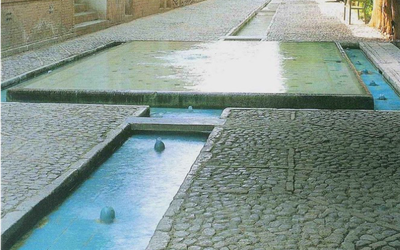
The objective of this module of two lectures is to highlight, through a study on the gardens of the Iranian plateau and beyond, the existence of a relationship to gardens that is unique. These gardens are the structures to make any form of life possible. Thus, the garden becomes a model for making the city; a device capable of hosting all kinds of programs. These paradisiacal enclaves embody a unique architectural and urban configuration that, to a large extent, is an ideolo… continue reading
This lecture presents key characteristics of Persian Garden in Iran, to offer an understanding of architectural and urban qualities of it; accordingly, the components of the Persian garden can be summarized as follows: Walls, The Surroundings, Water, Vegetation, Shades, Geometry and viewpoint. It also illustrates the architectural characteristics of four case studies from different contexts and eras to show how important the relation with the Persian Garden is in Iranian arc…
supporting documents: • Handout • Lecture Notes • Quiz with Answers
This lecture explains the importance of Persian Garden in the fabric of the Iranian cities; presents key characteristics of Persian Garden in different aspect of Iranian architecture, to offer an understanding of architectural and urban qualities of it; illustrates the architectural characteristics of case studies from different contexts and eras to show how important the relation with the Persian Garden is in cultures beyond Iran. The Persian Garden reflects the interact…
supporting documents: • Handout • Lecture Notes • Quiz with Answers
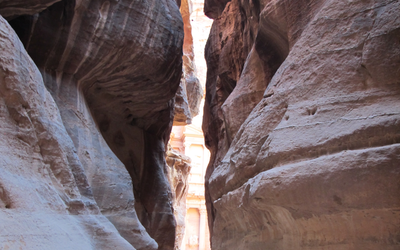
This three-part lecture covers the history and context of Petra, a site in Jordan. It was one of several sites that were created by the Nabateans, who came to dominate the area of west Jordan and the Sinai between the 3rd century BCE and the 4rd century CE. Originally a nomadic Arabian tribe, they settled into the region to control and stabilize the trade routes between Africa and India to the south and the Hellenized and Roman world to the north. They managed to control the… continue reading
supporting documents: • Bibliography • Handout • Lecture Abstracts • Quiz with Answers
These lectures cover the history and context of Petra, a site in Jordan. It was one of several sites that were created by the Nabateans, who came to dominate the area of west Jordan and the Sinai between the the 3rd century BCE and the 4rd century CE. Originally a nomadic Arabian tribe, they settled into the region to control and stabilize the trade routes between Africa and India to the south and the Hellenized and Roman world to the north. The managed to control land in …
supporting documents: • Lecture Notes
These lectures cover the history and context of Petra, a site in Jordan. It was one of several sites that were created by the Nabateans, who came to dominate the area of west Jordan and the Sinai between the the 3rd century BCE and the 4rd century CE. Originally a nomadic Arabian tribe, they settled into the region to control and stabilize the trade routes between Africa and India to the south and the Hellenized and Roman world to the north. The managed to control land in …
supporting documents: • Lecture Notes
These lectures cover the history and context of Petra, a site in Jordan. It was one of several sites that were created by the Nabateans, who came to dominate the area of west Jordan and the Sinai between the the 3rd century BCE and the 4rd century CE. Originally a nomadic Arabian tribe, they settled into the region to control and stabilize the trade routes between Africa and India to the south and the Hellenized and Roman world to the north. The managed to control land in …
supporting documents: • Lecture Notes
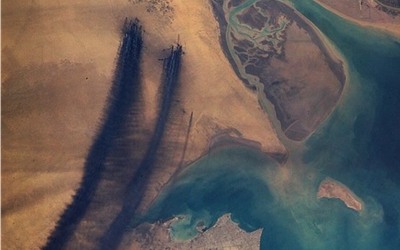
At the end of the 19th century, the productive structures of the industrial countries were transformed throughout the world. Oil and electricity displaced coal as a primary source of energy. Its low cost, its calorific value, the ease of handling and storage made it the essential element in modern industrial, commercial, and transport processes. This course describes the challenges that modernization processes had in cities associated with oil at the beginning of the 20th ce… continue reading
The focus of this lecture is on how, since the 19th century, oil companies, representing powerful economic interests, have influenced governments, encouraged wars, driven / sustained totalitarian regimes, until finally transforming cities and landscapes. The elements that make up these new built spaces will be studied. Petroleum infrastructures for extraction, refining, storage and transportation changed landscapes and created new cities. This lecture will present the relati…
supporting documents: • Lecture Notes • Handout • Quiz with Answers
Oil cities have been established throughout the 20th century, as a transnational model with similar spatial characteristics throughout the world in which the political and economic background associated with the culture of oil, hierarchy and engineering sectorization is evident. The capitalist dynamics of oil exploitation lead to extraordinary changes in the population, the local economy and the organization of the urban-regional space where oil fields are discovered. This c…
supporting documents: • Handout • Lecture Notes • Quiz with Answers
Probably, oil has been the most bought and sold merchandise throughout the 20th century, not only because no other energy has been associated with mass consumption. However, also that a wide variety of other energy substances, auxiliary materials, etc. are derived from oil. On the other hand, there are a long and terrible history of environmental destruction and human rights violations in the regions that produce oil. At this point, it is essential to ask where oil is produc…
supporting documents: • Handout • Lecture Notes • Quiz with Answers
Petroleum: A Global History of its impact on Landscape, City, and Architecture (SPANISH TRANSLATION)

At the end of the 19th century, the productive structures of the industrial countries were transformed throughout the world. Oil and electricity displaced coal as a primary source of energy. Its low cost, its calorific value, the ease of handling and storage made it the essential element in modern industrial, commercial, and transport processes. This course describes the challenges that modernization processes had in cities associated with oil at the beginning of the 20th ce… continue reading
El enfoque de este curso se centra en cómo, desde el siglo XIX, las compañías petroleras que representan poderosos intereses económicos, han influido en los gobiernos, alentado las guerras, regímenes totalitarios impulsados y/o sostenidos, hasta finalmente transformar las ciudades y los paisajes. Se estudiarán los elementos que componen estos nuevos espacios construidos y cómo han afectado a la sociedad. Las infraestructuras petroleras para la extracción, la refinación, el a…
supporting documents: • Handout • Quiz with Answers
Las ciudades petroleras se han establecido a lo largo del siglo XX, como modelo de una ciudad transnacional con características espaciales similares en todo el mundo en las que resulta evidente el trasfondo político y económico asociado a la cultura del petróleo, la jerarquía y la sectorización ingenieril. Las dinámicas capitalistas de la explotación petrolera conducen a cambios extraordinarios en la población, la economía local y la organización del espacio urbano-regional …
supporting documents: • Handout • Quiz with Answers
Probablemente, el petróleo ha sido la mercancía más comprada y vendida a lo largo de todo el siglo XX, no solo por el hecho de que ningún otro producto energético ha estado asociado al consumo masivo. Sino también a que del petróleo se deriva gran variedad de otras sustancias energéticas, materias auxiliares, etc. Por otro lado, existe un largo y terrible historial de destrucción ambiental y violación de derechos humanos en las regiones que producen petróleo. En este punto…
supporting documents: • Handout • Quiz with Answers
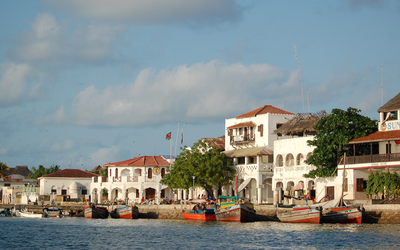
This module presents the architecture, infrastructure, and material culture of the Swahili Coast of East Africa as it developed from around 1200 CE through the twentieth century. We examine the development of Swahili architecture and urbanism as a constant tension between rootedness and cosmopolitanism, place-making and world-seeking. The overarching theme is that of dynamism, where Swahili landscapes are approached as always recombinant, unfinished, absorptive, innovative,… continue reading
By 1000 CE, an array of small settlements dotted the East African coast, mostly Bantu-speaking groups such as the Mijikenda and Bajun, along with Cushitic-speaking pastoralists from the North. These groups were at times fragmented or isolated, and at other times conglomerated in complex political alliances. Beginning over one thousand years ago, merchants, missionaries, and migrants traveled great distances through the monsoon winds that blew back and forth across the Indi…
supporting documents: • Discussion Questions • Lecture Notes • Handout
Swahili merchant families built considerable fortunes trading goods via the Indian Ocean. They exported ivory, spices, carved wood furniture, ebony, coconut oil, and tortoise shell, and in turn imported silk, rugs, textiles, and other goods from as far as Persia, Goa, and Sri Lanka. Chinese beadwork and plate ware have been found at numerous archaeological sites, indicating connections to the Silk Road. Wealth accumulation through trade sparked the increased use of resour…
supporting documents: • Lecture Notes • Handout • Discussion Questions
By the eighteenth century, city-states such as Lamu and Zanzibar had built up fleets of dhows--beautifully carved single-masted sailing vessels large enough to traverse the ocean. As the dhows multiplied, the ports expanded along the waterfronts of Swahili settlements. In addition to import trade, wealthy landowners developed a monocultural plantation economy for the production and export of spices such as clove, cinnamon, vanilla, clove, and black pepper. Based on slaver…
supporting documents: • Handout • Lecture Notes • Discussion Questions
Between the eighteenth and early twentieth centuries the 'classic' Swahili Stone Town landscape emerged. However, against the many claims that this landscape derives from a uniform imposition of 'Arabic' architectural and urban forms, it is far more accurate to approach the Swahili town as a series of experiments, innovations, amalgams, and contingent developments. The renowned 'Stone House,' for example, has been shown to be a variant of the much older makuti house. The …
supporting documents: • Handout • Lecture Notes • Discussion Questions
German and British officials struggled for influence over the Omani Sultanate at Zanzibar. By the end of the nineteenth century, the British declared the East African Protectorate, and exerted direct control up through the post-World War II decades. Colonial planners left their marks in a variety of architectural and urban planning projects, from Art Deco office and apartment buildings to centralized market facilities to Modernist mass housing developments. Tanganyika ga…
supporting documents: • Handout • Lecture Notes • Discussion Questions

Affordable housing is a pressing need across the world, yet its production is far from sufficient to meet the demand. During the interwar and postwar years, social housing was imagined as a political project, the lack of which is one of the main reasons behind the fragmented policy making and the widespread failure in countering the problem of housing shortage today, more so in the so-called “developing countries” and the regions wrought with conflict, war, and displacement.… continue reading
From its establishment in 1923 until WWII, Turkey’s residential culture was shaped by policies implemented by reformist early republican governments which adopted a western style modernization program. The urban development side of this program was executed by architects and city planners who emigrated to Turkey from German speaking countries as well as by European-trained Turkish architects. Housing played an important role in the making of the new capital, Ankara, where th…
supporting documents: • Handout • Lecture Notes
Beginning from the late 1950s, the architectural practice in Turkey began to reflect the latest trends of the “International Style” and policies of the welfare state became more pronounced, advancing the central government’s role in the production of housing. With the use of the Marshall Aid Program, American specialists were invited to the country to prepare reports for low-cost housing developments. On the other side of the Cold War aisle was Soviet Russia, which played a …
supporting documents: • Handout • Lecture Notes
From the 1980s on, states have adopted neoliberal economic policies across the world. In the urban sphere, these policies brought privatization, loss of public spaces, and gentrification. They also retreated from affordable housing provision. Mass housing, a method of production rather than a means to reform, largely replaced social housing in this time period, and its ties to politics have diminished. Unregulated housing markets left masses of people vulnerable and informal…
supporting documents: • Handout • Lecture Notes • Questions and Assignments

Earth is 70 percent water, but only 2.5 percent of this superabundant liquid is fresh. And, two-thirds of this minuscule amount of fresh water is inaccessible— locked away in ice caps, glaciers, and rocky underground aquifers. Only a tiny fraction of Earth’s potable water is readily available to humans. Even though this hydro-ecological view of the planet is a modern one, it should, nonetheless, paint a broader historical picture of how both access to and management of water… continue reading
Lecture 1. “Water Is the Matter” (Sumerian proverb): Water Management in Mesopotamia, 5000 - 300 BCE
This lecture module examines the role of two rivers—the Euphrates and the Tigris—in shaping both the Mesopotamian perceptions of water and hydraulic infrastructures that made Mesopotamia a thriving river-valley civilization. Rising in Turkey/Armenia, the Euphrates and the Tigris flew southward through a harsh desert environment for 2,430 km and 1,850 km, respectively. On entry to modern-day Iraq, the two rivers form a Jezira, or “island,” between them. The rivers unite at Al…
supporting documents: • Lecture Notes • Handout • Quiz with Answers • Bibliography
This lecture examines how the Nile laid the sociocultural, political, and economic foundations of the Egyptian civilization. The ancient Egyptians didn’t know the source of the Nile River. They thought that this “mysterious” river came to the earth from heaven. For them, it was a deific force of the universe, “the Great River,” itr-âa, or “the Sea,” iumâ. They called it Hapi, a god in human form. As recorded by the Greek historian Herodotus, the Egyptian priests considered…
supporting documents: • Lecture Notes • Handout • Quiz with Answers • Bibliography
The shift from a subsistence economy based on hunting and gathering to one based on food production by cultivating plants and domesticating animals and water is a watershed in human history. The shift to an agriculture-based economy, and the complex systems of water management that it warranted, transpired only in a few independent centers around the world. One such center was Peru, where advanced settlements and agro-pastoral activities flourished as early as 5000 BCE. Smal…
supporting documents: • Lecture Notes • Handout • Quiz with Answers • Bibliography
The Indus Valley civilization (also known as the Harappan civilization or Indus-Saraswati civilization) was virtually unknown until 1921, when excavations in the Indian Subcontinent revealed the cities of Harappa and Mohenjo-daro. Archaeology demonstrates that these cities were highly urbanized, served by sophisticated water-management infrastructures. With contested provenance, this “mysterious” civilization reached a mature urban phase around 2500 BCE and thrived for a tho…
supporting documents: • Lecture Notes • Handout • Bibliography • Quiz with Answers
This lecture module explores different philosophical and engineering approaches to early Chinese water management systems and how they related to various political contexts and dynastic rules. By taking this course, students are expected to learn how “water politics” informed and shaped the early Chinese civilization. The module begins with the Xia Dynasty (2100–1600 BCE) and its legendary founder Yu the Great’s “Taoist approach” to river management and concludes with the…
supporting documents: • Lecture Notes • Handout • Bibliography • Quiz with Answers
Focusing on Varanasi, the most sacred Hindu pilgrimage city on the bank of the Ganges, this lecture module demonstrates how a particular land-water confluence creates a sacrosanct urban center. Varanasi’s urban experience is marked by an elaborate system of ghats (steps leading to the river) that serve as “temples” dedicated to the sacred water of the Ganges. Hindus come to Varanasi to worship the Ganges water, perform funeral rites, and attain moksha or nirvana. The flowing…
supporting documents: • Lecture Notes • Handout • Quiz with Answers • Bibliography
This lecture module examines how the Aegean world’s “islandscape” and hot and semiarid Mediterranean climate warranted architecture and city design driven by strategic water management systems. In many ways, hydraulic engineering in Greek mainland and islands were different than those in Mesopotamia and Egypt. Mesopotamian and Egyptian civilizations predominantly relied on the exploitation of the discharge of large rivers (i.e., Tigris, Euphrates, and Nile). Although Mesopot…
supporting documents: • Lecture Notes • Handout • Quiz with Answers • Bibliography
This lecture module explains how “supplying water, displaying hygiene, and extending authority” became intertwined narratives in the administrative bureaucracy of the Roman Empire. In the late first century CE, Rome’s water commissioner Sextus Julius Frontinus proudly wrote in his water-related treatise, De aquaeductu urbis Romae: "Just compare with the vast monuments of this vital aqueduct network those useless Pyramids, or the good-for-nothing tourist attractions of the Gr…
supporting documents: • Lecture Notes • Handout • Quiz with Answers • Bibliography
This lecture modules examines how the strategic and economic rise of the Nabataean city of Petra—located at the crucial intersection of trade routes, connecting the Mediterranean world, Arabia, Africa, and the Far East—also provided the impetus to develop sophisticated hydraulic systems to sustain a burgeoning urban population and various water needs. Steadily rising since 300 BCE as a nomadic settlement, Petra came under the Roman fold in 106 CE and continued on as an impor…
supporting documents: • Lecture Notes • Handout • Quiz with Answers • Bibliography
This lecture module focuses on how the water-fragile civilization of Islam adapted to the harsh desert environments of Arabia, the Mesopotamian region, and North Africa, and to different geographic conditions of Andalucía, Spain. Islam’s theological framing of water has been conditioned by the fact this faith emerged in the water-scarce desert of Arabia. Most of the year it is hot and dry, with rainfall generally concentrated in brief periods during short winters. Furthermor…
supporting documents: • Lecture Notes • Handout • Quiz with Answers • Bibliography

Throughout history, the access to large bodies of water facilitated the foundation, rise and prosperity of human settlements. Besides the vital quality of fresh water, the connecting potential of water was the decisive factor that prompted these developments. Since centuries, oceans, seas, rivers and lakes allowed for transportation, exchange and trading. Thereby, they connected places around the world and enabled a direct connection between different cities, states and cult… continue reading
The first lecture provides an introduction into the topic by highlighting the role of navigable water for port and city development. It deals with fundamental aspects of port city architecture and its urban planning peculiarities. Moreover, it addresses maritime networks, flows and connectivity between place. Beyond the introduction, this lecture briefly outlines these case studies: Genova New York Gdansk Amsterdam Singapore Montreal Barcelona
supporting documents: • Lecture Notes • Handout • Quiz with Answers
The second lecture sheds light on ancient port cities in Mesopotamia and Egypt, along the coast of the Mediterranean Sea and in East Asia. These cities prospered due to their role as trading hub for goods. Hosting such trade hubs also meant important military and defense investments. Other networks of shipping existed in South East Asia, creating their own architectural patterns. Sites of Lecture 2: Carthage Piraeus Milet Alexandria Ostia Leptis Magna
supporting documents: • Lecture Notes • Handout • Quiz with Answers
Maritime trade linked places along the sea, such as around the African coast and all the way into China. The Maritime Silk Road also led to the travel of religious practices, with a mosque being built in Guangzhou. This lecture explores the multiple practices that travelled in conjunction with trade. Huge investments in warehouses, merchant homes, but also leisure buildings displayed the importance of the trade. Sites of lecture 3: Istanbul Venice Genoa Lübeck Cant…
supporting documents: • Lecture Notes • Quiz with Answers • Handout
With the discovery of the Americas and the development of the Atlantic trade, numerous cities lost their trade and decayed. The establishment of colonies and the construction of major trade hubs led to the creation of cities such as Havana and many ports in Latin America. With the ships came urban planning concepts that were implemented through the Laws of the Indies and that specified the form of urban plazas, the location and design of churches and many more buildings. …
supporting documents: • Lecture Notes • Handout • Quiz with Answers
The lecture traces the founding of the Dutch East India Company (Dutch: Vereenigde Oostindische Compagnie; VOC) in Amsterdam and the associated invention of capitalism. At the beginning of the 17th century, the Netherlands quickly established a worldwide empire based on maritime trade. This was accompanied by the construction of harbours, forts and factors that exported the Dutch architectural language of the 17th century to the rest of the world. Sites of lecture 5: …
supporting documents: • Lecture Notes • Handout • Quiz with Answers
The slave trade developed into a multi-continental system of commerce and exploitation. European traders robbed people in Africa, enslaved them and shipped them to American ports for sale. The slave trade is the largest involuntary migration movement of all time and has left its mark to this day. This dark chapter of the Port Cities has left few material traces, they have to be searched very carefully. Sites of lecture 6: London Liverpool Gorée Rio de Janeiro
supporting documents: • Lecture Notes • Handout • Quiz with Answers
Industrialization and rapid technological innovation from the telegraph to steam ships changed ports, cities and the port city architecture rapidly. Around the world new types of harbors and docks led to the creation of monofunctional zones. The Docklands of London and the associated transformation of the City of London inspired port and city transformation around the world. The construction of waterfronts in the port cities of Asia with their trading headquarters, merchant …
supporting documents: • Lecture Notes • Quiz with Answers • Handout
The World Wars have had a major impact on ports and port cities. Their destruction and reconstruction demonstrates the resilience of these cities. It was followed shortly thereafter by containerization, which changed ports, cities, their architecture and infrastructure extensively. Formerly lively sailor districts were soon abandoned and housing districts disappeared. The changes reached far into the hinterland of the cities as throughput and infrastructure construction beca…
supporting documents: • Lecture Notes • Handout • Quiz with Answers
As the port withdrew and expanded outside the urban area, city government tried to reimagine these areas. Various approaches for waterfront regeneration emerged, some being even promoted by developers, with the result that many of the waterfront regenerations look alike. Waterfront regeneration projects have coincided with numerous events, from European capital of culture to Olympics. As a result, waterfronts have become the focal point for architectural development. New typ…
supporting documents: • Lecture Notes • Handout • Quiz with Answers
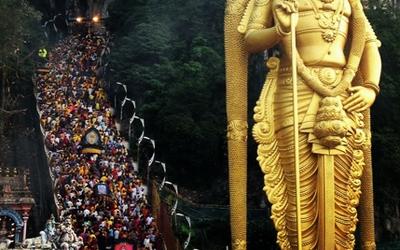
Southeast Asia is unique in the world because of the intersection of environmental, geologically and geographic realities. As a tropical environment, it supplied cinnamon, scented woods, bird’s nest and a vast array of other luxury, forest goods. Geologically, it possessed gold, gems and diamonds and geographically, located between Indian and China, it could supply these luxury goods to eager markets. The people who lived there were, in one way or another, forest-based animi… continue reading
This lecture introduces the general principles of the process known as Indianization, which begins more or less around 200 CE and continues for the next centuries as palace elites establish themselves across southeast Asia. The lecture points to the extraordinary commodity wealth in the tropics, that that could NOT be found in India or China but that the Indian and Chinese elites wanted, such as gems, gold, diamonds, pearls, incense, dried barks and bird’s nests. These were …
supporting documents: • Handout • Lecture Notes • Quiz
This lecture introduces Buddhism in general, then follows it to Sri Lanka where it became a state religion in the 3rd century BCE. While Buddhism began to disappear in India, it flourished in Sri Lanka where its new elites created Anuradhapura into a major Buddhist ritual center. The new India-derived elites were drawn to Sri Lanka for obvious reasons. It was rich in pearls and rubies, that were mined in forest streams - basically a place of easy wealth. These luxury goods p…
supporting documents: • Handout • Quiz • Lecture Notes
This lecture exposes the student an issue important to the SE Asia worldview, Animism. More or less ignored in the literature or treated as ‘Folk Religion,’ a more accurate portrayal would show that when Buddhism – and Hinduism as well - came to southeast Asia, it stepped into a forest-village world that was heavily connected to ancient traditions of animism. Both religions had to adjust and accommodate. In India, Animism had already morphed in Hinduism, even though there a…
supporting documents: • Lecture Notes • Handout • Quiz
This lecture looks at the great architectural accomplishments of the Medang or Mataram Kingdom – later the Srivijayan Empire. They became fabulously wealthy based on trade along the Malacca Straits. To attract and accommodate both Buddhist and Hindu devotees they built a host of temples for both religions. They also created a unique system of intensifying the sacredness of the landscape by the introduction of small free-standing temples known as the Candy. I discuss their r…
supporting documents: • Handout • Lecture Notes • Quiz
This lecture discusses the design features and innovations of Prambanan and Sewu both of these very complex buildings from a theological and functional point of view. Both are further examples of the thematics of the mandala which is blended with the imaginary of a holy mountain. Both also have complex theological meanings that even today are not fully understood. The lecture also discusses what is now missing in much of the experiences of these places, the dance ceremoniali…
supporting documents: • Handout • Lecture Notes • Quiz
This lecture starts with a look at the larger role of SE Asia in the world economy. The drying out of Inner Asia and its depopulation meant the end of the Silk Route tradition. The energy moved to the south, to India and thus to SE Asia. This was one of the main contributing factors for while SE Asia prospered so much between 400 and 1200, but in particular after the 9th century. This lecture introduces the Khmer and their capital Angkor. It was a bold experiment in hydro-en…
supporting documents: • Handout • Lecture Notes • Quiz
This lecture is Part 2 of the Angkor story. It focuses first on the economic positioning of the Angkor, a story that is rarely told. The problem for Angkor was that it was founded in a forest, not along the shore as most other SE Asian Palace economies. The problem was how to get their rice to market. Their purpose was to produce a rice surplus economy. But the problem they were not close to the trade routes. To their advantage was the fact that the Chinese were in trouble a…
supporting documents: • Handout • Lecture Notes • Quiz
This lecture helps round out the general story of prosperity that marked southeast Asia between 800 and about 1250. The lecture looks at the Champa and Pagan, the two cultures that flanked the Khmer. All of them were hugely successful in the regional trade business. Champa were not major rice growers. Their wealth came from coastal luxury trade to China. The same was true for Pagan, except that they controlled the over-land route to Dali and then to China. Both of these cul…
supporting documents: • Handout • Lecture Notes • Quiz
This lecture covers the longhouse cultures of Borneo. Unlike the palace-based elites who dominated the cross India-China trade in SE Asia, and which we have discussed in earlier lectures, Borneo never developed a palace-based system. Instead traders stayed on the shore to develop shore-based trading stations. They traded with inland communities – the longhouse cultures – who dominated the forests. Much of the goods that the shore communities wanted came from the forest, and …
supporting documents: • Handout • Lecture Notes • Quiz
In contrast with earlier Buddhafications, Islamization in Southeast Asia was a more or less continuous and gradual process: -7th Century Muslims traveled to and from China via port towns of mainland and island Southeast Asia eventually establishing Muslim merchant enclaves in the port cities of the region. -With the fall of Hindu-Buddhist Srivijaya (Sumatra, 13th c.) and Majapahit (Java, 15th c.) Sufi teachers converted rulers followed later by gradual conversions of subje…
supporting documents: • Quiz • Lecture Notes
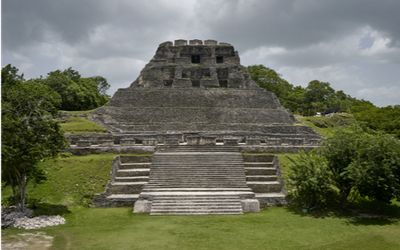
The lectures on Pre-Columbian communities can form a course, part of a course or individual lectures can be integrated into new or existing courses. Because very few cites existed in Pre-Columbian America, villages are also considered. Together the selected cities and towns exemplify a range of cultures, time periods and urban and architectural feature (except for Blackfoot villages, each lecture focuses on a UNESCO World Heritage site). Each lecture concerns a different set… continue reading
The first lecture introduces concepts that all of the lectures consider, including how plan, architecture, and embellishment evince status; interaction with other regions and peoples; and mortuary practices. Cahokia (800-1400), the largest ancient city north of Mexico, was a constellation of Mississippian farming communities. The population of ca. 20,000 was included locals and emigrants, according to dental analysis. Scale, waterways, roads, pyramids, mortuary complexes and…
supporting documents: • Handout • Quiz with Answers
Haida villages epitomize Northwest Coast planning and architecture. Status determined both the location of houses in villages and residents’ space inside the ubiquitous plank houses. Houses were considered to be living entities and are identifiable as ancestors via embellishment. Some house materials, details and technology (wooden joinery) evince contact with outsiders such as Russian sailors and U.S. settlers.
supporting documents: • Handout • Quiz with Answers
The introduction of European horses and firearms in the eighteenth century helped transform Plains Indian society from sedentary to semi-nomadic. The tipi, formerly used for temporary hunting expeditions and carried by dogs, became the primary abode for families during the year and in annual summer tribal gatherings that accommodated several hundred tipis. Horses transported the new, larger tipis, which were adaptable to divergent climates. Women and men had clear roles in t…
supporting documents: • Handout • Quiz with Answers
After introducing Mesoamerica, the focus turns to Teotihuacan, which between 100 BCE-700 CE was a magnet for population in the Valley of Mexico and a locus of trade and agriculture. It included private and public spaces, the latter with plazas, pyramids and temples. The central patios in lineage-based apartment compounds contained ancestral burials and communal space for domestic activities. Those sited along the main avenue enabled observation and participation in political…
supporting documents: • Handout • Quiz with Answers
This small city in northern Mexico (ca. 300-1150) was home to a dominant polity and trade network that linked the U.S. and Mexico. Houses, walls, and ritual edifices were built onto a mountainside, creating a dramatic setting for the hub of a regional capital. Roads facilitated communication and rituals between the center and 220 smaller settlements. After La Quemada was abandoned ca. 1000 it became a pilgrimage site for the commemoration of ancestral mortuary displays. Toda…
supporting documents: • Handout • Quiz with Answers
The capital of this Maya kingdom (600 BCE-900 CE) in Honduras included compounds of plazas, palaces, temples and pyramids associated with kings and lesser nobility. The plan can be understood as dynastic diagram, as each ruler built compounds for their family. Imagery and architecture emphasize royal-cosmic connections, and also denote contact with the hinterland and Teotihuacan. Like the capital, villages in the hinterland include house groups associated with lineages and m…
supporting documents: • Handout • Quiz with Answers
This city in Yucatan, Mexico (800-1200) was built around and above caves and cenotes (sinkholes with the region’s only potable water). Causeways connected the main monumental plaza with elite and commoner neighborhoods; all had residences and a similar inventory of ritual buildings (altar, temple, ballcourt and pyramid). Ballcourts and cenotes were portals to the Otherworld of ancestors and deities. Water and roads had associations with the cosmos and fertility; the siting o…
supporting documents: • Handout • Quiz with Answers
As newcomers to the region of contemporary Mexico City, the Aztecs transformed an empty shoreline into the hub an expanding empire. Hernán Cortés wrote that the efficiency of the Aztec capital, with chinampas (lake-based fields), schools and markets, surpassed Spanish cities in plan, services and hygiene. Framing the templo mayor (monumental royal-administrative center) with religious and political monuments that emphasized rulership and Aztec exceptionalness were barrios, o…
supporting documents: • Quiz with Answers • Handout
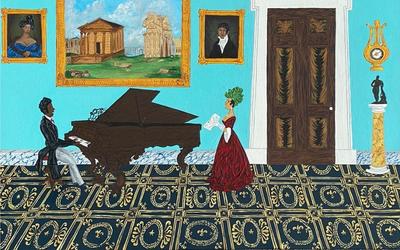
This module examines the evolution of the built environment of New Orleans amid the global movement of diverse groups and changing conceptions of race in the so-called "New World." We pay particular attention to how New Orleans changes architecturally, socially, and culturally as it transforms from a French outpost to a Creole town to an American metropolis. At root are key questions about the encounter and conflict of ideas about race, architecture, empire, and town build… continue reading
New Orleans was forged at the crossroad of empires. The Chitimacha and Natchez people originally occupied the area, subsisting through fishing in the rich estuarial waters. French colonists founded La Nouvelle Orleans in 1718, and while the French Empire ceded their Mississippi territory to the Spanish in 1763, the area remained culturally francophone. Colonists brought enslaved people to the region, both directly from West Africa and from Haiti, to provide labor for agric…
supporting documents: • Lecture Notes • Quiz with Answers • Handout
In this lecture we look at New Orleans as it undergoes a profound transformation from a Creole city to an American metropolis. This involved not only the change in population from predominantly Black and Creole to white. It also involved the different experiences of race and culture that newcomers—both white and Black—brought with them as they moved to New Orleans during the mid-nineteenth century. Throughout the second half of the nineteenth century, New Orleans experien…
supporting documents: • Lecture Notes • Quiz with Answers • Handout

This lecture examines the double marginalization of African American women in relation to their position as architects and their partnership in the design of the built environment in the U.S. and globally. More specifically, it unveils the absence of their representation through the study of twentieth-century architecture, as this period coincides with African American female architects’ entry into the field. The lecture approach is intersectional as discussing the role of r… continue reading
This lecture examines the double marginalization of African American women in relation to their position as architects and their partnership in the design of the built environment in the U.S. and globally. More specifically, it unveils the absence of their representation through the study of twentieth-century architecture, as this period coincides with African American female architects’ entry into the field. The lecture approach is intersectional as discussing the role of r…
supporting documents: • Handout • Quiz with Answers • Quiz with Answers

In the two decades following South Africa’s first democratic election, the nation has undergone numerous physical transformations as part of its struggle to create a unified national identity in the face of the lingering remnants of Apartheid. New conciliatory spaces including museums, commemorative monuments, heritage sites, and public memorials have attempted to combine the diverse narratives of South Africa’s ‘Rainbow Nation’ and shape a new national consciousness by faci… continue reading
In the two decades following South Africa’s first democratic election, the nation has undergone numerous physical transformations as part of its struggle to create a unified national identity in the face of the lingering remnants of Apartheid. New conciliatory spaces including museums, commemorative monuments, heritage sites, and public memorials have attempted to combine the diverse narratives of South Africa’s ‘Rainbow Nation’ and shape a new national consciousness by faci…
supporting documents: • Bibliography • Lecture Notes • Handout • Lecture Abstract
Roots of Global Hispanic Urbanism: Spaces of Conflict and Cultural Exchange during the Reconquista and its Aftermath

This module is a survey of pre-modern and early modern cities and architectures in territories con-quered or in conflict with Spanish kingdoms, including, Al-Andalus, Castile, Aragón, Balear Islands, Canary Islands, north Morocco, Italy, Sicily, Malta, among others. The module focuses on their con-nection with Global Islamic Culture, Jewish presences and diasporas, and their influence on American Spanish urbanism. This proposal has been designed as a continuation of the GAHT… continue reading
Juan Calatrava, Manuel 'Saga' Sanchez Garcia
supporting documents: • Bibliography • Syllabus
This first lesson introduces the module and depicts the state of Al-Andalus between the Muslim conquest of the Iberian Peninsula (711) and the end of the XIIIth century. We will expand our scope to look at the king-dom of Granada (13th to 15th cc.) in Lecture Three. Lecture One connects Al-Andalus with Islamic urban history at a global level, explaining the principles of traditional Arab-Muslim urbanism and their presence in Al-Andalus medinas. It also includes depiction…
supporting documents: • Lecture Notes • Handout • Quiz with Answers
The second lecture introduces the urban dynamics of Reconquista Christian fronts, meant to attract econom-ic and military powers from neighboring kingdoms and establish positions against main Muslim cities. Chris-tian new towns of this period were activators of the conflict and performed as complex symbolic structures charged with political and religious meaning. The second lecture introduces the urban dynamics of Recon-quista Christian fronts, meant to attract economic and …
supporting documents: • Lecture Notes • Quiz with Answers • Handout
This third lecture analyses the development of the Kingdom of Granada after the fall of Seville in 1248, and the evolution of the War of Granada (1482-1491) until the surrender of the Nasrid Capital in 1492. The lec-ture explains the rise of Granada as a center of power and its urban consequences during several dynasties, including the original medina and its expansions between the tenth and thirteenth centuries, and the building of the Alhambra’s alcazar and palaces between…
supporting documents: • Handout • Lecture Notes • Quiz with Answers
Lecture 4. Aftermath of the War of Granada. Architectural and Urban Transformations 15th to 16th cc.
After the Christian conquest, Granada and its territory suffered several transformations, including the intro-duction of new Renaissance architectures, the modification of Alhambra’s palaces, walls and doors, and the substitution of mosques and synagogues with catholic churches. The expulsion of the Jewish inhabitants of Spain in 1492 had a meaningful impact on post-war events in Granada and its urban metamorphosis. This lecture is divided into five parts. First, we will…
supporting documents: • Lecture Notes • Quiz with Answers • Handout
The fifth lecture depicts urban morphologies, laws, and practices that preceded Spanish American urbanism. The main regions studied are the Balear Islands with cities founded by the Kingdom of Aragon in the four-teenth century, the Canary Islands, and its Castillian port cities, the Castillian-Andalusian frontier with cities designed to occupy emptied lands and increase Castilian population, and finally the Mediterranean stage with fortified bastions built to strengthen the …
supporting documents: • Quiz with Answers • Handout • Lecture Notes
This lecture presents the situation of the Western Mediterranean area after the conquest of Granada in 1492. It tackles the case of conquered Moorish and their settlements, the Spanish and Portuguese projects in North Africa, and the Sephardic settlements. It is divided into three parts. The first part is centered on the actions of Spain and Portugal in North Africa during the fifteenth and sixteenth century. This period set the stage for future Mediterranean conflicts and r…
supporting documents: • Lecture Notes • Quiz with Answers • Quiz with Answers • Handout
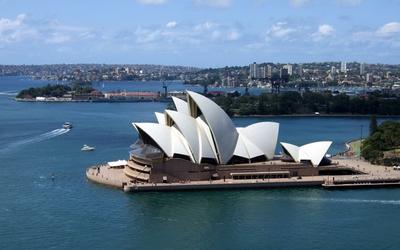
“Scale” may appear at first glance to be a purely heuristic device of pedagogy, deployed to cut across certain geographic and cultural boundaries which might otherwise pose obstacles to tracing a global architectural history. However, the intention of this course, “Scales of Modernity,” is to demonstrate that considerations of scale were crucial to twentieth-century efforts to address discourses of nationalism and globalism within the practice of architecture. This is beca… continue reading
Ginger Nolan, Jonathan Massey, Meredith TenHoor, Ayala Levin, Diana Martinez
supporting documents: • Course and Lecture Themes • Syllabus
During the period of Brazil’s post-war, democratically elected leftist governments (1945-1964) initiated several architectural experiments. It was during an economic boom, during the Juscelino Kubitschek years (1956-61) that it was decided to finally move the capitol of Brazil from Rio de Janeiro to Brasilia. As was the case with the Soviets Brazilian architects hoped to bring about a new social condition through architecture, though in the case of Brasilia the task was very…
supporting documents: • Lecture Notes • Questions and Assignments • Bibliography • Handout • Lecture Introduction
In the twentieth century, architects approach house design as a problem of defining “basic human needs”, intended simultaneously to elevate the standard of living through certain technological amenities while, at the same time, reducing living to a standard, as best described by the term, Existenz minimum. This course module will compare how a standard of living and a conception of family and society were defined under the different political-economic frameworks of coloniali…
supporting documents: • Lecture Notes • Questions and Assignments • Bibliography • Handout • Lecture Introduction
In the twentieth century, the village—which had conventionally designated a rural conurbation serving the needs of peasants—increasingly became defined through three new conceptions: as an agricultural resource for the metropolis to be reorganized accordingly; as a preserve of “ethnicity” or “culture”; and as a preserve of “nature” to which urbanites could retreat. This course module will try to understand how different villagization schemes operated in relation to concomita…
supporting documents: • Lecture Notes • Questions and Assignments • Handout • Lecture Introduction
In the twentieth century, the village—which had conventionally designated a rural conurbation serving the needs of peasants—increasingly became defined through three new conceptions: as an agricultural resource for the metropolis to be reorganized accordingly; as a preserve of “ethnicity” or “culture”; and as a preserve of “nature” to which urbanites could retreat. This course module will try to understand how different villagization schemes operated in relation to concomita…
supporting documents: • Lecture Notes • Questions and Assignments • Handout • Lecture Introduction
Lectures 6-8: I. City The question of how to delimit “city” from the other scales addressed in this course hinges largely on how cities were conceived by architects and administrators as entities united through certain shared systems, often assuming a centripetal form. The centripetal form implies that beyond a certain distance from the center, settlement ceases to be the city and becomes instead a suburb. This series of case-studies presents different ways that cities wer…
supporting documents: • Lecture Notes • Questions and Assignments • Handout • Lecture Introduction
Lectures 6-8: I. City The question of how to delimit “city” from the other scales addressed in this course hinges largely on how cities were conceived by architects and administrators as entities united through certain shared systems, often assuming a centripetal form. The centripetal form implies that beyond a certain distance from the center, settlement ceases to be the city and becomes instead a suburb. This series of case-studies presents different ways that cities wer…
supporting documents: • Lecture Notes • Handout • Lecture Introduction • Questions and Assignments
Lectures 6-8: I. City The question of how to delimit “city” from the other scales addressed in this course hinges largely on how cities were conceived by architects and administrators as entities united through certain shared systems, often assuming a centripetal form. The centripetal form implies that beyond a certain distance from the center, settlement ceases to be the city and becomes instead a suburb. This series of case-studies presents different ways that cities wer…
supporting documents: • Lecture Notes • Questions and Assignments • Handout • Lecture Introduction
Lectures 9-11: I. Region This section examines the invention of regional planning techniques in the interwar period through their permutations up to the present day, asking why and how a concept of “region” developed as a new category of design. Employed variously to remake existing political authority, create new connections between rural, urban and national scales, and to permit the management of human geography in relation to climate, landscape and natural resources, …
supporting documents: • Lecture Notes • Questions and Assignments • Handout • Lecture Introduction
Lectures 9-11: I. Region This section examines the invention of regional planning techniques in the interwar period through their permutations up to the present day, asking why and how a concept of “region” developed as a new category of design. Employed variously to remake existing political authority, create new connections between rural, urban and national scales, and to permit the management of human geography in relation to climate, landscape and natural resources, …
supporting documents: • Lecture Notes • Questions and Assignments • Handout • Lecture Introduction
Lectures 9-11: I. Region This section examines the invention of regional planning techniques in the interwar period through their permutations up to the present day, asking why and how a concept of “region” developed as a new category of design. Employed variously to remake existing political authority, create new connections between rural, urban and national scales, and to permit the management of human geography in relation to climate, landscape and natural resources, …
supporting documents: • Lecture Notes • Questions and Assignments • Handout • Lecture Introduction
Lectures 12-14: I. Meta-city From the Greek root “meta”, meaning “beyond”, meta-cities comprise those components of a city that, while belonging to the extant city, somehow surpass or exceed its conceptual, infrastructural, spatial, or legal boundaries. This can occur in various ways: by means of legal exceptionalism (e.g., Special Economic Zones, often situated just beyond the city proper); or by surpassing the conventional spatial configurations of the city (e.g., by bui…
supporting documents: • Lecture Notes • Questions and Assignments • Bibliography • Handout • Lecture Introduction
Lectures 12-14: I. Meta-city From the Greek root “meta”, meaning “beyond”, meta-cities comprise those components of a city that, while belonging to the extant city, somehow surpass or exceed its conceptual, infrastructural, spatial, or legal boundaries. This can occur in various ways: by means of legal exceptionalism (e.g., Special Economic Zones, often situated just beyond the city proper); or by surpassing the conventional spatial configurations of the city (e.g., by bui…
supporting documents: • Lecture Notes • Questions and Assignments • Bibliography • Handout • Lecture Introduction
Lectures 12-14: I. Meta-city From the Greek root “meta”, meaning “beyond”, meta-cities comprise those components of a city that, while belonging to the extant city, somehow surpass or exceed its conceptual, infrastructural, spatial, or legal boundaries. This can occur in various ways: by means of legal exceptionalism (e.g., Special Economic Zones, often situated just beyond the city proper); or by surpassing the conventional spatial configurations of the city (e.g., by bui…
supporting documents: • Lecture Notes • Questions and Assignments • Bibliography • Handout • Lecture Introduction
Implicitly semiotic in nature, the “iconic” building begs the question of what it signifies as icon, i.e., as a symbol or signifier of sorts. We know that cities (and the nations they belong to) have commissioned “icons” in an effort to project themselves as—to use another undefined term—“world-class cities”. So, the icon signifies the affluence and technological prestige of the nation it is situated within. However, we must ask firstly how they signify and what functions th…
supporting documents: • Lecture Notes • Questions and Assignments • Bibliography • Handout • Lecture Introduction

The lecture traces the origins and evolution of housing architecture during British colonization (1896-1963) of Kenya. Nairobi, Kenya’s capital city, is used to illustrate the racist segregationist architecture and urban design, as was used against the original native African inhabitants. It begins with a rear view of the architecture of the pre-colony in the pre-1890s era where African Vernacular architecture was the basis of residential space formation. This imagery, evide… continue reading
The lecture traces the origins and evolution of housing architecture during British colonization (1896-1963) of Kenya. Nairobi, Kenya’s capital city, is used to illustrate the racist segregationist architecture and urban design, as was used against the original native African inhabitants. It begins with a rear view of the architecture of the pre-colony in the pre-1890s era where African Vernacular architecture was the basis of residential space formation. This imagery, evide…
supporting documents: • Handout • Quiz with Answers • Lecture Notes
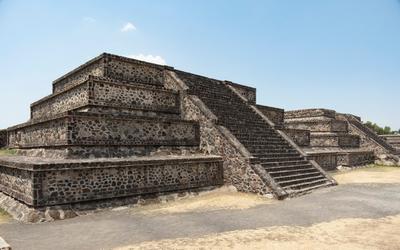
Unlike the European trajectory in architecture, in which walls and roofs separate interior spaces from the outside world, ancient Mesoamerican architecture primarily defined open-air spaces. Many Mesoamerican buildings had no “rooms” – or at least had very small rooms relative to their mass. Instead of congregating in large halls, people gathered in plazas, some vast and others more intimate, to conduct trade, to participate in ritual, and to engage in civic life. Between… continue reading
This lecture introduces Mesoamerica, one of the six places in the world in which “civilization” developed independently of outside contact. It was home to North America’s towering pyramids and to the great civilizations of the Aztec, Maya, and other remarkable culture groups. Because life in Mesoamerica was closely linked to the cultivation of maize (corn), the geographical extent of this cultural area corresponds to the region in which farmers could produce reliable harves…
supporting documents: • Quiz with Answers • Handout • Bibliography
By 1700 BC, people in several regions of Mesoamerica were conducting major earth-shaping projects. By 1200, they were creating ceremonial and administrative centers, and carving basalt and jade into a variety of meaningful forms. This lecture looks at three such places: El Manatí, San Lorenzo and La Venta along the Gulf Coast. All existed hundreds of years before the advent of phonetic writing in Mesoamerica. However, the people of this era did develop a trans-regional sys…
supporting documents: • Bibliography • Handout • Quiz with Answers
One of the unique features of Mesoamerica was its overlapping calendar systems. To grasp the essence of Mesoamerican thought, one must have a decent sense of the calendar. It regulated everything – from a person’s name and fate, to the unfolding of ritual processions, to the scale of buildings and design of cities. Learning the Mesoamerican calendar can be challenging for several reasons. First, it consisted of multiple cycles. Second, not all of these were related to th…
supporting documents: • Handout • Quiz with Answers • Bibliography
Around 100 BC, still early in Mesoamerica’s history, people in the highland Basin of Mexico began to build the largest urban center in the Americas, called Teotihuacan. Not only did it eventually have a population of over 130,000, but it became a cosmopolitan center with enclaves of people from other cultural regions. Many residents lived in comfortable apartment compounds decorated with mural paintings. However, none of this explains why the scale of the city’s central core…
supporting documents: • Handout • Quiz with Answers • Bibliography
The Maya created one of the world’s great civilizations. Deep in the rainforest, they founded over one hundred kingdoms, where writing, the arts, mathematics, astronomy, music, and of course, architecture flourished. They learned to take advantage of a challenging environment and built their cities without beasts of burden, metal tools, or the wheel. Tikal was perhaps the most enduring of Maya kingdoms. It was founded in the Pre-Classic era, around 600 BC, and emerged …
supporting documents: • Handout • Quiz with Answers • Bibliography
Palenque, whose ancient names were Lakam-ha “Big Waters” and Baak, “Kingdom of Bone,“ was a small kingdom that has had a huge impact on modern understandings of the ancient Maya. Not only is it often referred to as an “architectural jewel” due to the elegant proportions of its structures and its innovative roofing and vaulting systems, but its hieroglyphic texts and bas-relief sculpture reveal much about ancient Maya history, ritual, and cosmology. Moreover, nowhere else is…
supporting documents: • Handout • Quiz with Answers • Bibliography
Today we focus on two relatively contemporaneous Epi-Classic cities, El Tajín in Central Veracruz and Chichén Itzá, a Maya site. “Epi” means “after.” The Epi-Classic, which dates from 650 to about 1000 AD is after the fall of Teotihuacan. After 800, the Classic Maya cities in the central lowlands also experienced a relatively swift collapse. In this era, numerous new cities emerged or came into prominence, often borrowing from Teotihuacan and the Maya their symbols of gra…
supporting documents: • Handout • Quiz with Answers • Bibliography
Tenochtitlan is important for many reasons. In 1519, when the Spanish under Hernán Cortés invaded, it was the largest city of the New World and it grew to its impressive size of around 250,000 in less than 200 years. According to legend, a long period of wandering and struggle had led the Mexica, a group of Nahuatl speakers who had left their homeland, Aztlan, possibly 1000 years earlier, to the highland basin of Central Mexico. This was between the volcanoes Popocatepetl, I…
supporting documents: • Handout • Quiz with Answers • Bibliography

The history of architecture is sometimes thought to have begun with ‘shelter’ – with humans wanting to protect themselves from rain and snow. This is mostly nonsense. The truth is there is no one ‘origin story.’ The first things that go into the category ‘architecture’ had to do just as much with celestial observation, dance ceremonies, mortuary practices and landscape intensifiers. In that multi-originary world there a topic that is astonishingly absent from normative narra… continue reading
The history of architecture is sometimes thought to have begun with ‘shelter’ – with humans wanting to protect themselves from rain and snow. This is mostly nonsense. The truth is there is no one ‘origin story.’ The first things that go into the category ‘architecture’ had to do just as much with celestial observation, dance ceremonies, mortuary practices and landscape intensifiers. In that multi-originary world there a topic that is astonishingly absent from normative narra…
supporting documents: • Handout • Lecture Notes • Quiz with Answers
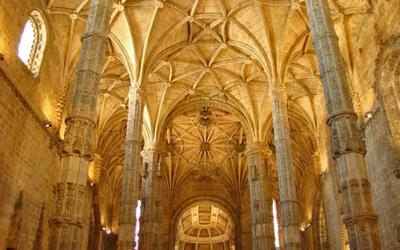
“Sites and Systems of Global Colonialism” is a survey course that introduces students to building cultures, landscapes and urbanisms in an already globally connected world from the colonial era through 1900. The course examines multiple overlapping systems by which the practices of human cultures have come to be interconnected around the world over time. It is a history of the world through architectural evidence, and a history of architecture through a global perspective. … continue reading
Evangelical colonialisms are characterized by combining projects of religious conversion with the use of force to impose dominant trade relations. While religion played a more or less significant role in European moral justification for imposing control over the peoples, cultures and societies of the rest of the world, the evangelizing mission of the Catholic powers of the Iberian Peninsula, now known as Portugal and Spain, were so deeply integrated with the mechanisms of co…
supporting documents: • Handout • Lecture Notes
The site for this lecture is the Presidential Palace, in Mexico City via Cordoba and Sevilla. This lecture will focus on the system of forced displacement using religious and urban architectures built over the remains of indigenous structures. The Spanish method of conversion and occupation requires that existing sites of power, be used as the foundations for new architectures of religion and political control. The Influence of mujedar architectures in New Spain will also be…
supporting documents: • Handout • Lecture Notes
The labor system of Encomienda was extended to the Viceroyalty of Peru using the physical forms and institutions of the Spanish Catholic Church and the Laws of the Indies. Similarities with the Inca tribute labor obligations smoothed the transition to the Spanish Encomienda implemented with particular violence in the extraction of silver at the mines of Potosí (Bolivia). As elsewhere, the Encomienda was part and parcel of the Spanish rulers’ obligation to baptize, educate, a…
supporting documents: • Lecture Notes • Handout
Over the course of several generations, the Spanish transformed the excellent port of Cartagena into one of the most effectively defended harbors in history. Through the fortifications of the port, town, fortified hill, and especially through a series of strategic choke-points between the port, inner harbor, outer harbor and the sea resulted in a deadly gauntlet of remarkable force despite the relatively small number of ships, cannon, and soldiers emplaced there. The great…
supporting documents: • Handout • Lecture Notes
From the 15th Century through the 19th Century the naval power and ocean-going trade routes determined who is the most powerful empire in the world. By the end 17th Century, the Portuguese and the Spanish had largely been crowded out of the Indian Ocean and Asia by the Dutch and the English, both of whom were already making forays into North America as well. In this module, we see how the representation of a country on a map of the world using a uniform color and a sharp bo…
supporting documents: • Handout • Lecture Notes
The United Provinces of the Netherlands was a loose confederation of seven semi-autonomous republican states (Holland, Zeeland, Utrecht, Overijssel, Gröningen, Gelderland and Friesland) that had won independence from Spain during the Eighty Years War (1568-1648). Dutch national policy was formulated by delegates from the seven provinces at the States-General in The Hague. The war between the Netherlands and Spain was advantageous to English merchants, who could trade in Spa…
supporting documents: • Lecture Notes • Handout
Calcutta as the English Capital of the Indian Ocean. There are two Systems of English Capitalist Power in India System 1Company Colonialism which in this lecture is defined by economic extractive power of East India Company and how reshapes the world through desire, addiction, wealth, violence and global war. System 2 is the deployment of Classicism as a means of Imperial Power, Christianity and Colonialism Calcutta demonstrates the Power of the East India Company in …
supporting documents: • Lecture Notes • Handout
During the 18th and 19th centuries England develops its colonial infrastructures to become the most successful colonizer in history operating out of its global headquarters, London. As in the case of Amsterdam, London’s prosperity was derived from extractive activities around the World. In 1688, Protestant Dutch Burgher Willem of Orange became William III of England. Under the Dutch-burgher-turned-King William III, England adapts rapidly to the Dutch system of commerce. Eng…
supporting documents: • Handout • Lecture Notes
The Triangle Trade system refers to the movement west across the Atlantic of forcibly extracted human beings for slaves who arrive in the Americas to produce raw goods gold, silver sugar, tobacco, timber, whale oil, and cotton for the Mercantile systems of Europe. Those goods are then sent to Europe where they are sold back to the colonies in the Americas and Africa as finished or luxury goods. This is known as mercantilism it is designed to keep the colonies subservient …
supporting documents: • Lecture Notes • Handout
Most histories of this period focus on the twin Revolutions in France and the United States. However, it was the Slave Revolution in what would become Haiti that changes the world in this period. This lecture explores the the architectures of the French Revolution and Empire through the island of S. Dominique (Haitian) and the Slave Revolution. It emphasizes the importance of of sugar, rum production, plantation slavery and the Louisiana Purchase as understood from the pers…
supporting documents: • Handout • Lecture Notes
For nearly two centuries, the price of cotton in Liverpool determined the fate of the most lucrative markets in the World. From the displacement of indigenous populations in the American South for cotton plantations, to the massive movement of West Africans to work those plantations. The theme of this lecture is that slavery and the desire for goods such as cotton, sugar, coffee, gold transforms the modern world. The economics of slavery is embedded in the form and creation …
supporting documents: • Lecture Notes • Handout
This site explores the impact of slavery through cotton and the railroad by examining and how the slave economy made through its control over cotton and rice. Savannah, with its famous plan and mythical utopian origins, uses slavery, cotton, rice, and architecture to grow from a small colonial outpost to a lynchpin in the global economy. Christianity, Classical architectures, the railroad and extractive violent capitalism were used justified inhumanity and cruelty over one …
supporting documents: • Handout • Lecture Notes

Much of what we know of Southwest Indigenous cultures was mistakenly informed by the assumption that the Anasazi were the ancestors of the Navajo. Kiva’s, pueblos and the reconstruction of heritage sites such as Mesa Verde have made their way into architectural history textbooks in error, based upon what is now known to be misinterpreted culture, language and ultimately architecture. This module will provide updated scholarship, images and architectural drawings to not only … continue reading
This six lecture module covers the regions of what are now the four corners of Arizona, New Mexico, and Utah and Colorado. However to call this the “southwest” is biased. This region only became part of the southwest of the United States in1848. From c. the late 15th Century to 1848 it was the northwestern periphery of New Spain. However for most of its history it is a cultural and trade continuum that in reaches from the San Juan river basin in the north and arguably stret…
supporting documents: • Lecture Notes
Early evidence of habitation in the Southwest was first discovered in large animal butchering sites (Clovis and Folsom) and cave site dating to around 13000 BCE. Later evidence finds similar sites throughout the Americas, some earlier. This lecture covers the transition from a cooler big game environment with large bands and assembly-line butchering, to a warming climate, smaller game and foraging. A new “toolkit” is developed with more grinding than hunting, as foraging…
supporting documents: • Lecture Notes • Handout
This lecture covers the Hohokam cultures who inhabited what is now southeast Arizona for thousands of years as well as the Sinagua of the Agua Fria and Verde Rivers in north-middle Arizona. “Southwest” vs Mesoamerican Continuum The “southwest” is a common practice in referring to this region. This is a relative term, based upon recent nationalism. Prior to the 1848 invasion of New Spain (Mexico) by the young United States, this was Spanish Territory. Prior to the arriva…
supporting documents: • Lecture Notes • Handout
This lecture covers what is known as the Chaco Phenomenon. The Chacoan world spread-out over hundreds of miles. It encompasses great houses, ritual roads, petroglyphs and sacred landscapes. In just over a century the people of Chaco Canyon turned their home into what the people called the Center place, a massive ritual site attracting thousands of people to worship the power of solar and lunar cycles. The legacy of this place will have an impact in this region for centuries…
supporting documents: • Lecture Notes • Handout
This lecture covers the Colorado Plateau from Mesa Verde to the little known, but vitally important site of Hovenweep. This is arguably the height of the Puebloan cultural building until the 13th century. In addition Mesa Verde cliffhouses are likely the only architecture from this region that are taught in any survey. However, there is far more to this place than the brief cliff house period in the 13th C. These regions have been inhabited over many centuries, in the rit…
supporting documents: • Lecture Notes • Handout
This lecture covers the Ancestral Puebloans of Utah. The sites in what was once Bears Ears National Monument from Cedar Mesa to Comb Ridge to the what are known as Fremont People. Like others in the earlier lectures they left behind an extraordinary amount of art and architecture, within a much more difficult landscape then those to the east and the south.. The time period of 1050 to 1280 is the largest concentration on people in the region. The architecture demonstrates…
supporting documents: • Lecture Notes • Handout
This lecture is about hybrid cultures that appear in parallel to the Hohokam systems (lecture 2), Chacoan World (lecture 3 )and the Colorado Plateau (lectures 4-5). It also examines some of the key 13th – 15th century sites and systems that appear in the aftermath of the 13th century evacuation of the Colorado Plateau. Most of these sites are excluded from the history of this place in architecture. However, understanding them is crucial to understanding the legacy of n…
supporting documents: • Lecture Notes • Handout

For more than a century the skyscraper has embodied the ambitions, the creativity, and the inequality of the modern world. This course will trace the history of the skyscraper from the late-nineteenth century to the present in a global perspective, focusing on the most important buildings and their role in reshaping skylines, building practices, and land-use patterns in cities around the world. Although tall buildings are often viewed as works of art, and products of buildin… continue reading
This lecture discusses the emergence of the skyscraper in the United States in the late-nineteenth and early-twentieth century. Focusing on New York, it surveys the first major examples of the tall building, the technology that made them possible, and the economic factors that shaped their development. The lecture then discusses some of the large tall buildings that were built in the early twentieth century and their role in creating public pressure to regulate tall building…
supporting documents: • Handout • Quiz with Answers
The second lecture discusses the development of the skyscraper in a global context between the First and Second World Wars. Beginning with a review of projects in the United States, the lecture shifts to a discussion of the the first tall buildings built in Latin America, Europe, and East Asia. As in the United States, these buildings were both celebrated as icons of modernity and criticized for their disrupting effect in the urban fabric. Additionally, their reception was f…
supporting documents: • Handout • Quiz with Answers
The third lecture discusses the development of the skyscraper in a global perspective after the Second World War up to the 1970s. Beginning with a discussion of iconic projects in New York, the lecture then discusses a series of key buildings in Latin America, Europe, the Middle East, and Japan and the development of an international aesthetic of glass curtain-walls, skeletal steel frames, and rectilinear volumes. While many of the most famous postwar skyscrapers were erecte…
supporting documents: • Handout • Quiz with Answers
The fourth lecture discusses the development of the skyscraper in the late-twentieth century, with a focus on tall buildings erected in the world’s established and emerging financial centers. The lecture moves through a discussion of key projects in New York, Chicago, London, Frankfurt, Hong Kong, Singapore, and Tokyo, and concludes with a survey of the first skyscrapers built in China in the wake of the economic reforms of the 1980s. These skylines are contextualized with a…
supporting documents: • Handout • Quiz with Answers
The final lecture discusses the global skyscraper boom of the last twenty years, and provides a wide-ranging survey of key building projects, new building types, and important tall building booms around the world. In this period skyscrapers projects around the world aggressively competed for public attention, critical acclaim, and global capital—all the while adapting to a bewildering new era of digital media. While the world’s elite architectural, engineering, and planning …
supporting documents: • Handout • Quiz with Answers

This module approaches Global History of Architecture through the recurring spaces, rituals and artefacts that accompanied early humans in the interlinked conditions of settlement and movement. It considers that both conditions are not only globally found, they also support the flows that have made all humans global. We argue for fluidity in human behavior that allows settlement to be interspersed with mobility, and many traces of human settlement narrate this interlacing. … continue reading
supporting documents: • Bibliography • Syllabus • Questions and Assignments
This first lecture contextualizes the series and subsequent lectures by introducing a number of stone age sites, and focuses on perhaps the most archaeologically significant and researched of them all, Wonderwerk cave. The lecture introduces a number of important themes, such as notions of deep time, important archaeological terms and especially people/environment, which will continue throughout the series. Environment, and specifically climatic change are fundamental elemen…
supporting documents: • Handout • Lecture Notes • Quiz with Answers
This lecture gives an overview of the archaeological research on a number of sites across Southern Africa over the last century, and presents the evidence of human flows, settlement traces and technological shifts from around 175 000 to 25 000 BCE. The sites are located on coastal shelves as well as inland in areas conducive to both settlement and mobility. It discusses what is known about inhabiting these sites in terms of their orientations to, for instance, water, exposur…
supporting documents: • Handout • Lecture Notes • Quiz with Answers
In African archaeology, the term Later Stone Age was created in the 1920’s to refer to a period from 50 000 BP when behavioral modernity was first assumed to have started. However, the last few decades have seen considerable evidence of much earlier milestones for the complex thought put into crafting objects and representations that were once thought to be part of the Later Stone Age. For the purposes of this lecture, we will focus on shelters that are part of the later per…
supporting documents: • Handout • Lecture Notes • Quiz with Answers
The final lecture considers the flexible and persistent presence of spatial practices that emerged in precolonial Southern Africa within contemporary spaces. It centers on spaces of ritual, agriculture and domestic life in Johannesburg, Soweto and KwaThema, a modernist township dating from the 1950’s as a model for black urban life. The latter two sites have expanses of vacant space, whether built but unused, included in the house lot, or in open common areas and mining wast…
supporting documents: • Handout • Lecture Notes • Quiz with Answers

Today we rarely think of roads as anything but mundane features in the landscape, discussed almost universally as part of empire or infrastructure. It was not always like this. From ancient times onward, roads, tracks and paths were made that were hardly ordinary - and, astonishingly in many parts of the world. Roads were designed to have symbolic, ceremonial, spiritual and magical properties and were often differentiated from more worldly roads. These roads were inevitably … continue reading
The lectures will be organized around these three types: Some sprit roads were for gods, for humans and for the dead. I will also make the distinction between processional roads which require audiences and are often formalized in the calendar and pilgrimage routes. Not all pilgrimage routes require movement along a sacred path. The lectures will look at various sites, both old and new - or should I say surviving and thriving - across continent and times. I see the lecture…
supporting documents:
The lectures will be organized around these three types: Some sprit roads were for gods, for humans and for the dead. I will also make the distinction between processional roads which require audiences and are often formalized in the calendar and pilgrimage routes. Not all pilgrimage routes require movement along a sacred path. The lectures will look at various sites, both old and new - or should I say surviving and thriving - across continent and times. I see the lecture…
supporting documents:
The lectures will be organized around these three types: Some sprit roads were for gods, for humans and for the dead. I will also make the distinction between processional roads which require audiences and are often formalized in the calendar and pilgrimage routes. Not all pilgrimage routes require movement along a sacred path. The lectures will look at various sites, both old and new - or should I say surviving and thriving - across continent and times. I see the lecture…
supporting documents:
The lectures will be organized around these three types: Some sprit roads were for gods, for humans and for the dead. I will also make the distinction between processional roads which require audiences and are often formalized in the calendar and pilgrimage routes. Not all pilgrimage routes require movement along a sacred path. The lectures will look at various sites, both old and new - or should I say surviving and thriving - across continent and times. I see the lecture…
supporting documents:
The lectures will be organized around these three types: Some sprit roads were for gods, for humans and for the dead. I will also make the distinction between processional roads which require audiences and are often formalized in the calendar and pilgrimage routes. Not all pilgrimage routes require movement along a sacred path. The lectures will look at various sites, both old and new - or should I say surviving and thriving - across continent and times. I see the lecture…
supporting documents:
The lectures will be organized around these three types: Some sprit roads were for gods, for humans and for the dead. I will also make the distinction between processional roads which require audiences and are often formalized in the calendar and pilgrimage routes. Not all pilgrimage routes require movement along a sacred path. The lectures will look at various sites, both old and new - or should I say surviving and thriving - across continent and times. I see the lecture…
supporting documents:
The lectures will be organized around these three types: Some sprit roads were for gods, for humans and for the dead. I will also make the distinction between processional roads which require audiences and are often formalized in the calendar and pilgrimage routes. Not all pilgrimage routes require movement along a sacred path. The lectures will look at various sites, both old and new - or should I say surviving and thriving - across continent and times. I see the lecture…
supporting documents:

Cities across the globe are marked by segregation. Modern cities are formed by a patchwork of quarters each distinguished by economic or racial uniformity. We are so accustomed to this modern urban phenomenon as to take it for granted. In reality, urban segregation started with early modernity because of a serious of concerted efforts and specific policies. It is important for students to understand that the specific urban configuration of cities did not happen ‘natural… continue reading
Cities across the globe are marked by segregation. Modern cities are formed by a patchwork of quarters each distinguished by economic or racial uniformity. We are so accustomed to this modern urban phenomenon as to take it for granted. In reality, urban segregation started with early modernity because of a serious of concerted efforts and specific policies. It is important for students to understand that the specific urban configuration of cities did not happen ‘natural…
supporting documents: • Lecture Notes • Quiz with Answers • Handout
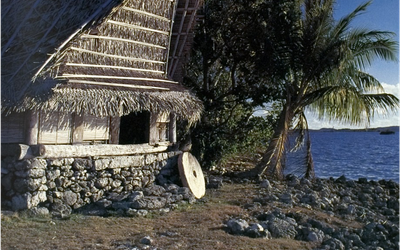
The lecture starts by defining indigenous and then focuses on the architecture of the legally recognized Taiwanese tribes. It then shifts to an overview of Taiwanese Indigenous architecture with a focus on existing, preserved sites of Kucapugane and Lanyu. Taiwan’s spatial history is complex. It merges an assortment of architectural styles. The architectural footprint of Taiwan is informed by indigenous communities as well as colonial influences of China, Japan, and Europe. … continue reading
supporting documents: • Quiz with Answers • Handout • Lecture Notes

Human societies and individuals have been consuming alcoholic intoxicants throughout human history for a multitude of reasons including social, cultural, and nutritional benefits – perceived or factual. Humans consume intoxicating drinks like beer, wine, and spirits that have the capability to alter their moods and the status of their minds in a wide array of locations and situations that are not limited by geography, time period, or language. This broad human experience und… continue reading
Lecture 1 provides an overview of the structure of the module and an introduction to its main themes and concepts. The lecture then offers a broad overview of the early histories of alcohol production and consumption with an emphasis on the connections between communities and cultures. Brief case studies then follow of alcohol use in the Near East, Eastern Asia, Southeast Asia, Africa, and South America as well as Europe. These case studies will bring up specific fermented l…
supporting documents: • Handout • Lecture Notes
In the previous lecture we looked at the various alcoholic beverages that emerged across the world in different communities based upon available sources of fermentable sugars including cereals and fruits. This lecture examines the spaces and places of alcohol use and the cultural and social reasons for imbibing in communal areas. Lecture 2 focuses primarily on the practice of feasting and the reasons and spaces many cultures have performed them.
supporting documents: • Lecture Notes • Handout
Lecture 3 builds on the themes of feasting while concentrating on religious events and locations surrounding the production and consumption of alcohol. Areas that will be considered are ancient Babylon and Egypt when looking at how ritual and religion became tied closely to the ingestion of alcohol. In addition, this lecture will touch upon the spread of specific perceptions of alcohol through cross-cultural connections – including religion and ritual. The lecture will look …
supporting documents: • Lecture Notes • Handout
While the previous two lectures have focused on more formal settings for alcohol production and consumption, this lecture focuses on the more community-oriented areas of taverns and pubs both as sites of community but also sites of social, political, and cultural importance in Europe and Colonial America.
supporting documents: • Lecture Notes • Handout

This course approaches architecture as a form of knowledge like cinema, literature, or history. Except unlike these other mediums, it is both aesthetic, intellectual, spatial and material. It is both haptic and contemplative. Architecture defines who we are. It is a potent tool for the construction of gender identities, class, self and the other. It helps internalize religious beliefs, political ideologies, and all sorts of power relations. Just think of the organization… continue reading
Mrinalini Rajagopalan, Itohan Osayimwese, Peter H Christensen, Shundana Yusaf
supporting documents: • Syllabus • Syllabus
Global architectural histories undermine the spurious mythologies of race, nationalism, and ethnicity often at the heart of political conflict. They illustrate architectural objects while locally manifested, are invariably impacted, manipulated, or redefined by global vectors such as technologies that travel across space and time. These technologies provide students with critical knowledge and skills to understand their built environment as situated within wider networks …
supporting documents: • Lecture Notes
This lecture focuses on how architecture and landscape have functioned in oral societies. For this we roam not the world but instead concentrate on different people of the Colorado Plateau in the Four Corners area in Western United States (at the intersection of the states of Utah, Colorado, New Mexico, and Arizona). Oral societies have created a different system of knowledge than literate societies; they do not see the nature-culture, and epistemic-technic divide at the h…
supporting documents: • Bibliography • Handout • Quiz • Lecture Notes • Lecture Abstract
This lecture presents some of the key ways in which early boats and ships have influenced architecture and organization of space starting some 3000 BCE. Boats and ships are the oldest and most enduring technology of globalization. They not only facilitated repeated attempts of people to spread out of Africa. They produced new type of urban centers, port cities / exchange hubs, trading centers, special building typologies like warehouses and shoreline factories designed espec…
supporting documents: • Lecture Abstract • Bibliography • Handout • Quiz with Answers
The lecture today looks at horse and camel as vital technologies of globalization. The transformation of camel from a food and textile source to a draft and saddle animal, likewise, the re-envisioning of horse beyond a source of meat, bones and skin into riding animals turned them from food and things into technologies. They introduced easier ways of traversing and living in inhospitable climates. Camels brought the ability to carry goods while horses brought speed to trave…
supporting documents: • Quiz • Lecture Notes • Handout
The role of the wheel in architecture stretches from 3500 BCE when it was first invented, to the present. In fact, many of the future lectures such as the printing press, railways, elevator, automobile, subways, roads II, tourism, airplane, even the computer and the internet are not possible without the invention of the wheel. This lecture however focuses on the impact of the early wheel on architectural expression. Advances in wheel technology were slow; the first wheels we…
supporting documents: • Bibliography • Lecture Abstract • Handout • Quiz with Answers
This lecture argues that architectural forms were significantly impacted by the proliferation of road networks in the pre-modern world. Specifically three types of impact can be observed across the 5 case-studies: Changes in built form: 1) The expansion of empires along road networks precipitated the standardization and replication of certain built forms in order to create a homogenous visual order in the empire as well as provide infrastructure for the imperial subjects…
supporting documents: • Quiz • Lecture Notes • Handout
Traditional wisdom holds the wheel to be one of mankind’s cleverest inventions and the camel to be one of God’s clumsiest. But from 200-600 CE camel cultures came to dominate the world scene. The invention of Southern Arabian saddle extended possibilities for herders by also making them into trekkers and merchants. The corollary was the monopoly of land trade by camel cultures without dependence on older infrastructure of imperial Roman roads. This reversed the socio economi…
supporting documents: • Bibliography • Lecture Abstract • Quiz with Answers • Handout
This lecture examines the interrelationship between mapmaking technologies and architecture through the lens of three themes: 1. Pictographic vs. chorographic representations of architecture, 2. The measurement and locative functions of architecture, 3. Architecture and its relationship to topography. The first theme explores how pictographic mapping of architecture tended to represent its symbolic function and likened architecture to writing and thus the built environment a…
supporting documents: • Bibliography • Handout • Quiz with Answers
The case-studies in this lecture will investigate how miniatures, souvenirs, and replicas work as architectural technologies of communication and movement. The objects under investigation here all point to movement and or transportation in some form or the other. Contrary to the primary function of architecture as an inhabitable space or form of shelter, miniatures and souvenirs are often scaled down versions of an original that are used as fetishes or objects of sentimental…
supporting documents: • Bibliography • Lecture Abstract • Handout • Quiz with Answers
For much of human history, festivals, ceremonies, rituals, and other modes of spectacle have served as powerful media to create and communicate collective and individual identities. These festivals have taken on a variety of forms—from official spectacles to unsanctioned, subversive performances, religious ceremonies to events with a commercial character, occasions that rallied the masses to smaller, more selective affairs, regular to occasional and pop-up episodes. Neverthe…
supporting documents: • Handout • Lecture Notes • Quiz • Bibliography • Lecture Abstract
Two main types of structures associated with Buddhism—the vihara (place of congregation and idol worship) and the stupa (reliquary). Stupa is a place for the storage and veneration of relics associated with the Buddha’s and his disciples bodies. Rituals such as circumambulation define structures such as the stupa. Relics (such as miniature models of the Mahaboddhi temple) proliferate throughout the medieval Buddhist world. Xuanzang travels to India in the 7th cen. to find th…
supporting documents: • Quiz • Lecture Notes • Handout
Architecture has long acted as a form of timekeeping, though what constituted time and how it was defined across history and cultures varies greatly. Contrary to our contemporary relationship with time as precisely measureable and something that individuals can control; historic communities had a more reverential attitude to time. This is seen in the sacred rituals practiced within and around architecture that also told of the movement of stars and the passing of seasons. Th…
supporting documents: • Lecture Abstract • Bibliography • Handout • Quiz with Answers
This lecture covers prehistory to the present, demonstrating the enduring and fundamental scope of infrastructure in the construction of society. Projects also cover a wide geography, demonstrating the universal significance of infrastructure. What, exactly, is infrastructure? Common definition is “The basic physical and organizational structures and facilities needed for the operation of a society of enterprise.” (Merriam Webster) This thusly draws a distinction be…
supporting documents: • Quiz • Handout • Lecture Notes
Historians tend to think of human history in terms of major events and famous personalities happening in kingdoms and nation-states--that is in land-bound terms. But as Carl Schmitt, pointed out, some of the most important developments have been connected with the sea and evolving technologies for traversing it and exploiting its resources. In our Ship I lecture, we looked at the ship as a technical and aesthetic object in ancient cultures like Haida, Minoa, and Egypt. We…
supporting documents: • Quiz • Handout • Lecture Notes
This lecture is a comparative study between two types of architectural models: the small scale bure kalou (spirit houses) of the Fijian people and Fillipo Brunelleschi’s proposals for the dome of the Santa Maria Novella in Florence Italy (Duomo from now on). These two case-studies were specifically chosen to complicate the contemporary definition of an architectural model as a three-dimensional representation of a building created by a designer in order to communicate his/ h…
supporting documents: • Handout • Quiz with Answers • Bibliography • Lecture Abstract
This lecture offers a comparison between two architectural treatises: one written in medieval China and the other in Renaissance Europe. While neither of these were the first architectural treatises of their respective languages or cultures, they were amongst the earliest to be printed and widely published thereby making them widely known to audiences within and abroad. What is being examined in this lecture then, is the particular intersection of a technology of communicati…
supporting documents: • Quiz with Answers • Lecture Abstract • Handout
This lecture considers some of the different modes in which architectural knowledge has circulated since the fifteenth century. Today, in our contemporary context where rapid and economical reproductive technologies are available to many people, we have come to think of written texts and photographic images as the primary means through which architectural knowledge circulates. If we consider the period before printed works were widely available, the architects themselves can…
supporting documents: • Lecture Abstract • Bibliography • Handout • Quiz with Answers

The course is an exploration of the evolution of space and the architecture of peoples in Eastern Africa and it contribution to contemporary urbanism. It identifies the early precedents from antiquity based on literature and archival information. Further, the early precedence uses existing examples of vernacular spatial practices epitomised in the architecture and built environment per se. The scale ranges from the micro-level unit of dwelling, village organization, a conglo… continue reading
Although human habitation in Eastern Africa dates back to the 1st Millennium, urbanization was later. The earliest settlements were thus dispersed that were later densified culminating into urban formations interrogated here. This background is used to illustrate how spatial paradigms of antiquity informed subsequent developments and contemporary urbanism. The overarching themes used to understand the architecture of urbanism in Eastern Africa shall include: the Physical, …
supporting documents: • Handout • Lecture Notes • Quiz with Answers
Although human habitation in Eastern Africa dates back to the 1st Millennium, urbanization was later. The earliest settlements were thus dispersed that were later densified culminating into urban formations interrogated here. This background is used to illustrate how spatial paradigms of antiquity informed subsequent developments and contemporary urbanism. The overarching themes used to understand the architecture of urbanism in Eastern Africa shall include: the Physical, Id…
supporting documents: • Handout • Lecture Notes • Quiz with Answers
Lecture 3, in turn focusses Public space. Public space is considered as commercial and civic space, a concept that gains prominence in the colonial city but with anecdotal references in the Zamani era. What emerges is that private and public domains were fused prior to the modernization of the colonial city in the region. Trade, for instance, is through barter contracts that easily migrate between social and economic domains in the Zamani era. Such transactions were easily w…
supporting documents: • Handout • Lecture Notes • Quiz with Answers
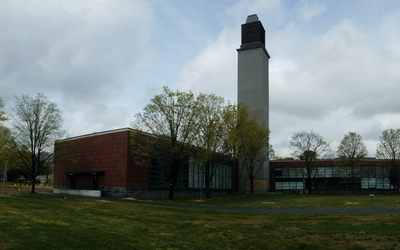
Named for the editor of the Pittsburgh Courier, one of mid-century America’s leading African American newspapers, the Robert L. Vann Tower of the Belgian Friendship Building rises substantially higher than any of the Confederate statues on Richmond, Virginia’s nearly Monument Avenue ever did. Although prominent on the city’s skyline, the Belgian Friendship Building has been overlooked in histories of the importation of European modern architecture into the United States, a… continue reading
Named for the editor of the Pittsburgh Courier, one of mid-century America’s leading African American newspapers, the Robert L. Vann Tower of the Belgian Friendship Building rises substantially higher than any of the Confederate statues on Richmond, Virginia’s nearly Monument Avenue ever did. Although prominent on the city’s skyline, the Belgian Friendship Building has been overlooked in histories of the importation of European modern architecture into the United States, a…
supporting documents: • Handout • Quiz with Answers • Lecture Notes

By outlining the expression of Water or Hydraulic Civilization, its meanings and functions, this module introduces the relationships between human civilization and water resources. Among ancient civilizations, the role played by Persia in the invention and dissemination of water architecture knowledge is widely recognized. Yet even if Persia has long been regarded as an important cradle for the development of irrigation and other water works, few systematic studies have been… continue reading
This lecture introduces the geography of Persian water architecture and its relations to other parts of the ancient world. It focuses on the water architecture legacies inherited from Persia, from technological aspects of water control and management in ancient times to their diffusion and exchange routes with neighouring and more remote civilisations, from China to Spain, from Egypt to India. Early irrigation models are studied, as well as the way their implementation shape…
supporting documents: • Quiz with Answers • Handout • Lecture Notes
Water and its related natural elements such as spring, river, and lake were sacred substances for Iranians over the centuries. The spiritual and mythological position of water in the ancient Persia, established a particular architectural typology related to water in this region. This lecture focuses on the architectural spaces corresponded to this mystique facet of water in Persia, puts the light into the particular architectural interventions and space making related to t…
supporting documents: • Handout • Lecture Notes • Quiz with Answers
Water architecture in Persia consists of various types of buildings and edifices. Particular structures with various functions related to the hydraulic systems or other public, semi-public functions benefit from water. This lecture focuses on the integration between water and architecture in the public facilities in the Persian Plateau, structures directly related to the hydraulic systems with the function of contorting or preserving water, or buildings/spaces designed in …
supporting documents: • Quiz with Answers • Lecture Notes • Handout
Water architecture in Persia consists of various types of buildings and edifices. In addition to the urban or public facilities, water played an important role in the private life and individual spaces in Persia. Iranian courtyard houses, as well as gardens’ pavilions and palaces during the Islamic period, displayed a combination of functional and recreational aspects of water architecture. The integration between water, architecture and garden was the common aspect of water…
supporting documents: • Lecture Notes • Handout • Quiz with Answers
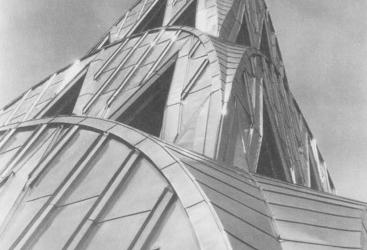
The first lecture is based on the assumption that Art Deco offers a unique lens into the globalizing processes and networks along which architects, objects, and ideas circulated. Lecture 1 proposes that the circulation, development, and consumption of Art Deco objects, buildings, films, and art works represents an unprecedented compression of space and time. Art Deco architects freely borrowed and mixed motifs, forms, and visual cues from architectures and material cultu… continue reading
This lecture is based on the assumption that Art Deco offers a unique lens into the globalizing processes and networks along which architects, objects, and ideas circulated. This lecture proposes that the circulation, development, and consumption of Art Deco objects, buildings, films, and art works represents an unprecedented compression of space and time. Art Deco architects freely borrowed and mixed motifs, forms, and visual cues from architectures and material culture…
supporting documents: • Lecture Notes • Handout
This lecture examines Art Deco in Miami and Mumbai. These two cities have been chosen as case studies for their unique status. These case studies were chosen because: The Art Deco buildings that came up in Miami and Bombay (renamed Mumbai on 1995) in 1930s and 1940s combined decorative aspects of the pre-depression Art Deco and the post-depression architecture of the streamlined moderne. The two cities of Miami and Bombay have a large concentration of this kind of Art De…
supporting documents: • Handout • Lecture Notes

“[The inhabitants of the northern territories] are unacquainted with the use of mortar and tiles; and for every purpose employ rude unshaped timber, fashioned with no regard to pleasing the eye.” Tacitus (1st c CE), Germania. Since Antiquity, wooden buildings have been perceived as a primitive form of construction, ranking second to the enduring architecture of stone. Although until recently, woods was the main construction material in the vast forest regions of north an… continue reading
Until the 20th century, wood was the dominant construction material in Russia, and a vast and rich building tradition developed around its use. This lecture examines the buildings of the region of Karelia, in northwestern Russia, as outstanding examples of the architecture of medieval and post-medieval Orthodox settlements in sparsely populated regions. Peasant communities united by economic, social and family ties and coping with a harsh climate made parish churches the cen…
supporting documents: • Lecture Notes
Stave churches are a rare group of very early wooden buildings, many from the 12th to the 14th centuries. Once widespread, most surviving stave churches are now in Norway. Stave churches date back to the Christianization period of Norway and blend native Viking culture and Christian elements. Their physical durability derived from a close relationship to the landscape and climate, while their endurance as a building type can be partly explained by the geographical and cultu…
supporting documents: • Lecture Notes
This module presents examples of wood architecture that challenge both assumptions of a lack of aesthetic concern and ephemerality of construction. Indeed, some of them, like the Norwegian Stave churches, date back to the Middle-Ages. The examples are chosen from three regions: Norway, northwestern Russia (the Kola peninsula and the republic of Karelia), and the northern Romanian region of Maramureș. The first two territories are adjacent and share a common history of Chr…
supporting documents: • Lecture Notes
Work, Slums, Housing and the Architecture of the Modern City: Challenges and Alternatives to House the Poor in the Developing World
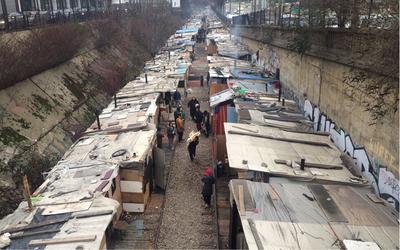
The series of lectures offers a didactic divulgation of the findings of a decennial research performed by the author in the informal settlements of Brazil (favelas), aimed at investigating the spatial genesis of the social needs of the underprivileged people living in informal settlements (Cavalcanti, 2017; Cavalcanti 2018b). The research has discovered that the working activities of the residents are the primary shapers of space in informal settlements (Cavalcanti, 2017,… continue reading
Lecture 1 addresses a long history of slum housing in 18th and 19th century England, 20th century France, and 19th century U.S., as a frame to explain the development of favelas in Brazil from the 17th century to the present. This first lecture tackles the broad theme of urban poverty with particular reference to slums and favelas. The lecture mainly focuses on both the traditional historiography, interpretation and the philosophy of knowledge of slums. Firstly, we will l…
supporting documents: • Lecture Notes • Handout • Quiz with Answers
Lecture 2 focuses on the contemporary challenges of favelas in Brazil, its inhabitants, and housing as right. This second lecture explores a new epistemology and a new definition for slums and favelas based on the labour of its residents. The lecture begins by analysing the failures of the current planning and design strategies to house residents living in informal settlements, through several case studies. Such projects often suffer a ‘mischaracterization’ employed by…
supporting documents: • Handout • Quiz with Answers • Lecture Notes
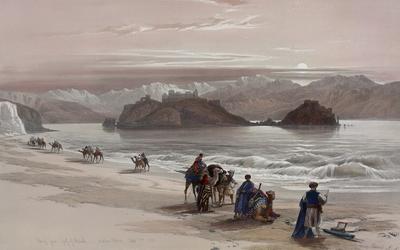
This module of lectures is tracing Medieval History following the journeys and records of history’s most important travellers of the time: Ibn Battuta, Marco Polo and Zheng He. The cities that they encompassed along the silk roads towards the East were riveting centers of cultural, commercial and religious activities. While some of these cities have become today cosmopolitan mega-cities, some others only lay in ruins with little to no standing architectural elements of their… continue reading
The structure of the lecture focuses on eleven cities of the Arabian relating to the three travellers Marco Polo, Zheng He and Ibn Battuta and which were flourishing cultural and commercial centers of the Medieval era. Namely, these cities were the holy cities of Islam in the Western coast of the peninsula: Jeddah, Mecca and Medina; the cities of the Najd plateau and the Persian Gulf (Hofuf, Riyadh, and Bahrain); and the cities in the southern part of the peninsula, in what …
supporting documents: • Lecture Notes • Handout • Quiz with Answers
The structure of the lecture focuses on six cities of the Indian subcontinent relating to the three travellers Marco Polo, Zheng He and Ibn Battuta and which were flourishing cultural and commercial centers of the Medieval era along the Silk Roads connecting the greater Eurasian continent. The module focuses on port-cities along the Western coast of India, bordering the Arabian sea and thriving trade centers before their colonization by European powers. Namely, these cities …
supporting documents: • Lecture Notes • Quiz with Answers • Handout
The structure of the lecture focuses on six cities of the greater area of Persia relating to the three travellers Marco Polo, Zheng He and Ibn Battuta and which were flourishing cultural and commercial centers of the Medieval era. The lecture begins with the main cities of mainland Persia, including the traditional Imperial capitals of Isfahan, Shiraz and Yaz. Kerman, on the other hand was the capital of khanates and kingdoms of the southeastern dessert plain. While on the n…
supporting documents: • Handout • Lecture Notes • Quiz with Answers
This content has been added to your bundle, . View your bundles.




